It seems we can’t find what you’re looking for. Perhaps searching can help.
Sign Up for newsletter!
Subscribe to get the latest eBook!
Hotline


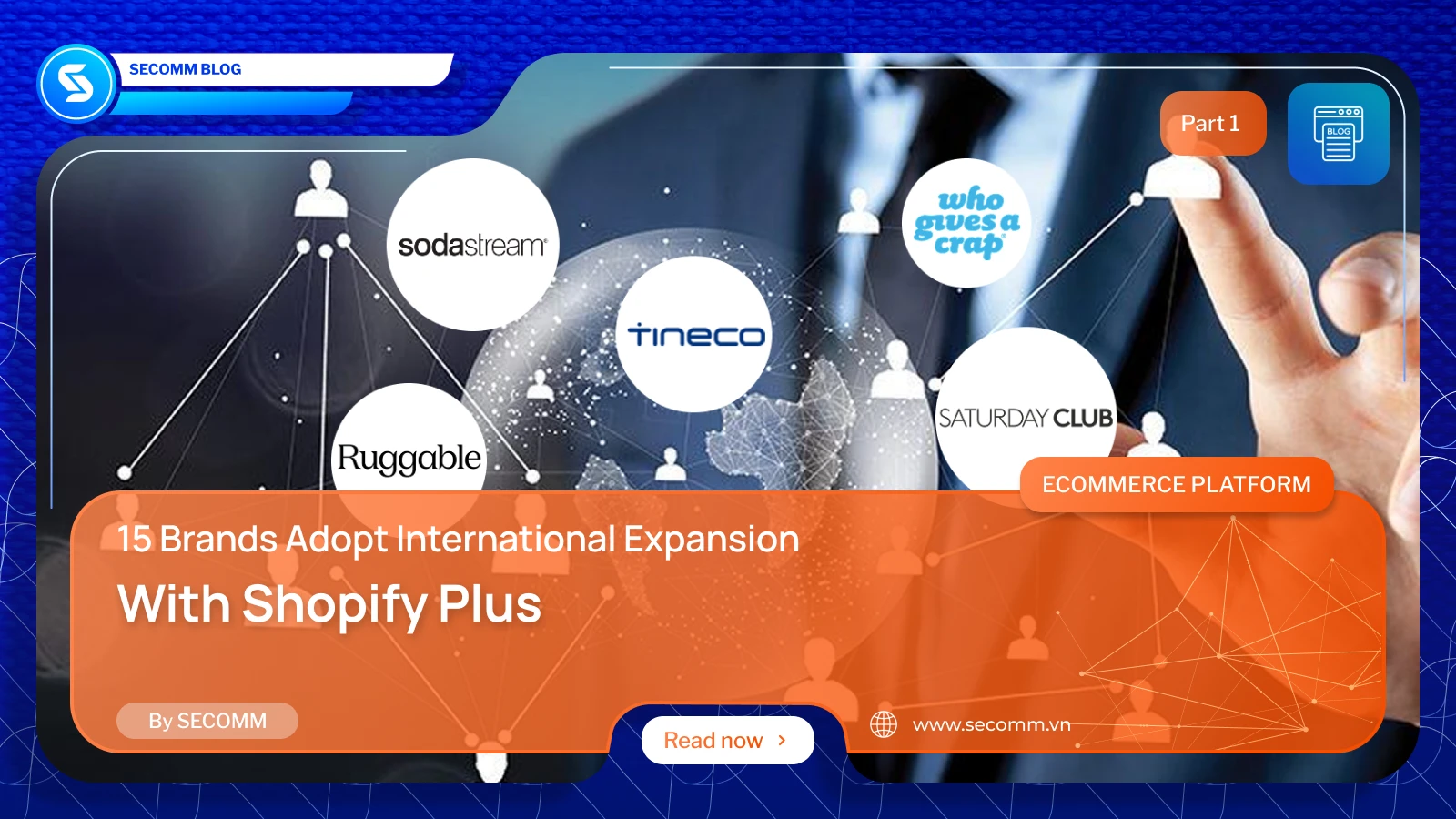
 2
2
 3,061
3,061
 0
0
 1
1
 2
2
 10,639
10,639
 0
0
 1
1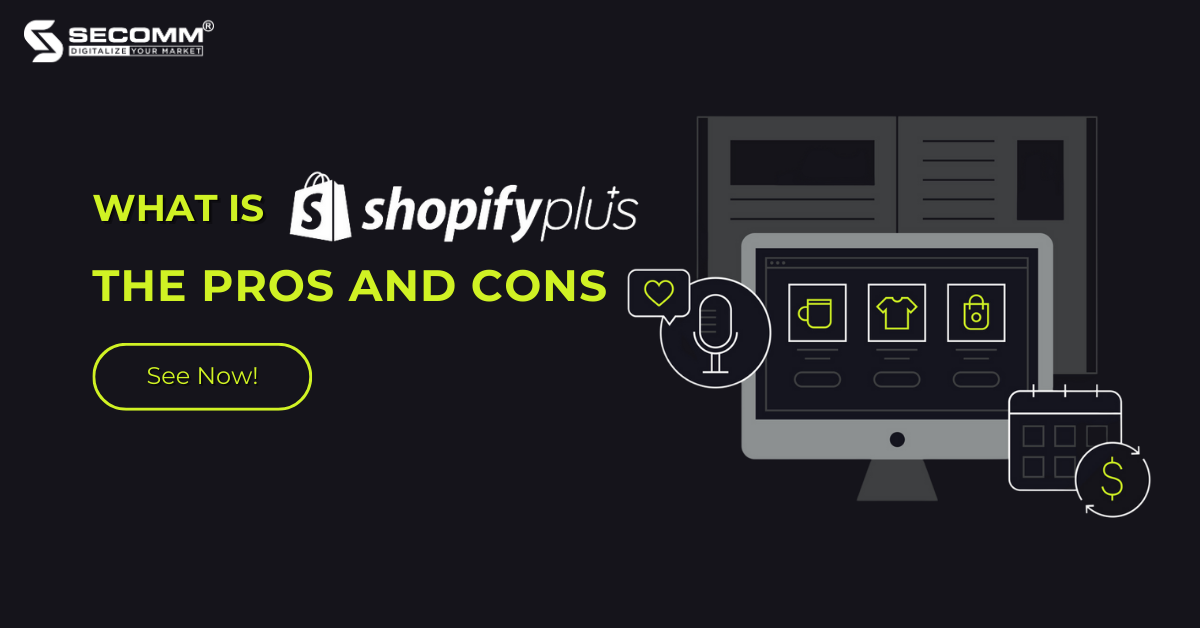
 2
2
 10,635
10,635
 1
1
 1
1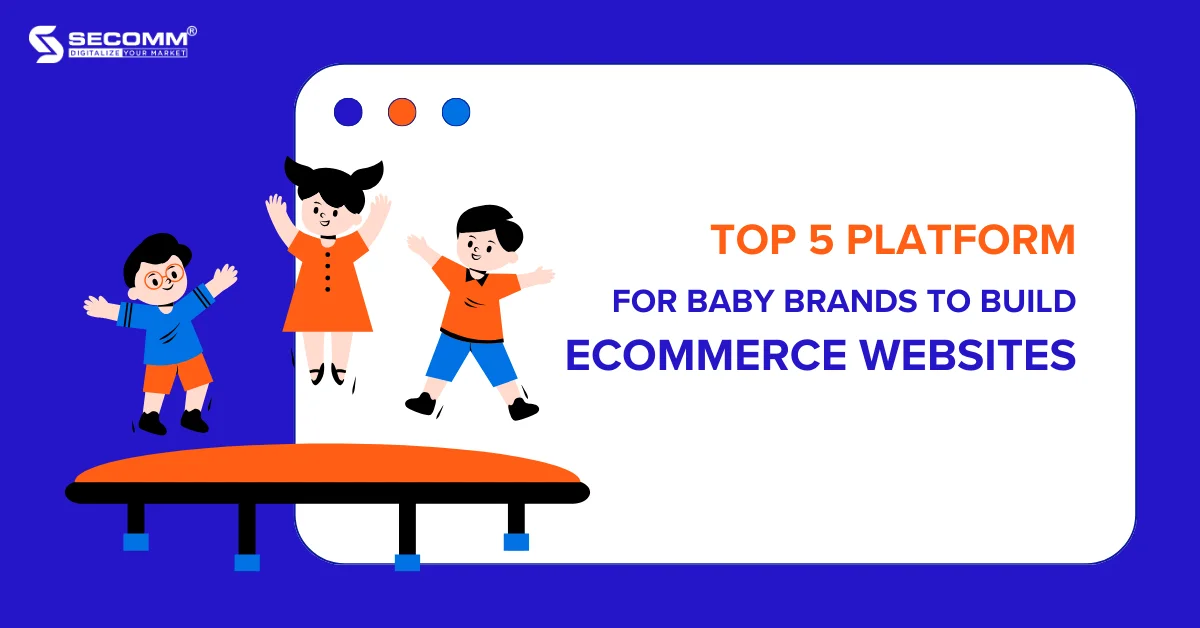
 2
2
 10,635
10,635
 0
0
 1
1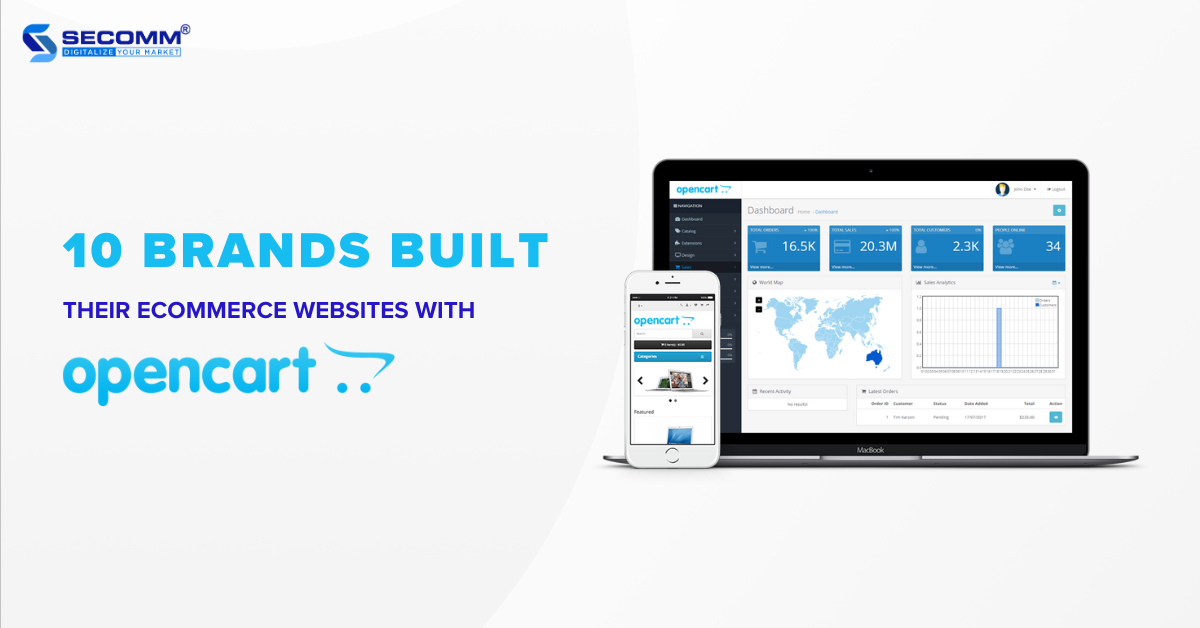
 2
2
 10,472
10,472
 0
0
 1
1



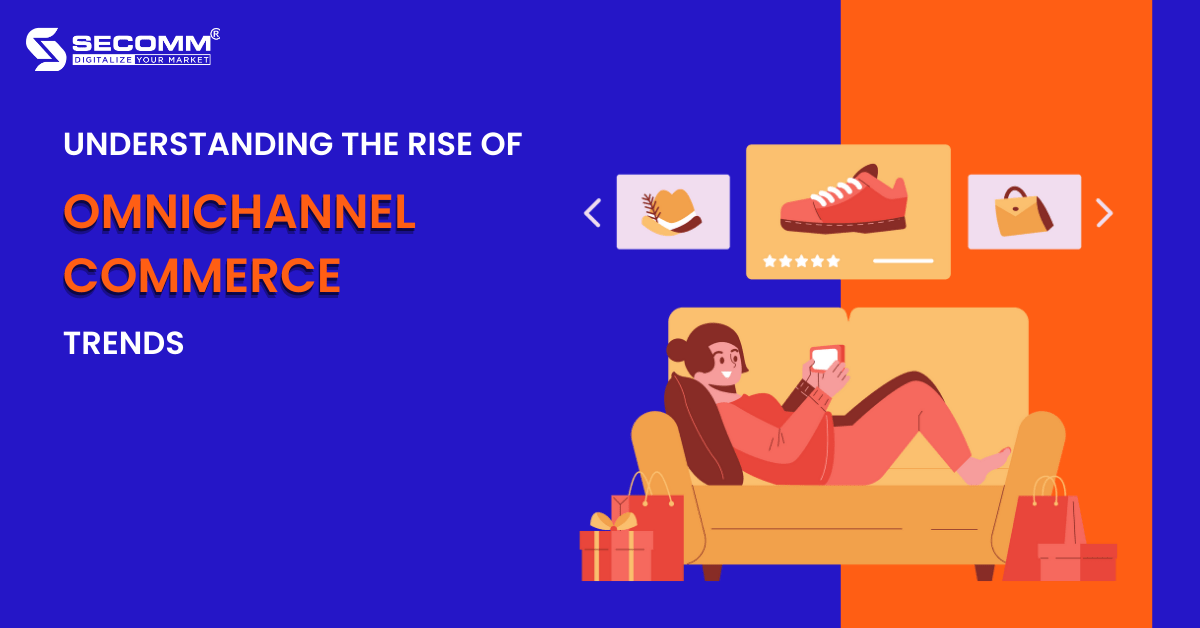
We are living in a world where the younger generation has taken the lead in setting ever-rising standards for digital experience. So, it’s important for businesses to quickly adapt to new trends for sustainable development to keep up with the shift.
Especially during a global pandemic, eCommerce has become one of the top priorities of every business owner. In order to thrive in a rapidly changing market and keep customers loyal, brick-and-mortar businesses have had to build an online presence and increase their eCommerce capabilities.
The term “Omnichannel Commerce” is defined as a “trend” that helps businesses achieve the aforementioned objectives and this trend is expected to continue to accelerate in the coming years.
Omnichannel Commerce is a multichannel approach that focuses on offering a seamless shopping experience by marketing and selling across all channels where potential customers are present including mobile devices, social networks, eCommerce websites, and brick-and-mortar stores.
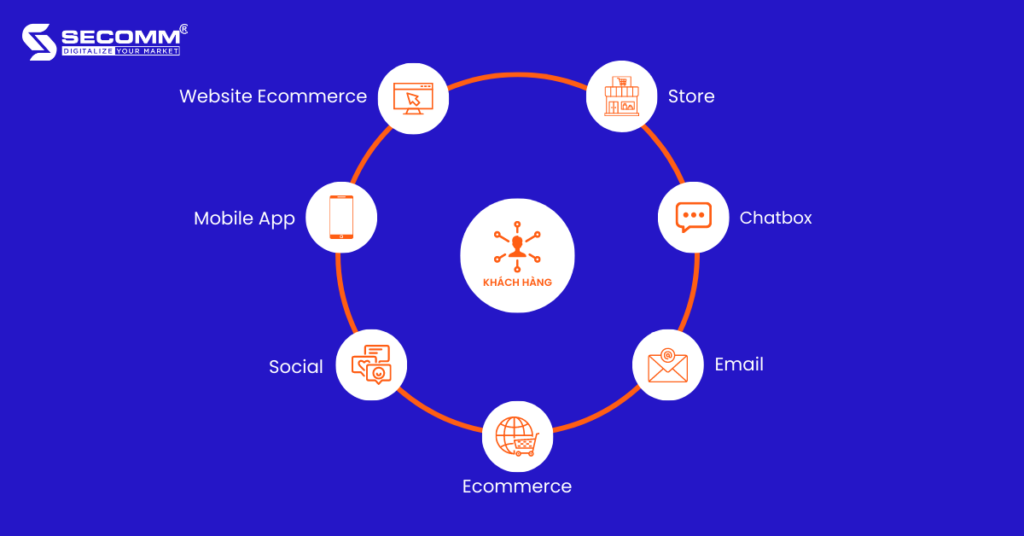
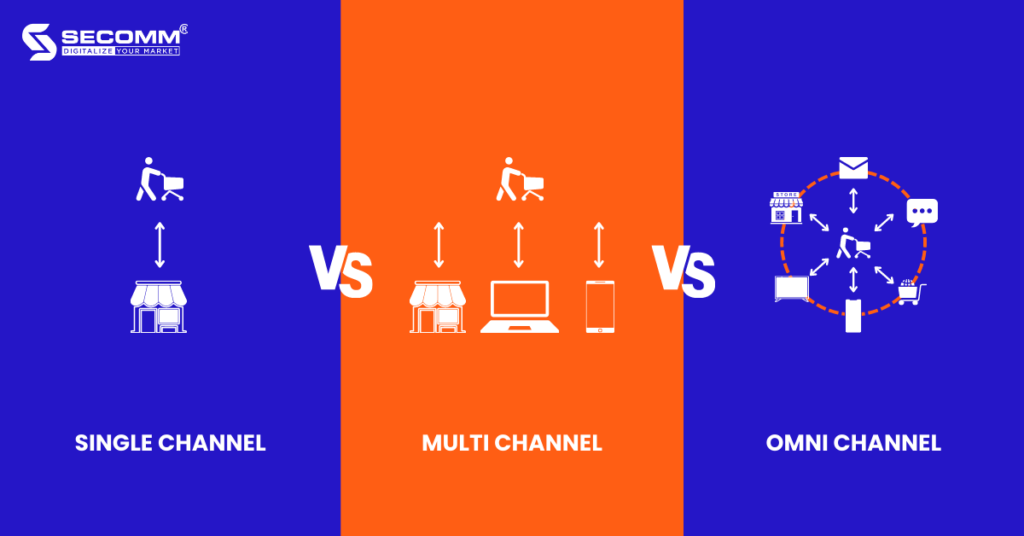
When a company sells its products or services only through one channel, that approach is known as single-channel commerce. It could be a physical store, an eCommerce website, or a marketplace like Shopee, Lazada, Tiki, etc.
Selling through a single channel could initially be quite successful, but if businesses desire to provide their customers with a richer shopping experience and increase brand awareness, they need to add multiple channels to showcase and sell their products or services.
When it comes to the Multichannel Commerce strategy, businesses will interact with customers and sell their products through both online and offline channels. This strategy makes use of touchpoints where customers can perform the same action at any available channel. These touchpoints, however, are independent and barely or not at all connected among channels. For example, a physical store with an eCommerce website has no inventory-sharing function.
Similar to Multichannel Commerce, Omnichannel Commerce enables a company’s marketing and sales efforts to be spread across numerous channels. The main distinction is that Omnichannel Commerce prioritizes the customer, connects all touchpoints, and creates a unified buying experience. But, Multichannel Commerce aims to reach as many channels as possible, with unique content for each and customers will interact with brands through their preferred channels.
An effective Omnichannel Commerce strategy includes effective operations of each sales channel that will be integrated in a seamless and consistent manner. Touchpoints should provide a unique but connected experience based on previous interactions. That experience takes customers to the end of the customer journey to get the business’s objectives.
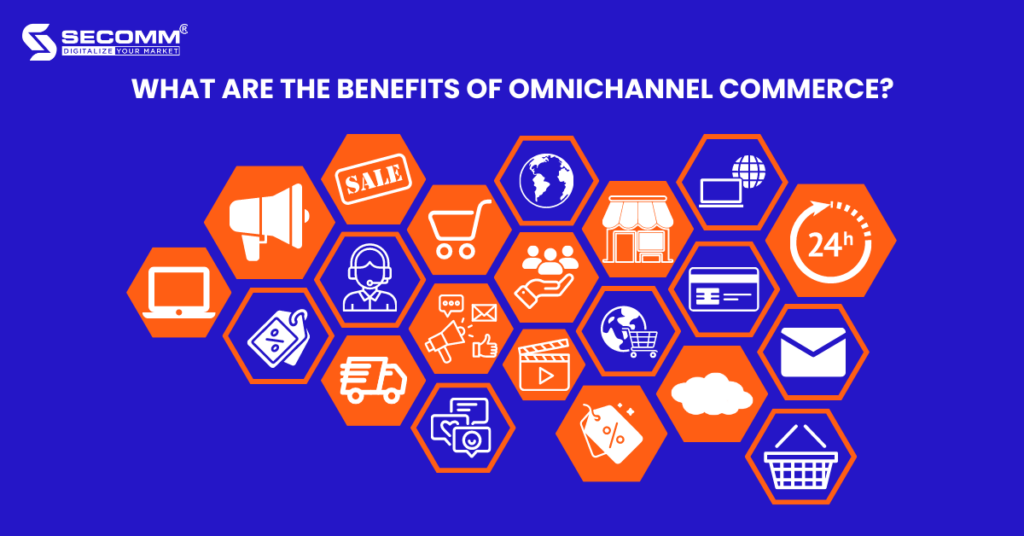
Imagine a man who wanted to buy a new washing machine. After seeing an attractive TVC with the merchant’s information, he used his laptop to begin searching on the Internet. He discovered the merchant’s eCommerce website, and his desired product is offered at a local physical store. He decided to add that product to his shopping cart after chatting with the customer service team.
He downloaded the merchant’s app, signed into his account, and accessed his cart before heading to the store because he wanted to see and check that washing machine in person before making a purchase. He checked the app to ensure the item is still in stock, its quantity, the best payment method, and any associated special offers.
When he arrived, he checked the product’s quality and checked out with the QR Code. The transaction is finished. Under the CRM system, his information and data would be saved for upcoming marketing campaigns and post-sale efforts.
Nowadays, consumers receive a ton of offers and messages from many brands day after day. This brings up many considerations when choosing a brand to engage with. Developing an Omnichannel strategy to connect with customers in a seamless manner across multiple channels will set a brand apart from the competition.
Omnichannel Commerce is a customer-centric model, connecting touchpoints and providing personalized experiences. This contributes to the company’s revenue increase as expected with cross-sell and up-sell opportunities.
Also, the branding strategy will be effective and successful, enhancing customer loyalty as well as the brand message will reach the right target audience thanks to the consistency of the Omnichannel Commerce model. It’s not only useful for increasing customer engagement but also for customer data evaluation.
Thus, businesses will have a bigger picture of the customer journey, the times and channels customers usually interact with, as well as the most effective and valuable marketing campaigns. All this data needs to be meticulously analyzed and reused in the next marketing campaigns.
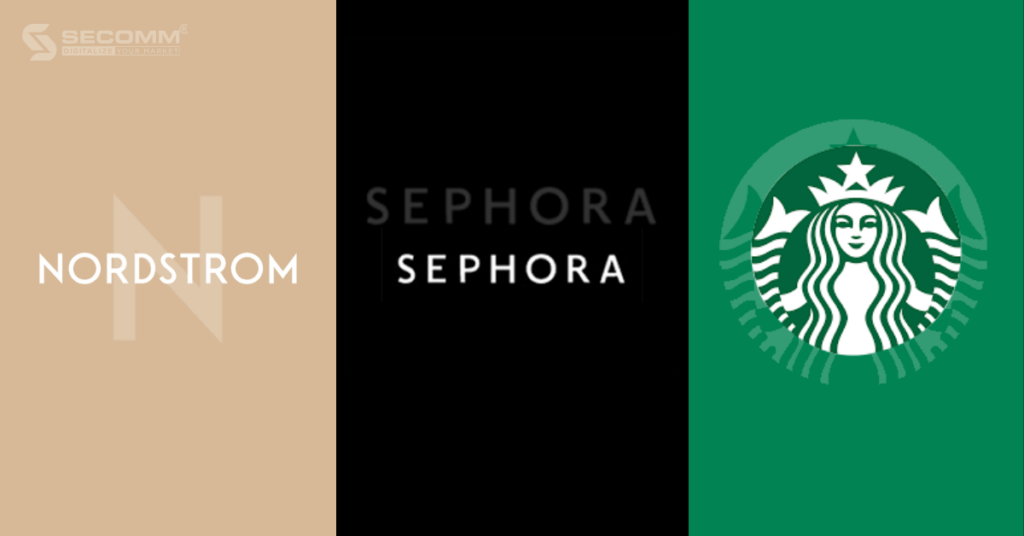
Omnichannel Commerce has long been a strength for Nordstrom. They created the Pincode feature that allows customers to use their smartphone to scan and access Pinterest to get a $100 Nordstrom giveaway while in the store. The brand also showcases in the store Pinterest’s best-selling products as an interesting suggestion.
In addition to Pinterest, it uses Youtube to create video tutorials for matching outfits and suggests its customers go to the physical store to meet a professional. At the store, they will receive valuable advice that may lead to a purchase decision.
Recently, Nordstrom has leveraged Instagram’s shoppable posts to inspire shopping and encourage customers to make quick decisions.
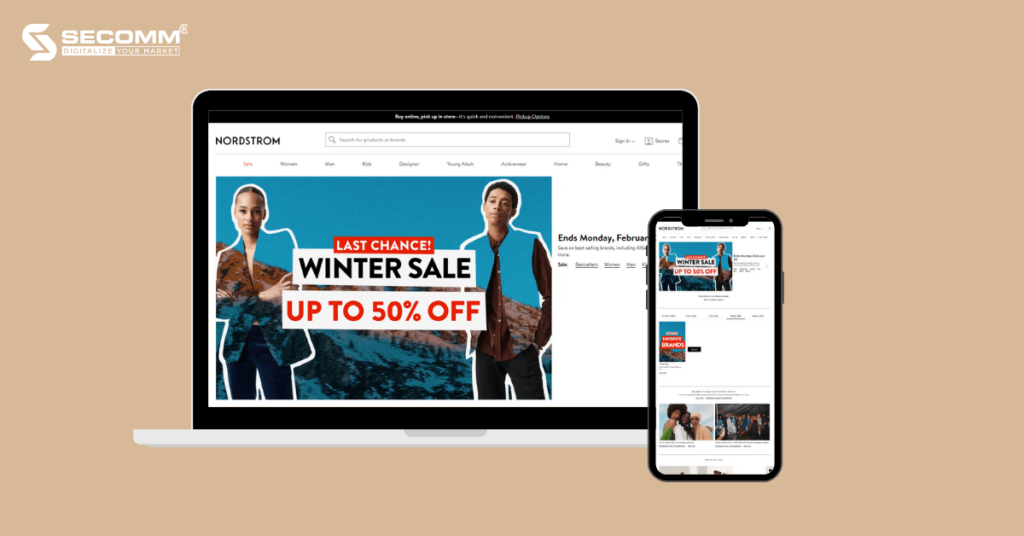
Sephora is one of the major brands in the beauty industry that is successful with Omnichannel Commerce. The company has established a strong connection between online and offline shopping experiences. Customers can access Sephora Beauty Bag’s personal account by using available tablets in its brick-and-mortar stores.
This account allows them to look up details of the items they are interested in and try them out using virtual reality. Additionally, Sephora’s benefits, like its in-store makeup tutorials and personalized gifts, have encouraged customers to make larger purchases.

The world-famous beverage brand – Starbucks has launched the Starbucks Rewards App which is considered the pinnacle of Omnichannel Commerce. After creating an account, Starbucks fans can find a list of local stores, order drinks, and pay in advance so they don’t have to wait in line.
The app also regularly makes personalized recommendations for each customer based on previous orders, loyalty programs, weather, holiday seasons, or local store inventory.
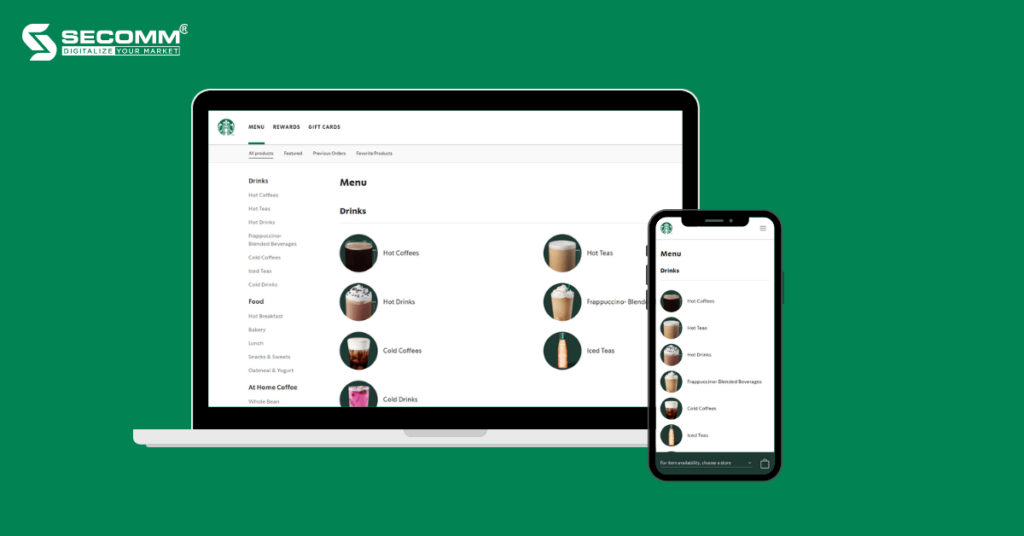
Keeping up with the ever-changing business world is not easy. In fact, many big brands in the world have implemented Omnichannel Commerce early and have achieved great success. Plus, many other businesses are tending to gradually shift from Single-channel or Multichannel to Omnichannel and recognize this model as a bridge connecting customer experience between online and offline channels in a seamless way.
With many years of experience in successfully implementing eCommerce for many customers in many countries, SECOMM understands the difficulties when doing an Omnichannel Commerce strategy.
Contact our expert now to get a free consultation.
 2
2
 4,106
4,106
 0
0
 1
1
The eCommerce industry has a sizable market share in the Vietnamese economy and has shown impressive growth over the past two years due to the effects of the worldwide pandemic and social isolation.
After a year of society adjusting to the “new normal”, customers have started to buy at traditional stores again but the established trend of eCommerce consumption and the push from the wave of global digital transformation have encouraged businesses to change in order to suit the way the digital economy works.
Therefore, recognizing and anticipating the eCommerce trend of 2023 is extremely necessary for businesses’ New Year’s Marketing strategies to be implemented effectively and successfully.
Below is a list of 10 eCommerce trends that are forecast to “storm” the market in the next year.
Omnichannel is an omnichannel sales model that helps businesses reach customers through many channels such as eCommerce websites, social networks, eCommerce platforms, chain stores, and distribution agents but operating in just one management system.
Additionally, there is a second type of sales model called “Multi-channel” that differs from Omnichannel in that it allows for discrete marketing content, unlinked data, and independent channel operation.
When purchasing across numerous channels, continuous and seamless updates result in a heterogeneous and seamless customer experience.

Due to the lifting of social distance restrictions, consumers are beginning to return to in-store buying after two years of online shopping.
However, that doesn’t mean that eCommerce’s growth momentum is stagnant; on the contrary, it keeps exploding.
Businesses there make use of the current rise in popularity of online shopping to encourage the use of Omnichannel to improve the varied and efficient shopping experience.
As researchers have noted:
As a result, 2023 will still be recognized as a strong year for omnichannel in eCommerce.
Mobile Commerce or mCommerce is a business model that allows companies and individuals to deliver goods and services directly to consumers through handheld wireless devices such as smartphones and tablets.
According to Bankmycell, the number of smartphone users worldwide in 2022 is 6.648 billion, equivalent to 83.07% of the world population owning a smartphone.
Moreover, it is predicted that this number will increase to 7,516 billion by 2026. In addition, the percentage of global users participating in online shopping in 2022 accounts for 58.4%.
In Vietnam alone, interesting figures are listed in the Vietnam eCommerce White Book in 2022:
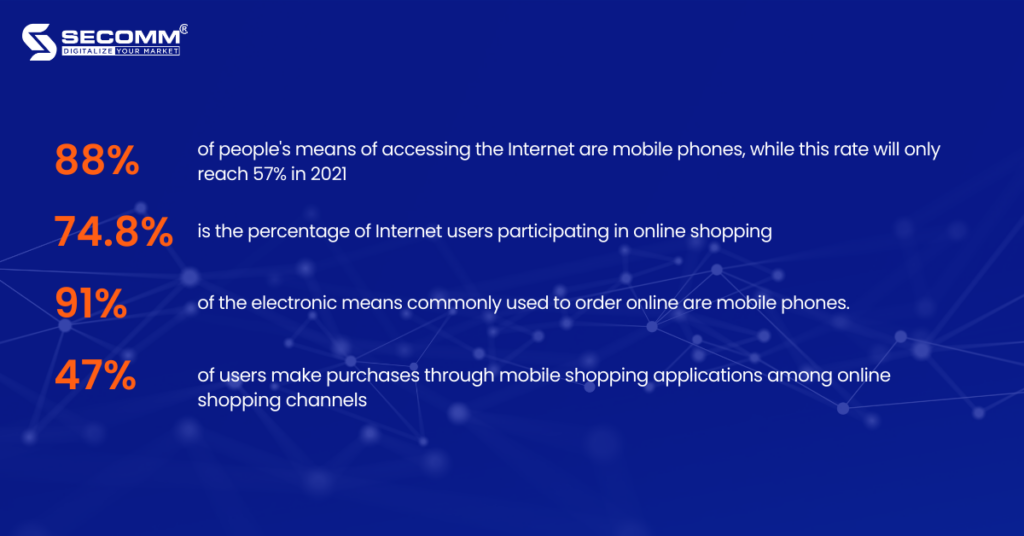
In upcoming years, the percentage of global people and Vietnamese people as well who own mobile devices and use them for online shopping is high and predicted to increase significantly.
Social commerce refers to the method through which companies advertise and sell goods and services online using social networking sites like Facebook, Instagram, TikTok, Youtube, Zalo, etc. In other words, this type of business combines eCommerce and social media.
The impact of social networks has grown significantly in recent years. Over 59% of the world’s population uses social media, it is not surprising that this percentage will continue to rise.
While in the past businesses used social media to raise brand awareness and draw in new customers, today eCommerce businesses boost sales by offering goods and services to clients online via social media.
As a result, it’s incredibly handy for customers to interact, exchange information, and search and shop online all in one location.
According to Statista, global social commerce sales will reach $992 billion in 2022 and are projected to reach nearly $3 trillion by 2026.

Thanks to the development of social networks, social commerce has had a strong acceleration and has become a magnet for brands to come to approach and analyze a large number of potential customers, and achieve marketing and sales goals.
As a result, failing to prioritize social commerce in enterprises’ marketing strategies in 2023 is probably to lead to a significant loss of competitive advantages in the eCommerce market.
Today, businesses have a lot of choices to build an eCommerce website, but basically, the structure of a website will include the following main parts:
For websites using a traditional structure, the frontend and backend will be operated on the same platform and from there will be closely connected with each other. Therefore, any changes on the website will be edited in two parts at the same time. However, with Headless Commerce, the backend and frontend will be decoupled from each other and operate independently on two separate systems.
The benefits of deploying Headless Commerce:
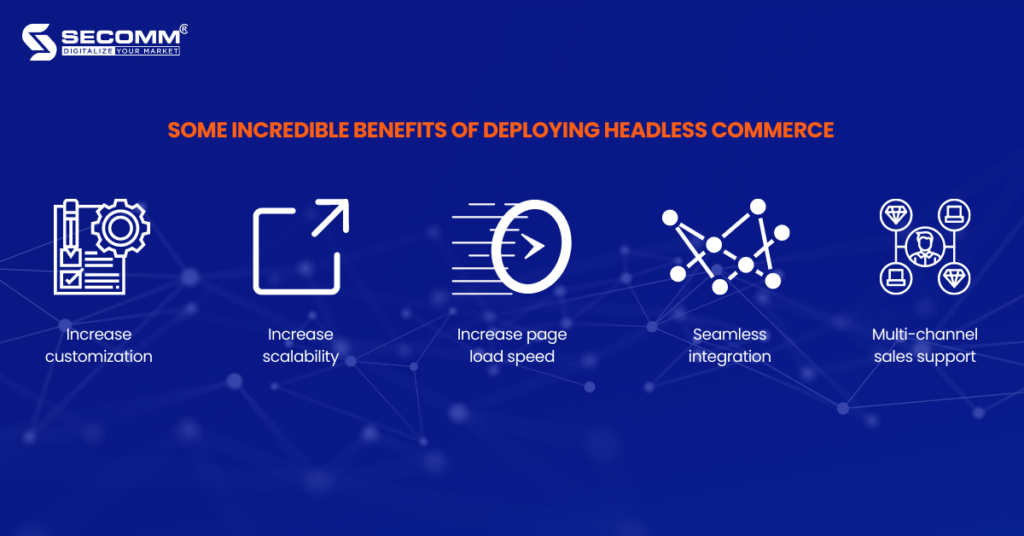
By using the Headless structure, Nike has become a brand with a much larger market share than Adidas – a formidable competitor of Nike.
Moreover, Nike’s website recorded more than 60 million pageviews in just 1 month. In addition, the proportion of direct purchases without intermediaries also increased significantly.
From Nike’s Case Study, one of the practical alternatives for companies looking to encourage eCommerce sales growth is Headless Commerce.
Shoppertainment is a form of shopping combined with entertainment that is used as a marketing strategy to encourage customer engagement with brands and consequently increase shopping demand. Moreover, it is used and takes over most of the online commerce in the era of digital transformation, when eCommerce is positioned at the forefront of contemporary business trends.
Some common practices of Shoppertainment trends:
These three practices all focus on entertainment and interaction. Then, the emotional element is aroused, leading to a series of unwise and unplanned shopping decisions. From a business perspective, this is beneficial for brands. TikTok‘s recent research proves it:
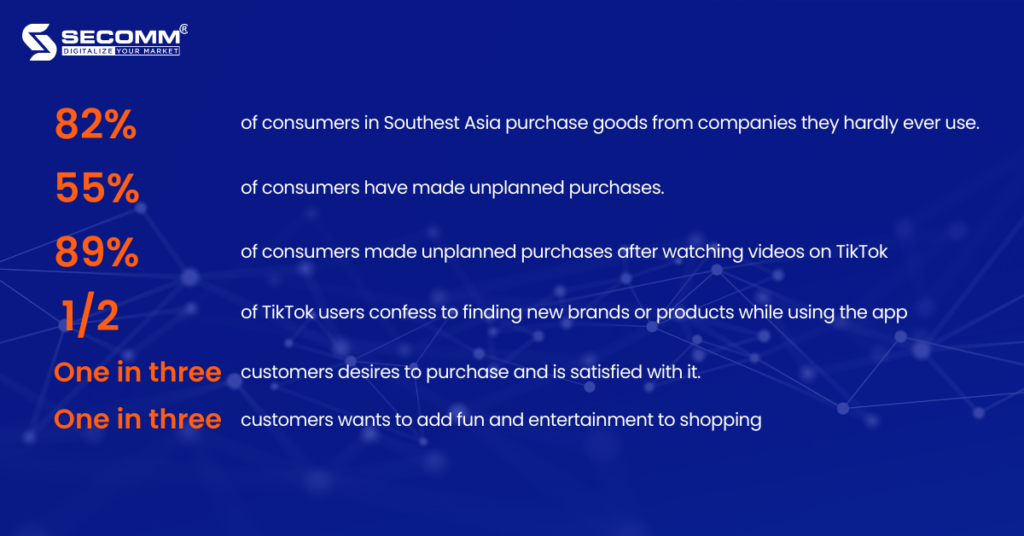
The growth of the Shoppertainment trend in recent years demonstrates the extreme demand for social interaction and connection following the period of Covid’s life.
Shoppertainment is the solution that businesses seek. This is a way to make the most of the customer’s biggest weakness – emotions.
When feelings of euphoria and joy are elicited during the shopping process, customers engage more, and purchase more unplanned products, conversion rates are higher, and sales follow.
Artificial intelligence now has a significant impact on eCommerce businesses in providing solutions to optimize the online shopping experience of customers.
The following statistics demonstrate the incredible influence of AI on the eCommerce market and businesses operating in this field:
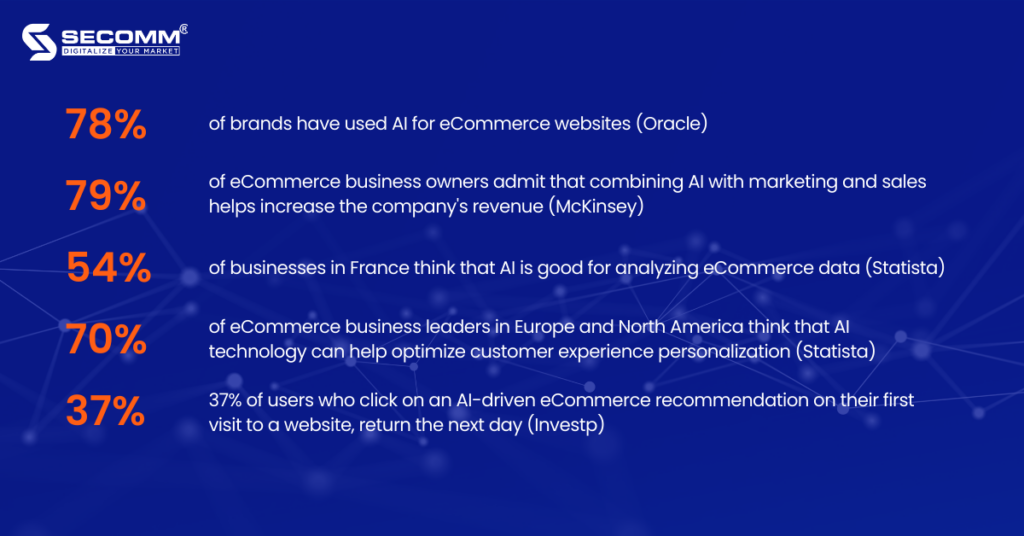
Currently, there are two applications of AI technology that are commonly used in eCommerce:
For eCommerce businesses, Chatbots will be like salespeople who can interact directly with customers 24/7. This helps businesses narrow the distance in terms of geography and time zones, helping the sales and customer services process to take place effectively without interruption.
By collecting customer data, AI can create tailored content and recommendations for each specific customer. To improve marketing campaigns and personalize the customer experience, AI can also predict purchasing behavior based on a user’s browsing and search history, when the data is legally available.
VR (Virtual Reality) is a modern technology that brings users into a simulated but still very realistic space with only 3D glasses (virtual reality glasses). The virtual world that the user sees is actually set up and controlled by a highly configurable computer system.
AR (Augmented Reality) is a new technology enhanced from VR technology. This technology has the potential to erase the boundary between the real world and the virtual 3D model. That is, users will experience virtual models in real space through smartphones or computers.
With a clear plan and the appropriate approach, Lazada has been in front of the augmented reality trend for a number of years and developed a certain competitive advantage in luring both consumers and sellers.
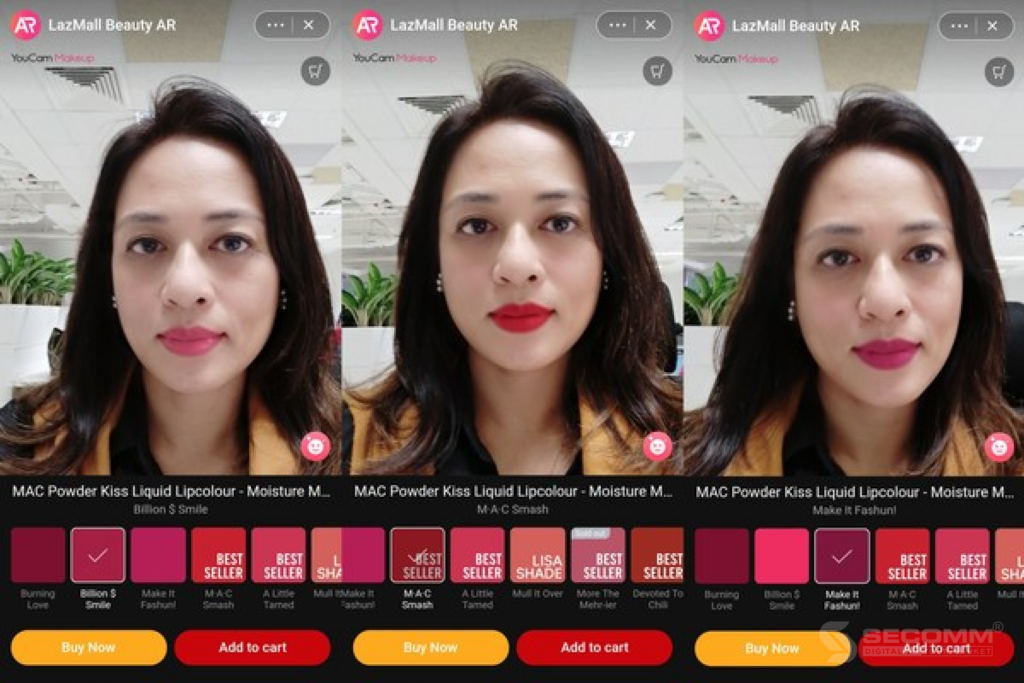
In particular, the VTO (Virtual Try On) function on Lazada includes a wealth of features to assist customers in freely selecting and trying goods like eyeshadow, eyeliner, foundation, and cushions whenever and wherever they like.
Since its launch, LazMall brand partners in the cosmetics sector have experienced tremendous success with the VTO function, which has helped to boost conversion rates by 3.1x and average order values by up to 11%.
The rapid growth of social networks and eCommerce has given marketing efforts a fresh and original breeze thanks to KOL/KOC. Although KOL and KOC have long existed in some form, they have truly taken off in recent years.
KOL – Key opinion leader, also known as an “influencer”, is an individual or organization with expert product knowledge and influence in their field or industry.
KOC – Key Opinion Consumers are “the most influential consumers in the market”. Their job is to test products and services and make comments and reviews.
KOL will suit mid- to high-end brands, while KOC will suit mid-range brands. If KOL is used to select brand ambassadors, holiday season ambassadors, or product launch campaigns, KOC is used to boost sales in a short time or direct customers to websites or eCommerce platforms.
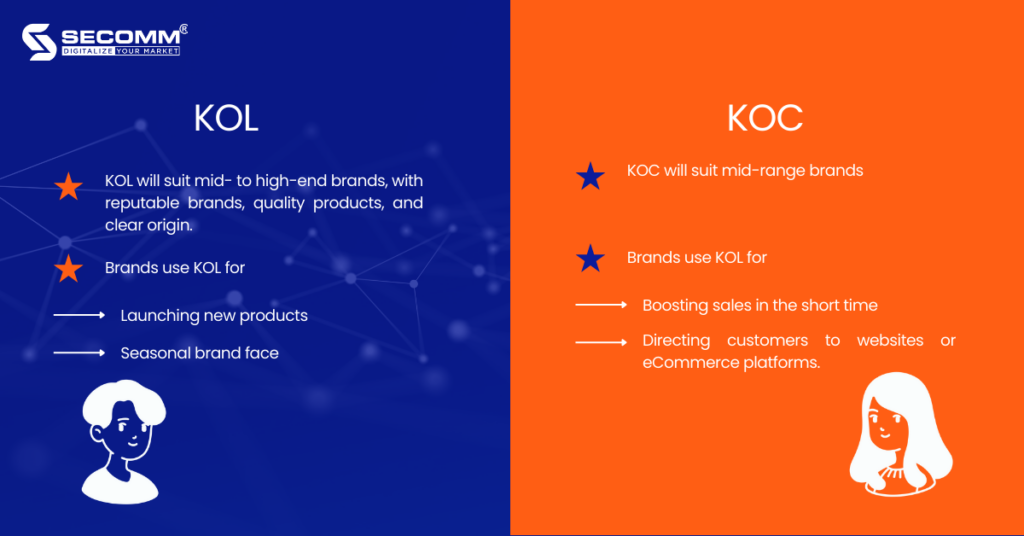
Some famous KOLs in Vietnam: Helly Tong, Giang Oi, Dino Vu, Co em Trendy, Chau Bui, Khanh Vy, Khoai Lang Thang,…
Some famous KOCs in Vietnam: Ha Linh, Call Me Duy, 1m88, Ong Giao Review, Chau Muoi, Hoang Viet, Pu Met 7,…
BOPIS – Buy Online Pick-up In Store is one of the shopping trends that promise to explode in 2023. Customers won’t have to be concerned about shipping costs, extended delivery times, or the risk of receiving unexpected goods when using BOPIS.
Businesses all around the world are pushing up their BOPIS implementation to meet customer expectations when merging online buying with in-person pickup. This is the ideal approach to boost store visits and close the gap between the offline and online buying experiences.
According to GlobeNewswire, the global BOPIS market is projected to reach $703 billion by 2027 with an estimated CARG of 19.3% between 2021-2027.
In addition, the following BOPIS trend statistics can help businesses consider implementing in 2023:

The BOPIS model also aids businesses in cutting expenses, expediting deliveries, boosting demand for retail goods, and lowering the risk of product returns.
User Generated Content, also known as UGC, includes text, photos, video and reviews. Because people are becoming less and less engaged in the brand’s message over the past ten years, UGC has grown in importance.
According to a recent Salesforce survey, 53% of Millennials think user-generated content (UGC) influences their shopping decisions, and 92% of consumers prefer content created by friends and family over that created by brands. The reason for the above numbers is trust.
Therefore, user-generated content (UGC), such as photos, videos, and customer evaluations, is trustworthy social proof and aids in the development of a company’s reputation.
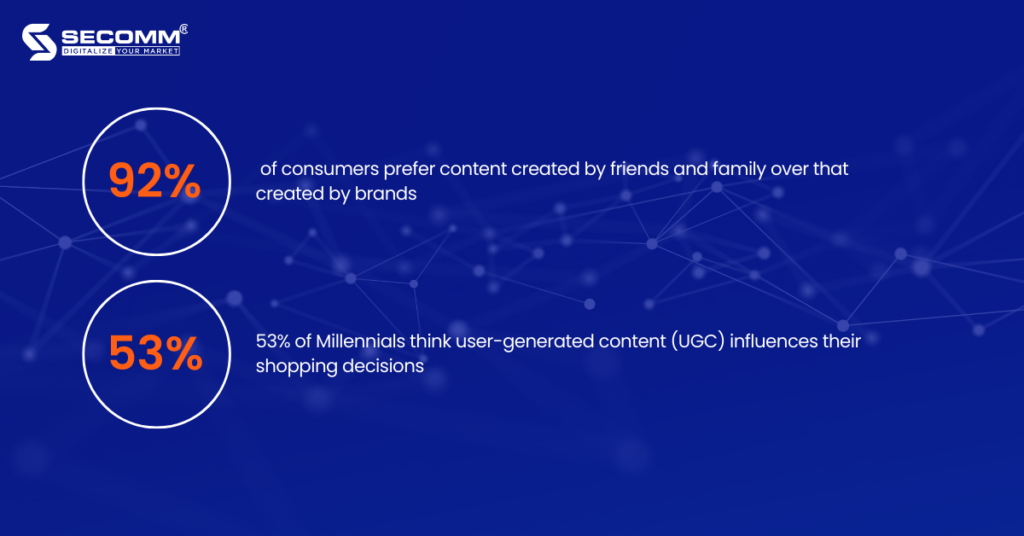
In a nutshell, businesses must quickly adapt to evolving eCommerce and digital technology trends in order to avoid falling behind and being driven out of the market. By reading 10 eCommerce trends that stated and analyzed above, businesses will have an overview to be ready for the new journey.
With many years of experience in successfully implementing eCommerce for many customers in many countries, SECOMM specializes in providing consulting services with comprehensive and professional eCommerce implementation solutions.
Contact SECOMM today for free support and advice.
 2
2
 5,417
5,417
 0
0
 1
1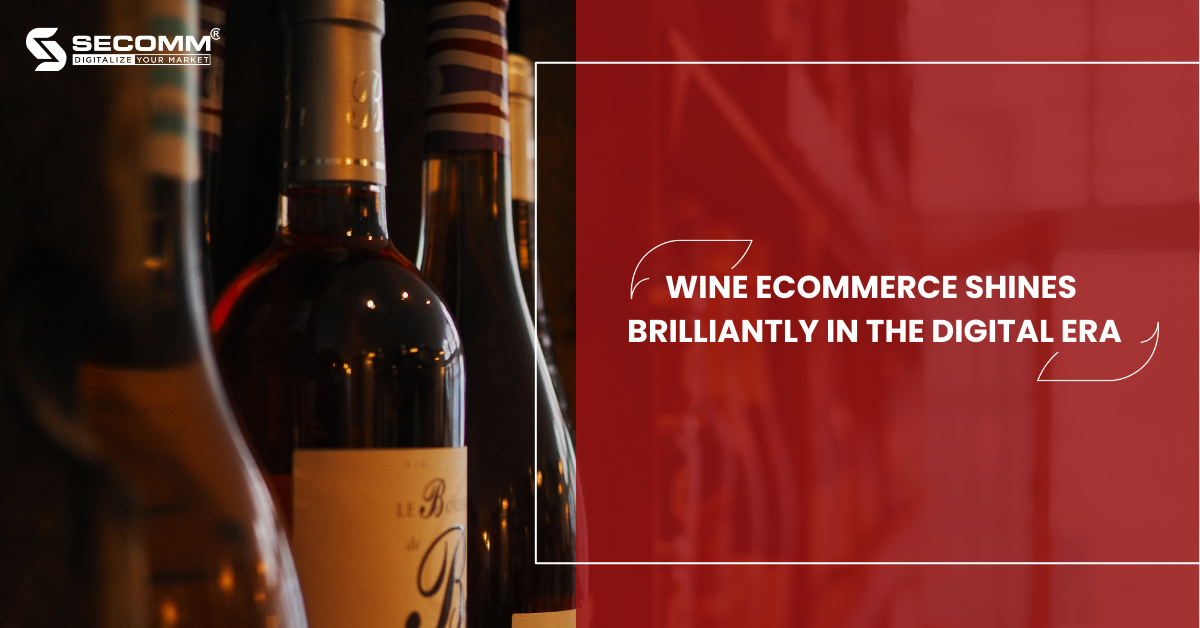
Over time, the Covid-19 pandemic has greatly damaged the world economy, with significant consequences for investors and business owners across a wide range of sectors, including the wine sector.
Sales of alcoholic beverages have decreased dramatically as a result of the closure of hotels, restaurants, and nightclubs as well as the postponement of big events and festivals.
Despite the global economic issues, eCommerce must be considered among the industries that perform very well. Some companies across multiple areas have enthusiastically embraced eCommerce to weather the downturn.
Also, wine firms follow that wave of change, making eCommerce shine in the new era – the era of digital transformation.
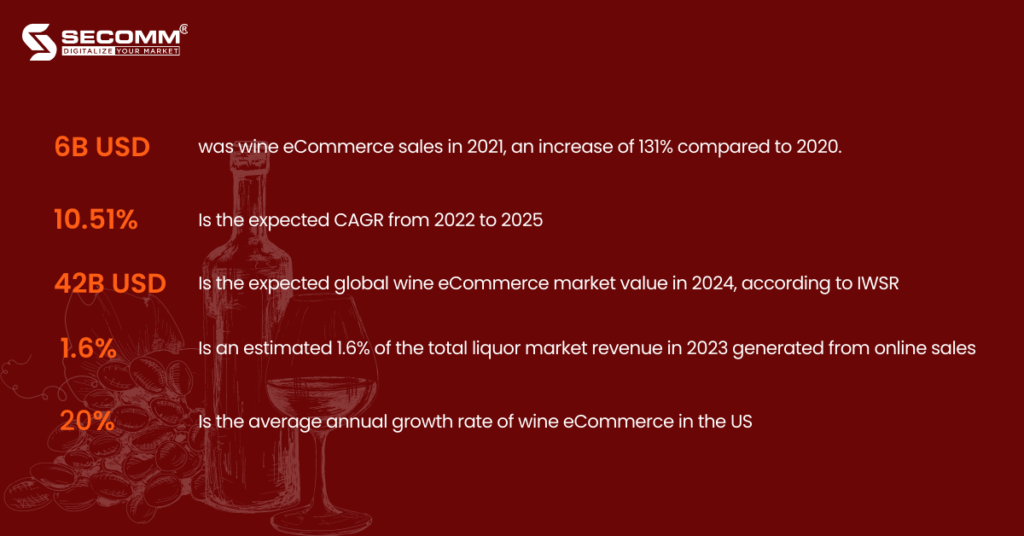
Global Pandemic
In the midst of the global pandemic-related crises, the wine business, like many others, saw a breakthrough in the speed of online purchasing.
When the pandemic breakout occurred, 44% of American consumers placed their first-ever online wine and liquor orders.
The year 2020 saw a 42% increase in wine eCommerce as a result. Online wine sales increased from just $1 billion in 2018 to $6 billion by 2021.
Young wine consumer
In the US, according to Avalara, Millennials and the legal drinking age population are steadily increasing.
By 2023, the Millennial generation is estimated to account for nearly 45% of the LDA (Legal Drinking Age) population under the age of 80. By 2030, this number is projected to be 54%.

In Vietnam, Millennials (25–38 years old) and Gen Z (18–24 years old), often known as MillennialZ, currently make up 47% of the population or about 45 million people who are of drinking age. The population structure of the MillennialZ generation is expected to keep growing.
The primary factors influencing the growth of the eCommerce sector as well as the digital economy of Vietnam will also be the young people’s awareness of and keeping up with new trends in digital technology compared to previous generations.
The Duty Free Shop Group (DFS) and Changi Airport Group (CAG) collaborated on the iShop Changi Wines eCommerce online project, which offers world-renowned and premium wines and spirits with exclusive discounts to visitors to Changi Airport, particularly those who are CAG members.
The iShop Changi Wines website is cutting-edge and exquisitely styled, showcasing the distinctive qualities of the wine industry as well as the aesthetics from page layout, color, font text, logo, and banner, all of which are guaranteed to optimize the purchasing experience while also, and this is crucial, emphasizing the identity and brand-development elements for both CAG and DFS.
Due to the fact that this is a project of well-known companies, the iShop Changi Wines website has consistently received a lot of traffic, averaging approximately 592 thousand views each month since its introduction.
Therefore, to combat the unexpected surge in traffic and orders during the busiest shopping seasons of the year, the eCommerce system must be continually enhanced and optimized.

The fact that major corporations CAG and DFS both started and developed successful wine eCommerce websites shows the enormous potential of this industry now and in the future.
Previously, the business scope of wine businesses was quite limited, but now that limit has been broken thanks to the dominance of the Internet and the rise of eCommerce.
Moreover, the government’s assistance in lowering legal restrictions has given wine producers the assurance to confidently market their goods to a significant number of potential buyers in several nations across the world.
The Warehouse, established in 2001, is renowned as a top supplier of wines and spirits in Vietnam, offering more than 16 different varieties of wine from numerous nations.
In addition, along with Annam Gourmet Market, Yves Rocher, and Flormar, this is another well-known retail brand of the Nam Group. Before being formally put on the market, products at The Warehouse are consistently inspected and carefully chosen to fulfill quality criteria.
The company has so far increased the reach of its distribution network across the nation, including Ho Chi Minh City, Hanoi, Da Nang, Nha Trang, Hoi An, Quang Ninh, and Phu Quoc.
The Warehouse achieved its objective of serving the wine market with B2B and B2C business models by utilizing the Magento platform.
This implies that the business will broaden the retail channel to include private customers in addition to distributing wines to restaurants, hotels, resorts, pubs, and lounges.
A series of symbols, logos, and banners created especially to fit the characteristics of the wine industry are combined with Bordeaux red to create a website interface that is focused on UI/UX perfection.

The Warehouse is flexible, secure, and has quick ordering, payment, and delivery options. Therefore, customers can place orders through phone, mobile app, or eCommerce website.
Customers can then pick up their purchases from the store or, in major cities like HCM, Hanoi, and Da Nang, the company will deliver them quickly within 2 to 3 hours. In other places, conventional courier delivery takes 2 to 5 days.
The Warehouse has been successful in raising brand recognition, expanding its customer base, and increasing both offline and online sales as a result of the timely growth of its business model and digital transformation
Long-standing Australian company Trentham Estate Winery, founded in 1988, focuses on the manufacture and distribution of wine.
After many years in business, the company is well regarded for its creativity in the wine-making process, which resulted in a variety of wines with different delicious flavors. Also, the brand has received hundreds of medals, titles, and other industry awards.
In the beginning, the business created and ran a WordPress website system for branding purposes.
Trentham Estate, however, has been forced to increase its company scale by making a substantial investment in an entire eCommerce website system due to the growth of eCommerce and the increasingly varied purchasing needs of potential clients.

In the beginning, the business created and ran a WordPress website system for branding purposes. Trentham Estate, however, has been forced to increase its company scale by making a substantial investment in an entire eCommerce website system due to the growth of eCommerce and the increasingly varied purchasing needs of potential clients.
That is what led to the creation of the website trenthamestate.com.au, which has a modern interface while still accurately capturing the distinctive features of the wine industry.
Similar to The Warehouse, Trentham Estate likewise creates an eCommerce website based on the Magento platform with a variety of features that satisfies eCommerce requirements and wine industry specifics.
Therefore, businesses can access and serve a wide range of large customer files not only in Australia and internationally thanks to effective marketing and branding strategies, towards a sustainable business model along with the changes of the digital age.
It would be hard to believe that an industry as sensitive as wine could be traded online so easily and efficiently. In that efficiency and convenience, there is a great contribution of the trend of eCommerce and the comprehensive National Digital Transformation program that is committed to supporting by the Government. This is an extremely appropriate time for wine businesses to confidently deploy eCommerce because of the support from the Government and the push from the market.
However, planning to implementation are two completely different categories. Businesses are required to have a practical strategy and technical assistance from highly skilled firms to hasten the success journey and help advance the National Digital Transformation goal.
SECOMM has many years of expertise in effectively executing eCommerce for numerous customers in various countries. We specialize in offering free consultation services with qualified eCommerce implementation solutions.
Contact us right away for free counsel and assistance.
 2
2
 4,816
4,816
 0
0
 1
1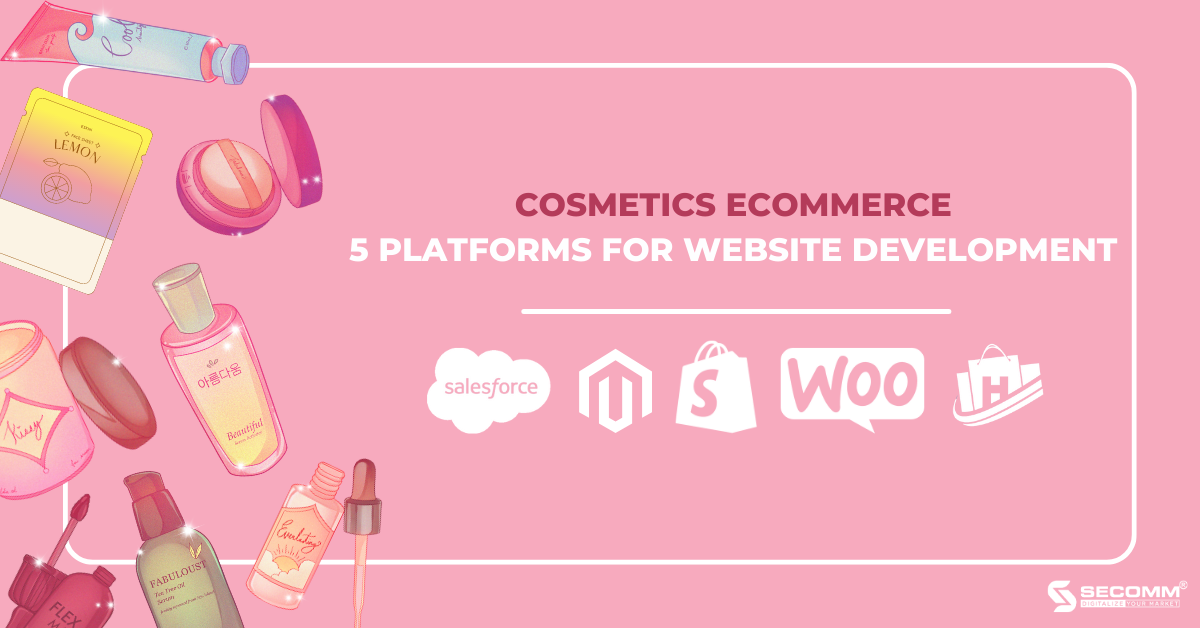
Cosmetics eCommerce is currently developing into a fresh and promising sales channel for companies in addition to the traditional sales channel. Businesses must work hard to sustain and achieve breakthrough growth through eCommerce platforms, though.
As a result, numerous cosmetics companies started developing online cosmetics business websites and found surprising success, such as Kylie Cosmetics, Hasaki, and Guardian,…
These websites’ success can be attributed to their early selection of an adequate and suitable eCommerce platform. Which platforms are appropriate for the cosmetics industry, then?
Salesforce Commerce Cloud (SFCC) is a highly flexible SaaS eCommerce platform that allows companies to offer the best B2B and B2C shopping experiences. Moreover, Salesforce gives Commerce Cloud access to Einstein AI to further enhance this system’s intelligence.
Top cosmetic brands currently using Salesforce Commerce Cloud to deploy eCommerce include L’Occitane, Lancôme, Loreal, Nars, Neutrogena, NYX Cosmetics, and Shiseido,…

Pros:
Cons:
=> SFCC is suitable for B2C and B2B cosmetic businesses.
Magento is a popular open-source commerce platform in the field of eCommerce, with nearly 200,000 websites in use. Currently, Magento has 2 versions: Magento Open Source (free), and Magento Commerce (paid).
Cosmetic eCommerce websites built successfully on the Magento platform with high brand awareness include Laneige, Sigma Beauty, and Hasaki,…

Pros:
Cons:
=> Magento is appropriate for a range of cosmetics business types, including B2B, B2C, and B2B2C, as well as for various business sizes, including start-ups, SMEs, and major companies. However, large organizations use Magento because it is frequently relatively expensive to deploy.
WooCommerce is a free WordPress plugin that allows businesses to transform a regular WordPress website into a professional eCommerce website with full features and easy customization with just a few simple steps.
A few good examples of big brands that have built successful eCommerce websites with WooCommerce and generated huge sales such as: MOI Cosmetics, Bo Shop, Nuty Cosmetics, AB Beauty World, Beauty Garden,. ..

Pros:
Cons:
=> WooCommerce will be suitable for cosmetics businesses that are familiar with the WordPress platform and want to develop an eCommerce system.
Shopify is a popular SaaS platform in the world that provides a variety of solutions for businesses of all sizes to successfully build eCommerce websites. After being in the market for about 20 years, Shopify has gradually grown to become one of the top eCommerce platforms in the world, trusted by many Vietnamese and foreign companies.
Kylie Cosmetics, Innisfree, Sulwhasoo, Cho Tinh Cua Boo, Guardian, and Ofélia are some examples of companies in the cosmetics industry leveraging Shopify for eCommerce websites and enjoying great success.

Pros:
Cons:
=> Shopify is considered suitable for start-ups or SMEs with global operations.
Haravan is a leading technology firm in Vietnam, that was founded in 2014, with the intention of eventually extending to many other Southeast Asian nations.
It specializes in offering businesses and merchants in Vietnam solutions for eCommerce, engagement marketing, and omnichannel retail.
Haravan has gained the trust of many companies in the cosmetics industry as a result of the efficiency of the website system that the business has created and the ground-breaking online retail sales.
The Face Shop, The World of Lipsticks, The World Skin Food, and Lam Thao Cosmetics are some well-known cosmetics companies in Vietnam that have launched eCommerce websites using the Haravan platform.

Pros:
Cons:
=> Haravan is suitable for start-up cosmetics businesses or SMEs (small and medium-sized enterprises) with operations mainly in Vietnam.
An extremely critical first step in developing a cosmetic eCommerce website is selecting the appropriate platform. Businesses may develop websites more quickly and affordably while enhancing their competitive advantage and sustainable growth by choosing the right eCommerce platform.
The improper platform, on the other hand, will cost firms a lot of money and effort to adopt and switch platforms repeatedly. Therefore, in order to select the best platform, organizations must take into account the objectives and issues with the current model.
With many years of experience in successfully implementing eCommerce for many customers in many countries, SECOMM specializes in providing consulting services with comprehensive and professional eCommerce implementation solutions.
Contact SECOMM today for free support and advice.
 2
2
 2,851
2,851
 0
0
 1
1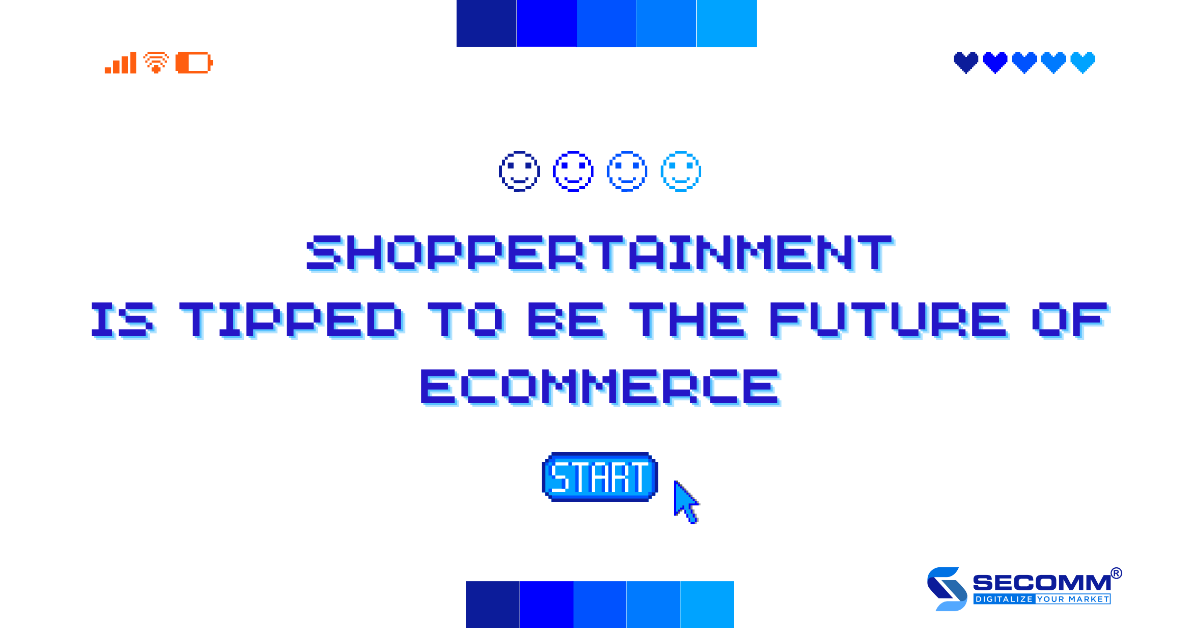
The Covid-19 pandemic not only encourages the tremendous growth of eCommerce but also helps shift consumers’ priorities from in-store to online buying. However, instead of just buying, consumers frequently prefer to seek out novel, inspiring experiences.
Therefore, every company should strive to implement the approach of shopping combined with entertainment (Shoppertainment) in order to improve marketing effectiveness and boost sales.
Shoppertainment is a combination of two elements “shopper/shopping” and “entertainment”.
Shoppertainment is described as “the provision of recreational or leisure facilities within or next to a retail store or shopping center, as part of a marketing strategy, which is designed to attract customers and stimulate purchasing” in the Oxford Dictionary (1990).
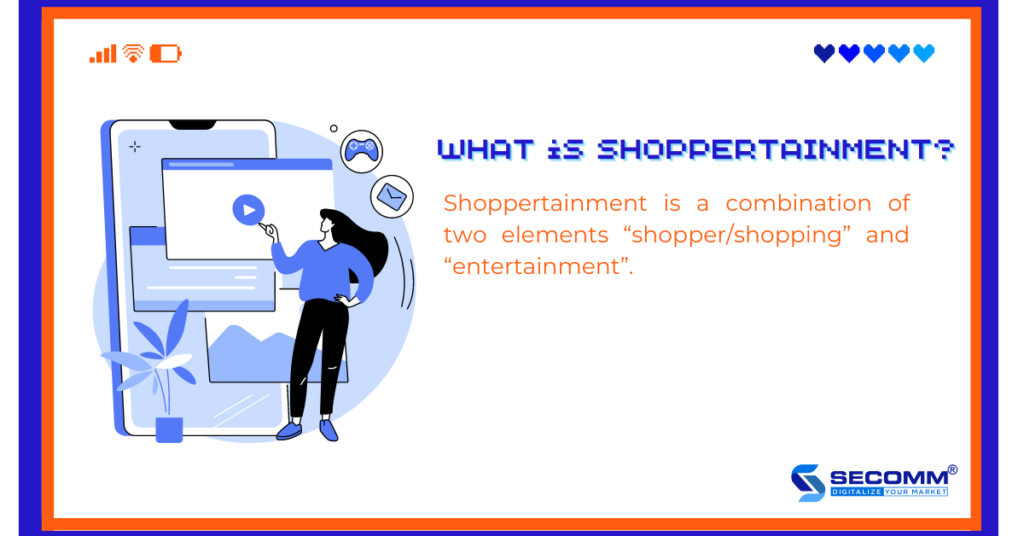
Many companies, notably IKEA, the biggest furniture retailer in the world, have used shoppertainment with success in the past. IKEA launched a campaign in 2019 called “IKEA nightclub – Tonight is to sleep” for 100 lucky individuals.
During this campaign, customers can partake in activities like manicures, massages, snacks, and tea instead of cocktails before spending the night in rooms with IKEA furniture that is soon to be released.
The brand has had remarkable sales success thanks to the campaign’s resonance in North America.
The shoppertainment trend, however, is no longer just restricted to stores or other physical locations thanks to the growth of eCommerce and digital marketing but has instead gained popularity and taken over online shopping activities.
In comparison to the prior definition, shoppertainment has been enlarged and changed. Shoppertainment is a trend that combines online shopping with entertainment, allowing buyers to engage with merchants in addition to purchasing products as usual.
In Vietnam and in the Asia-Pacific region, certain forms of entertainment-infused shopping are very common. Examples include live streaming, shoppable videos, and gamification.
According to the Vietnam eCommerce White Paper 2022, the size of the retail eCommerce market in Vietnam will increase from $11.8 billion in 2020 to $13.7 billion in 2021 and is estimated to reach 16.4 billion USD in 2022.
Meanwhile, the percentage of consumers shopping online on eCommerce websites is 78% in 2021, up 4% over the same period last year.
Because of the urgency, lack of options, and social isolation, the effects of the epidemic have actually contributed to a change in consumption tendencies from in-person purchases to online purchases.
Since that time, it has seen the quick decline of the conventional commerce model and the rise of eCommerce. By 2026, Statista projects that eCommerce sales will total $8.1 trillion.
Additionally, it is not surprising that consumers like shoppertainment. Although this combination is not novel, it promises to set the consumption trend in the years to come as eCommerce takes center stage.
The demand for online shopping will be higher there, and expectations for the best shopping experience—including both online shopping and fascinating experiences will also be higher.
Retail businesses around the world have seen a significant rise in sales during the outbreak by combining online shopping with live streams, entertainment videos, and video games to create real-time digital interactions with customers.
For instance, Taobao Live, which Alibaba introduced in 2016, saw a 150% surge in sales in 2020 when the epidemic first appeared in China.
“Shoppertainment is now a basic expectation. You really have to leverage engaging tools so the shopper gets to learn about the product, its superiority, and has fun along the way,” notes Alex Vogler, senior director and head of marketing, eBusiness, Procter & Gamble (P&G) Asia, Middle East, and Africa.
The Covid-19 pandemic has had a significant negative impact on the human psyche, causing issues including depression and anxiety. On the other hand, a portion of the populace said that the social connections they were unable to have prior to the epidemic significantly improved their psychological well-being.
People need to connect with the community and others like them more than just for amusement. Brands have therefore concentrated on improving the consumer experience by transforming personal experiences into shared ones that bring communities together.
As an example, consider the hashtag #TikTokMadeMeBuyIt. Through the TikTok platform, users can easily and amusingly share their shopping experiences, resulting in videos going viral and receiving more than 4.5 billion views.
Shoppertainment will result in emotional and impulsive purchasing decisions since it emphasizes entertainment and connection. According to a recent TikTok research:

The studies mentioned above demonstrated the enormous influence that social networks and online shopping trends have on consumer decisions.
Because of this, Vietnamese retail companies have prioritized shoppertainment in their marketing plans.
Customers demand a more social and engaging online shopping experience, as well as the ability to connect and converse with one another while buying, which is the reason for any of this.
In recent years, both buyers and sellers in the Asia-Pacific (APAC) area have grown accustomed to live selling. Live selling is less common in the US and Europe than it is in APAC, but businesses there are nonetheless keeping an eye on this trend.
For instance, AliExpress initially introduced the live selling feature in France in May 2020, and since then, more than 3,000 live programs have been launched, with the involvement of more than 100 vendors.
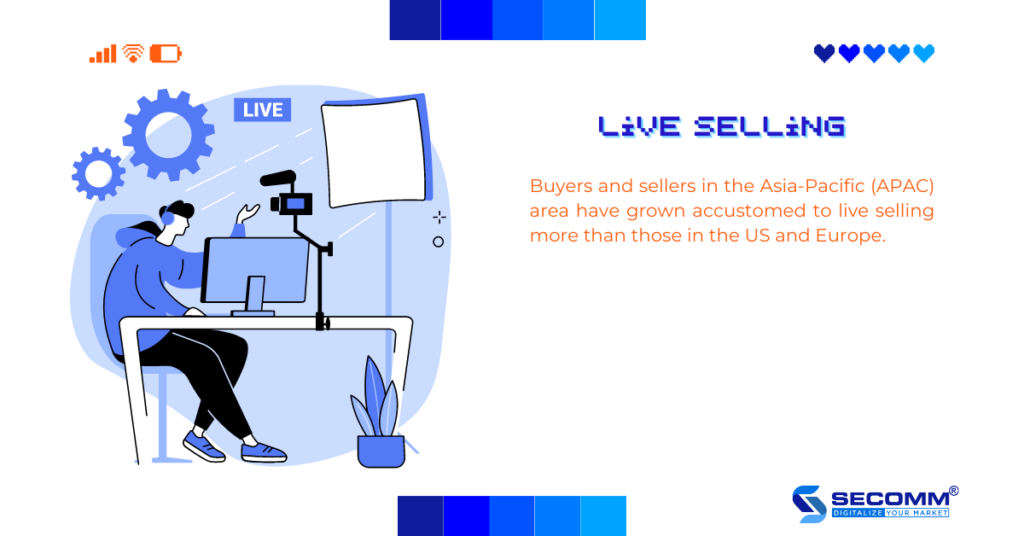
The combination of sales, interaction, and entertainment makes this one of the top social selling strategies. Customers can interact with vendors directly, view actual product photos, and make decisions by pushing their shopping emotions.
Plus, the engaging social interactions that take place throughout live streaming help retailers make an impact on customers, resulting in a high return rate.
Due to the growth of the Shoppertainment trend and the effectiveness of live streaming in generating sales through social networks, eCommerce marketplaces have started to put more of an emphasis on investing in producing engaging entertainment material for users on their apps, particularly through live streaming.
The customer buying experience is improved by several well-known live stream channels, like TaobaoLive, LazLive, Shopee Live, TikiLive, etc.
These companies have the resources to develop this feature for themselves, but lower-budgeted companies can still try the live-selling concept by integrating Facebook or YouTube live stream with an eCommerce website.
Live-streaming videos will be effectively replaced by shoppable videos. One of the joys of using this type of video is that companies may produce videos in their own distinctive styles that quickly introduce customers to their products, explain how they operate, and demonstrate how to use them. These videos can be attached to an eCommerce website. Users can always click the product link in this kind of short video to find out extra details or to make a purchase. The short-form video has overtaken popular platforms like TikTok, Instagram Reels, and Youtube Shorts as the go-to method for branding, cultivating customer trust, and influencing purchasing decisions.
83% of people, according to Nielsen study, prefer watching videos of advertisements to GIFs or text. Short-form videos have gained popularity as a result of global digital transformation and consumer preference, and many brands now opt to use those as part of their video marketing strategies due to their useful advantages, which include the following:

Gamification or Gamification Marketing is the skillful incorporation of a video game’s mechanics into promotional operations in a unique and impressive method to meet marketing objectives.
Gamification’s primary advantage, similar to live selling, is engagement, which keeps people on the site, drives conversions, and boosts sales.
Users are actually more likely to return for more shopping if a business can convince them that engaging with it is an interesting experience rather than a transaction.
A study by Bazaar Voice demonstrates the impact of gamification on businesses’ marketing strategies as follows:
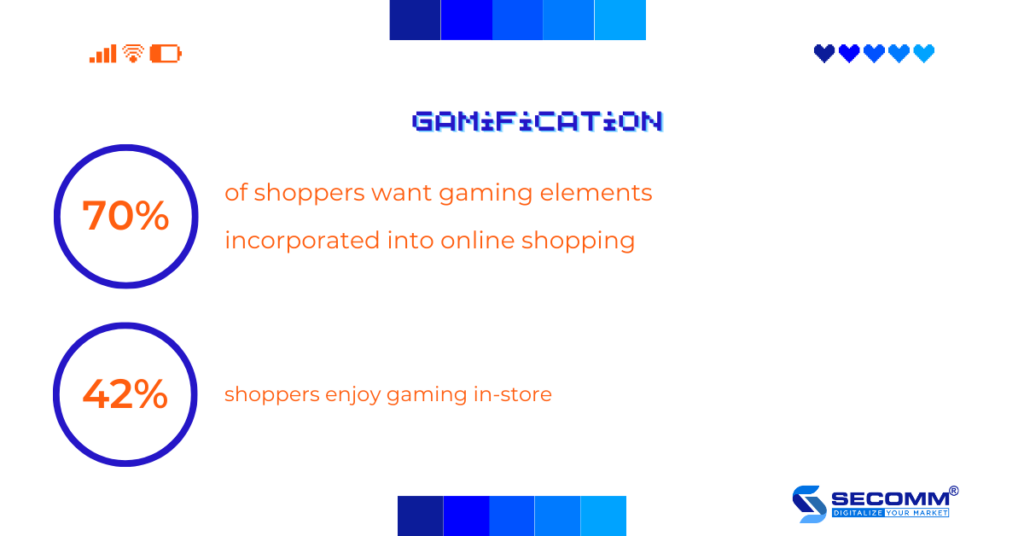
For instance, take Bajaj Finserv’s Indian financial company’s Gamification Marketing campaign. The game was created by this firm to encourage people to use its travel loan services.
Users will complete tasks and respond to questions about their preferred travel destinations. Customers adored the campaign, and it immediately trended on Twitter with more than 75 million impressions.
Thus demonstrating Bajaj Finserv’s efforts to develop engaging experiences and provide them to customers in line with its marketing strategy. Brands attract more potential customers, enjoy the better engagement, and increase conversions as a result of the viral impact.
Shoppertainment has been around for a while, but it wasn’t until Covid-19’s effect that this trend truly took off. Businesses should take advantage of this trend to improve the online shopping experience for customers and increase sales in the era of eCommerce.
Due to the growing demands of customers for a better shopping experience and the ongoing changes in the market, achieving this goal is difficult and labor-intensive. As a result, companies must work with expert agencies to plan the proper eCommerce deployment from the start.
With many years of experience in successfully implementing eCommerce for many customers in many countries, SECOMM specializes in providing consulting services with comprehensive and professional eCommerce implementation solutions.
Contact SECOMM today for free support and advice.
 3
3
 5,957
5,957
 0
0
 1
1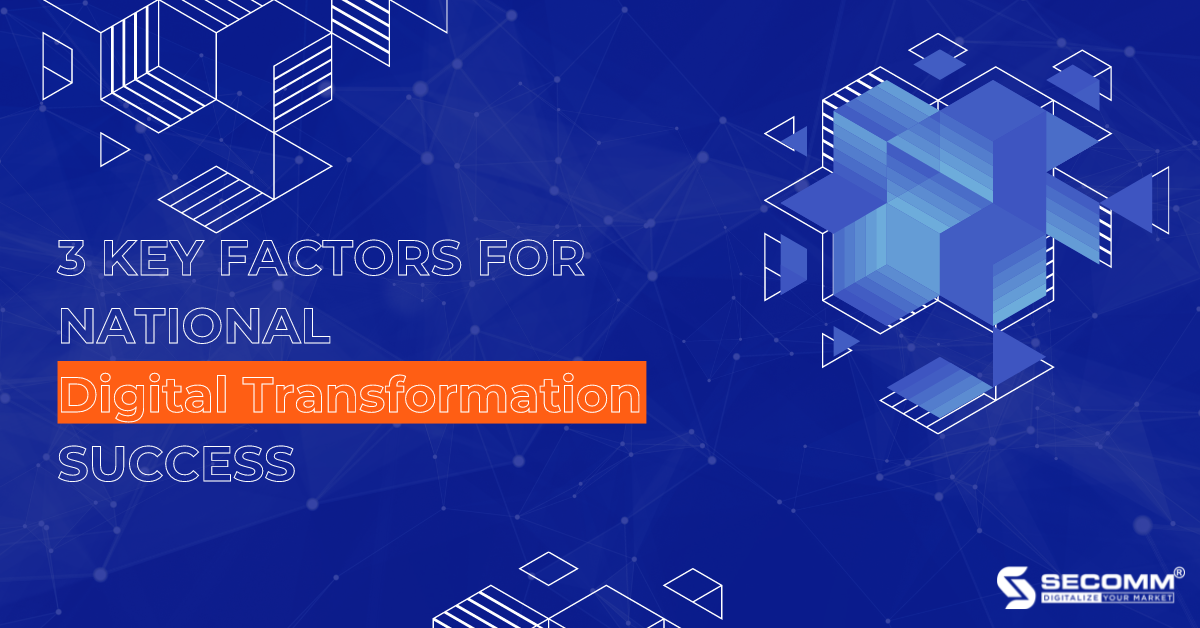
When the Prime Minister approved the “National Digital Transformation Program to 2025, with a vision to 2030,” national digital transformation became formally a goal shared by the entire Vietnamese people in 2020.
Since then, localities, ministries, branches, and even the government have all gradually incorporated the term “Digital Transformation” and applications of digital technology into their everyday activities.
Thus, we all realize the significance and impact of the digital transformation trend. What essential elements, nevertheless, determine the National Digital Transformation Program’s success or failure?
The process of using digital technology to completely alter each person’s lifestyle, each company’s business model, and each nation’s government operations in order to create new values and prospects for future development is referred to as transformation, also known as digital transformation.
Today, all businesses, big and small, have to decide whether to embrace innovation or risk lagging behind, becoming ineffective, and going out of business.
Furthermore, digital transformation involves- not just comprehending and utilizing technology but, more importantly, reinventing the complete business strategy as well as the vision and development priorities of the nation in relation to the global development trend.
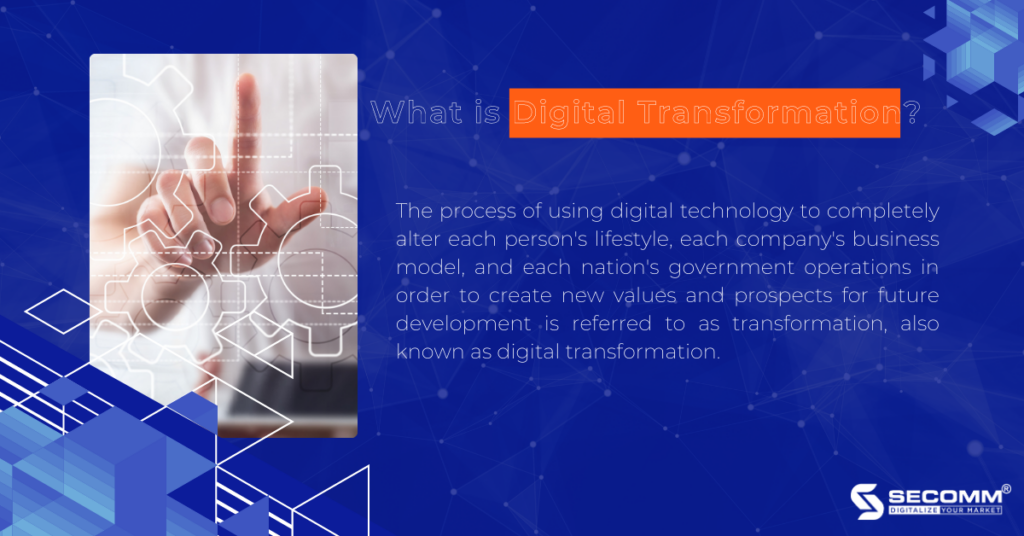
According to data from Mordor Intelligence, the digital transformation age is shining in practically “every nook” of the global economy, confirming that this is not a “soon to fade” trend but rather a new and sustainable development orientation following the pandemic crisis.
In Vietnam alone, the government has established a National Digital Transformation Program for 2025, with a vision to 2030, with particular targets to shorten the distance with other countries around the world, including:
The fact that the goals are stated in great detail in the national digital transformation program with a focus on 2030 demonstrates how seriously the Vietnamese government takes the significance of digital transformation for the prosperous growth of the nation.
Think about the global Industrial Revolution 4.0 wave that is currently in motion. With the aid of connection provided by the Internet of Things (IoT), real-time data access, and the introduction of cyber-physical systems, the Industrial Revolution 4.0, also known as Industry 4.0, primarily focuses on advancing modern digital technology to an entirely new level.
Every Government, organization, corporation, and individual throughout the world must transform its business model, and the manner of working from non-digital to digital operation, in order to keep up with this current technology and immerse itself in the Industry 4.0 wave. The name of this procedure is “digital transformation”.
Vietnam, despite having a minor economy compared to other countries, is a crucial part of the massive Industrial Revolution 4.0 that is currently underway. Vietnam must therefore undergo a digital transformation in order to compete.
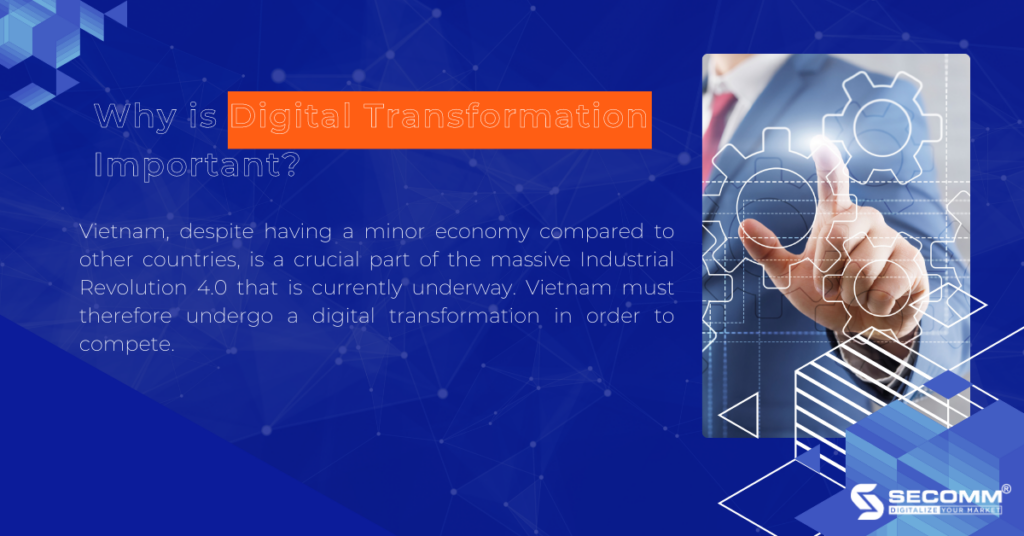
The goal will be challenging to accomplish if just businesses execute digital transformation because the capital and costs are quite high; therefore, businesses require assistance from the government budget and outside finance.
On the other hand, even with a massive budget, it can be challenging for businesses to implement effective digital transformation if the government does not go digital, but continues to run in the old manner, handles administrative procedures slowly, lacks direction, and supports businesses clearly and methodically.
Furthermore, without the support of the people, the National Digital Transformation process to catch up with the global Industry 4.0 wave will be impossible. However, the public needs the government to inform, direct, and inspire digital transformation.
Also, businesses must create useful digital transformation strategies that both before and after implementation considerably raise people’s quality of life.
Vietnam must structure three main areas of digital transformation: the government, businesses, and people, or in other words, the digital government, digital economy, and digital society, if national digital transformation is the outcome it seeks to achieve in order to gradually join the Industrial Revolution 4.0.
These three crucial overlapping and interdependent relationships make up the National Digital Transformation.
Throughout the earlier years, Vinasa reports that in 2019, 40.6% of organizations and businesses confirmed that they have resources available for digital transformation and that 23.6% of them are putting it into practice. However, 30.7% of them are uncertain of what to do despite doing some research, and 38% are unsure of where to begin.
Due to the Prime Minister’s approval of the “National Digital Transformation Program to 2025, with a vision to 2030” and the abrupt change brought on by the impact of the global pandemic, Digital Transformation is now regarded as the process’ starting year. This makes it a top priority to maintain Vietnam’s economy.
The government and Vietnamese enterprises have been able to promote awareness of the importance and urgency of digital transformation in order to help the country overcome the obstacle thanks to the economic crisis brought on by the effects of the Covid-19 outbreak.
According to the UN, Vietnam’s digital government statistics are better than the average for the area. Vietnam specifically saw a rise of 2 places in 2020, moving up to rank 86th out of 193 UN member states globally and 6th out of 11 Southeast Asian nations.
The establishment of the National Digital Transformation Committee and the decision to appoint October 10 of each year as National Digital Transformation Day in accordance with the National Digital Transformation policy for a better life for the people are two additional significant events that will forever be remembered in Vietnam in the years 2021 and 2022.
As a result, leaders and people are more conscious of the significance, function, and advantages of digital transformation, and there are coordinated actions throughout the entire system, from the government to the general populace.
According to data from the Ministry of Information and Communications, the databases that Vietnam has built up to the second quarter of 2022 include:
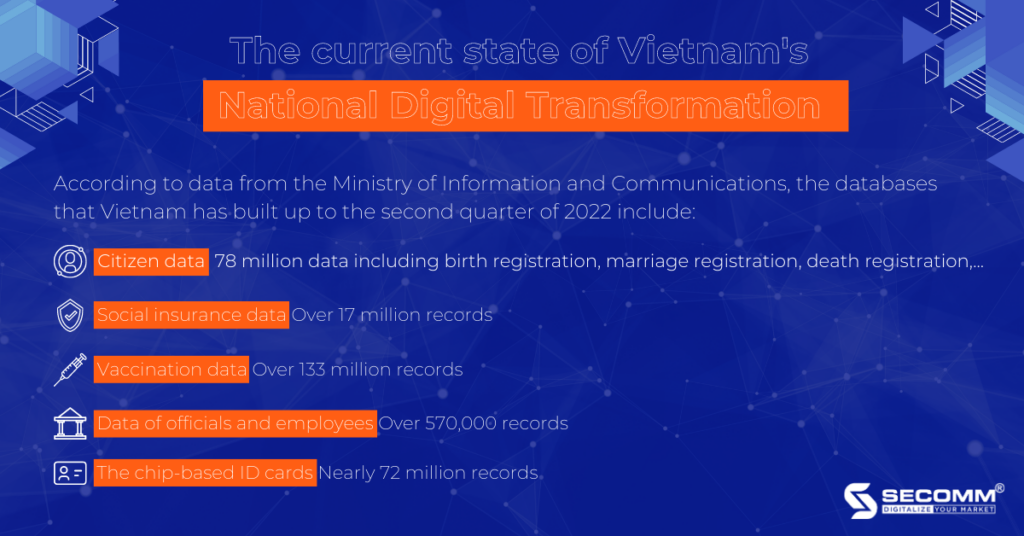
Additionally, the percentage of qualified online public services offered to individuals and enterprises has surpassed 97.3%; the percentage of these services that produce dossiers has gotten to 67.8% and the percentage of administrative procedures handled online has gotten to 43.2%.
Moreover, the economic sector has seen some very good improvements as a result of digital transformation. The Ministry of Information and Communications predicts that by the first quarter of 2022, the value of Vietnam’s digital economy will be 53 billion USD and that there would be 500 more newly founded digital technology businesses than there were at the same point in 2021.
The number of monthly users on Vietnamese mobile digital platforms climbed by more than 100 million compared to the same period in 2021, and the percentage of the digital economy in GDP increased to 10.41% in the first half of the year from 9.6% in the end of 2021.
Based on specific analysis and data on the situation of National Digital Transformation in Vietnam, it is clear that there are 3 main pillars that lay the foundation for the success of the National Digital Transformation process: Digital Government, Digital Economy, and Digital Society.
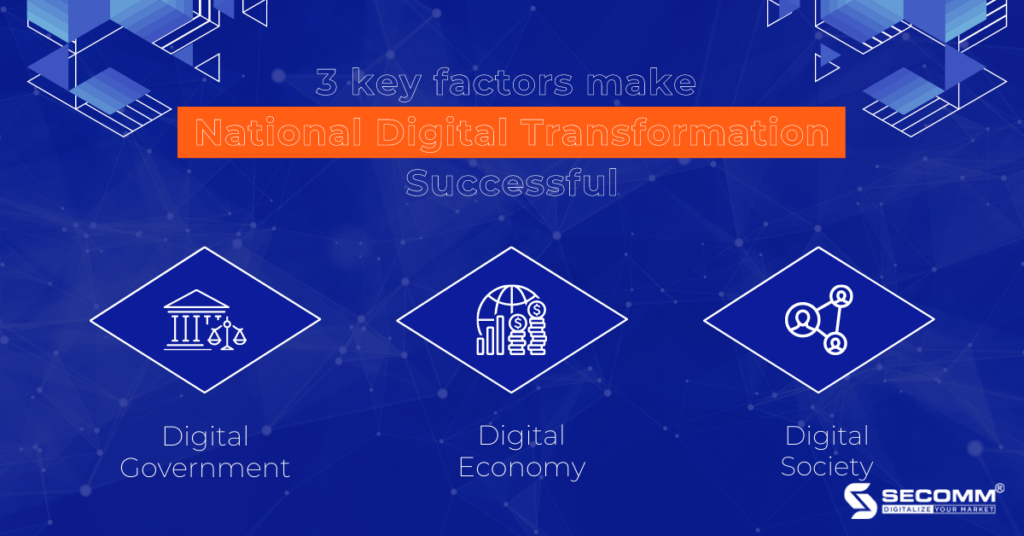
In order to increase operational efficiency and develop new operating models and alter the way services are offered using digital technology and data, a government must transition all of its operations to a digital environment. This allows enterprises to take part in the service delivery process. In other words, this is how the government is becoming digital.
Vietnamese citizens have been instructed in the past to finish the registration processes necessary to access the Citizen Identity Card with a chip, which is gradually replacing the previous ID card. This serves as one illustration of how well the digital government is progressing in Vietnam.
The process of processing dossiers and issuing ID Cards in the early stages is not really effective because the National Database on Civil is still under construction and staff training on how to use digital technology and digitize paper data on the data system is still limited. However, the procedure for issuing chip-based ID cards in addition to the cost is public and transparent.
As a result, when people arrive at the location where the chip-based ID card is made, processing will go more quickly if their information is already in the National Database; otherwise, they will need to provide more birth certificates and household registration information and will have to wait a long time for staff to check, enter data, and complete related procedures.
After that, the chip-based ID card will be sent to the registered address by post, but for the above reason, this process also takes quite a while.
The Public Service Portal of the Ministry of Public Security, however, is currently supported by the government and simply requires people to visit the location to capture pictures and fingerprints.
This demonstrates the government’s prompt responsiveness in streamlining business procedures while also saving time for both citizens and employees. This is evidence of the Government’s ongoing attempts to modernize itself digitally.
In addition, on the CCCD chip, more than 14 information fields of citizens are stored: (1) CCCD number; (2) Full name, other names; (3) Date of birth, month, and year; (4) Gender; (5) Nationality; (6) Ethnicity; (7) Religion; (8) Hometown; (9) Place of permanent residence registration; (10) Identification characteristics; (11) Date of issue; (12) Expiration date;
(13) Full name of parent, spouse; (14) issued 9-digit ID card number; (15) Portrait photos; (16) Features of fingerprint extraction and selection of two index fingers; backup for iris images, and other information.
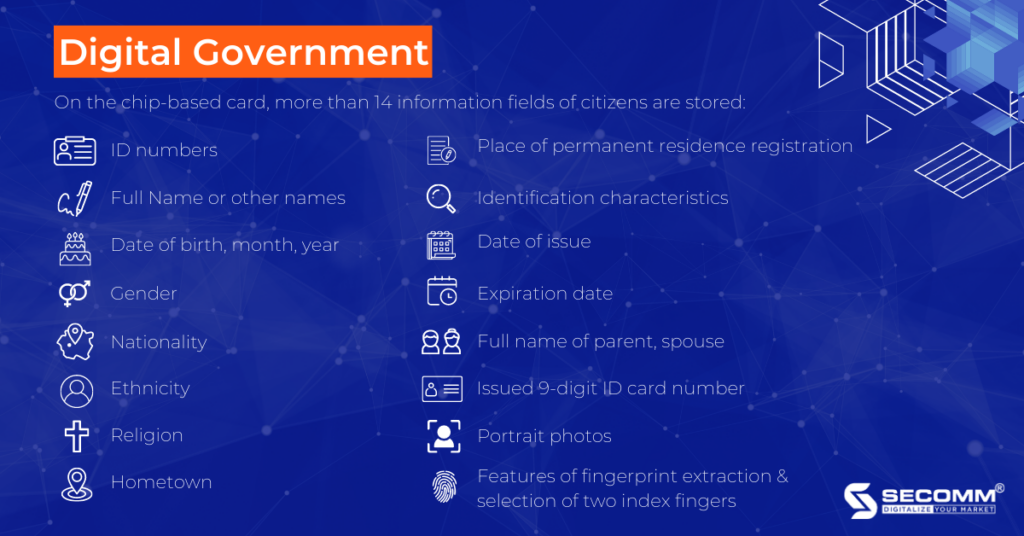
Moreover, a chip-based ID card can replace important papers such as Identity Cards, Health Insurance (HI), Social Insurance (Social Insurance), Birth Certificate, Marriage Certificate, and Household Registration Books….
It is clear that switching from conventional ID cards to chip-based ID cards has several advantages for both the general public and the government. People’s personal information is highly secure, preventing the creation of fake documents.
Also, ID cards with chips make paperwork and transactions straightforward because many pieces of crucial information are combined onto a single card, saving time and preventing the scenario where someone forgets to bring the necessary paperwork and causing the processing of documents to be interrupted.
The government made a wise choice by implementing chip-based ID cards.
The government can save, control, and check information about a specific individual quickly and efficiently with the use of chip-based ID cards and the National Database, helping to effectively control the situation of local security and order as well as national security.
Also, this helps free up labor for government employees who deal with people, handle paperwork, and maintain correctness, speed, and synchronization.
The second factor that makes the success of the National Digital Transformation process is the Digital Economy.
Digital Economy is an economy that maintains and develops constantly based on modern digital technology. The digital economy is also known as the Internet Economy, the New Economy, or the Web Economy. This particular economy is made up of electronic transactions over the internet.
According to the definition from the Vietnam Private Economic Forum, the digital economy is all economic activities based on digital platforms. Digital economy development is the use of digital technology and data to create a new model of cooperation and business, in line with the development trend of modern technology.
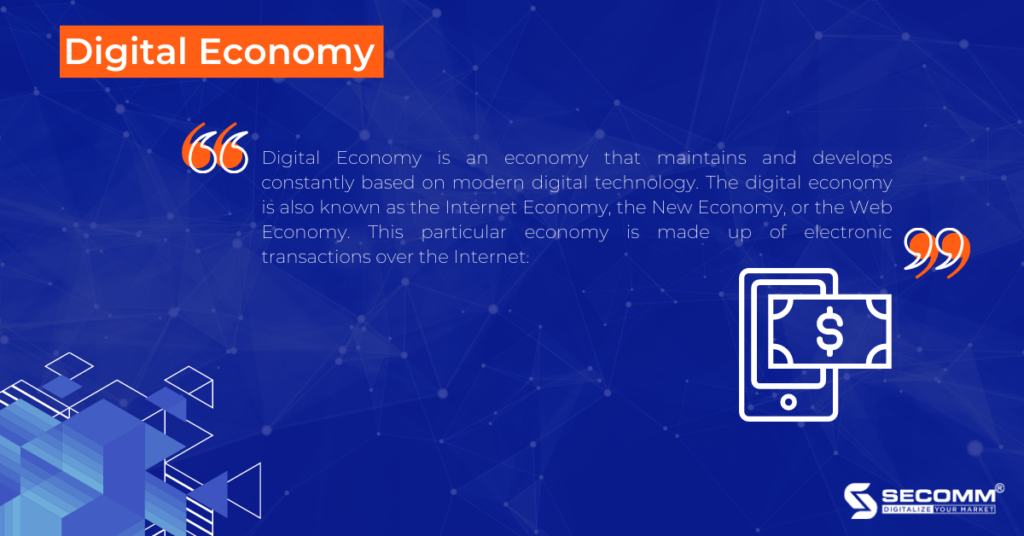
Therefore, everyone would immediately think of eCommerce when discussing the digital economy or the most prominent business model of the trend of digital transformation, and the strong push that this industry provides for high-volume industries catches the trend of digital transformation.
Few people anticipate that the conventional market model, which has become ingrained in Vietnamese culture, would soon be replaced by the market model 4.0, which accepts cashless payments. In several of Hai Phong’s traditional markets, this novel method of buying and selling was introduced for the first time, to the delight of the locals.
The Viettel Money application of Viettel Military Telecom Group, a pioneer in the digital transformation of market 4.0 models in 63 provinces/cities, enables all small businesses and individuals to purchase and sell things at the market by scanning QR codes or transferring money via phone number.
Moreover, cashless payment makes it easier for customers to shop at the market without worrying about issues like carrying change or budgeting extra cash for purchases. Also, many shopkeepers in the market are afraid of this issue pretty much.
Previously, if customers paid in cash with a denomination that was too big, shopkeepers would have to run everywhere to change money, causing time-consuming for both parties and other customers waiting to be served, the issue is now solved with just one smartphone.
Following the success of Hai Phong’s 4.0 market model, many other localities have also implemented this model and received positive feedback signals from the people such as Da Nang, Quang Ninh, Thai Nguyen, Lang Son, etc.
The market 4.0 model has spread to every nook and cranny of the nation’s small trading places, including farmers’ markets, grocery stores, sidewalk shops, amusement parks, parking lots, and more.
The digital transformation trend has quickly extended to places where it was previously impossible, helping to advance the digital economy and achieve the objective of a comprehensive national digital transformation.
Finally, the term “digital society” refers to all human activities in a broad sense. Digital technology, which is based on the exponential growth of information and data, is the primary driver behind digital society.
It transforms all facets of social structure, from the government and business to the individual. In a limited sense, “digital society” refers to both digital citizenship and digital culture.
From this perspective, the three pillars of a digital nation are the digital society, the digital government, and the digital economy.
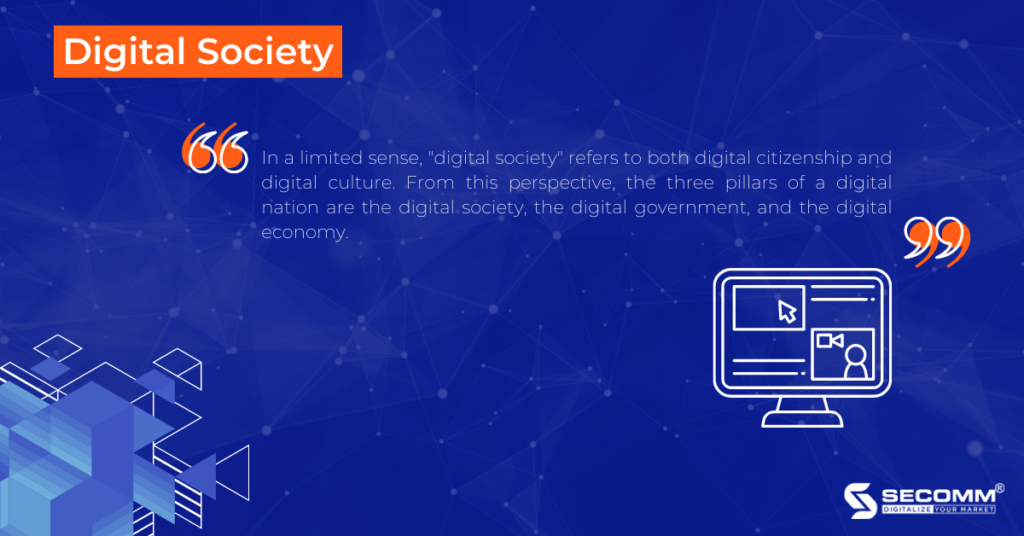
Teachers, parents, and students all adore the eLearning model, which is developing into a popular teaching and learning trend, especially in light of the recent pandemic and widespread implementation of social distancing policies.
Students can access lessons at any time, studying at home, using simply an electronic device with an Internet connection. As a result, teachings can be discussed and interacted with by professors and students without them having to actually meet.
This model also supports student doing teamwork well because it is not time- or space-constrained, saving on travel expenses in addition to using many other helpful resources.
However, for eLearning to really replace traditional teaching and learning methods, it takes a lot of effort from both the Government, the school system, and the student’s parents.
In fact, eLearning is only a small part of the digital society effort besides many other important aspects of society that need to be digitally transformed to make life more convenient for people.
National Digital Transformation has become one of Vietnam’s top goals and this is also a rare project that has received special attention from the highest levels of leadership and international support. Since then, Vietnam has had a full foundation to hope to realize the goal of becoming a digital country from now to 2030.
The development of a digital society, economy, and government, in particular, is a necessary and sufficient condition for a successful national digital transformation.
In fact, every citizen, from intellectuals to regular citizens, is gradually demonstrating a certain understanding in their own way about the digital transformation and awareness that the country is in a transition period to match the general development trend of the times.
This is in addition to the efforts of businesses and the support from the government.
Especially for businesses, digital transformation is an imperative remedy to withstands to withstand the tsunami of eradication brought on by the pandemic’s rapid shift in new business patterns.
Following Covid-19, business digital transformation flowed slowly, gently, and steadily, assisting the economy’s continued rotation.
The first step of the digital transformation journey for businesses is to start implementing eCommerce.
With many years of experience in successfully implementing eCommerce for many customers in many countries, SECOMM specializes in providing consulting services with comprehensive and professional eCommerce implementation solutions.
Contact SECOMM today for free support and advice.
 2
2
 4,014
4,014
 0
0
 1
1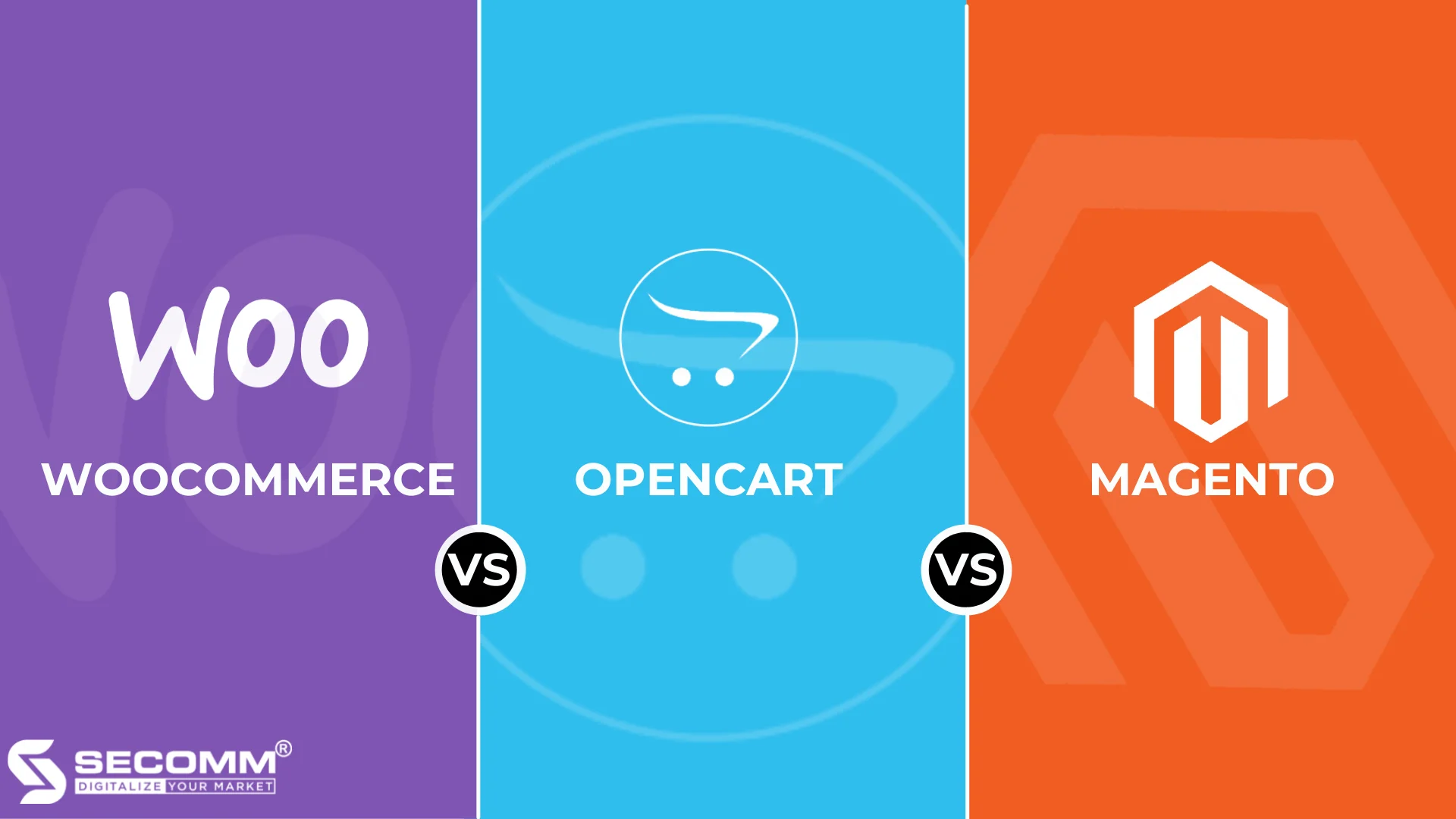
It’s important when it comes to choosing the right platform to build an effective eCommerce system. Businesses have many options to choose from either the open-source eCommerce platforms or any eCommerce platform as a service (SaaS, Paas), depending on the eCommerce business model and business plans.
To have a comprehensive eCommerce system, the open-source eCommerce platform is the business’s best friend, because of the great flexibility, scalability, customization according to the products, and catalogue characteristics.
In addition, the open-source platform also allows businesses to own the entire system source code and data. With all of these outstanding features, open-source platforms are slowly becoming the eCommerce development choices that many businesses are aiming for.
However, businesses need to carefully consider choosing the right platform. There are a lot of open-source eCommerce platforms on the market (OpenCart, WooCommerce, Magento,…), and each platform has its pros and cons.
WooCommerce is a WordPress plug-in introduced in 2011, completely free, and allows businesses to turn their WordPress sites into online stores, with built-in and additional features.
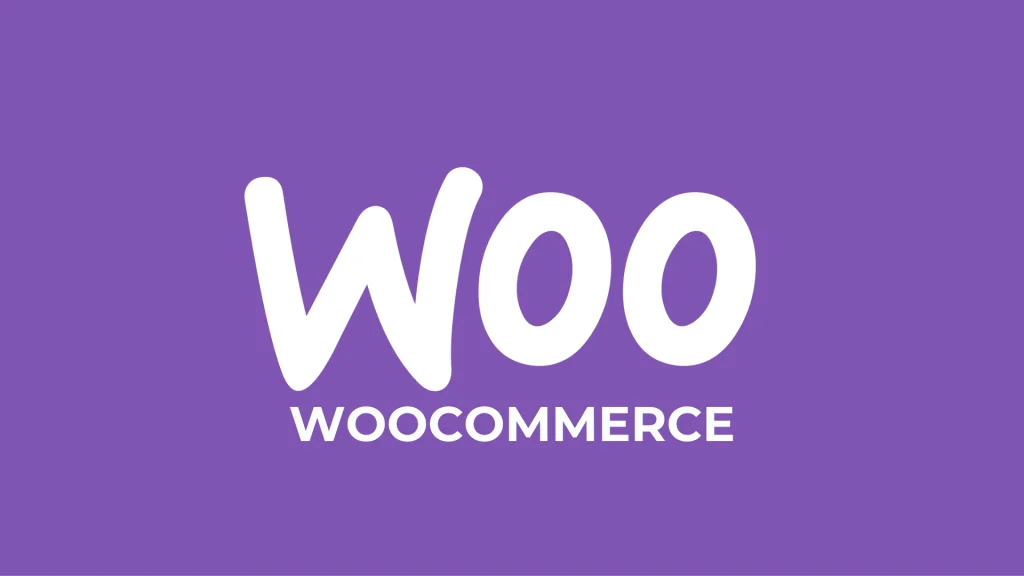
Ease of use
Many businesses that have been using WordPress for their online business, must be familiar with WooCommerce. Businesses can turn their website into an eCommerce system when implementing the WooCommerce Plugin into their WordPress website easily.
They can set up, integrate, and adjust functions on themes, and add-ons,… that have been built with high functionality from developers in a strong community around the world, making it easier to modify, and more flexible on the platform
In addition, WooCommerce is carefully built, convenient, also has huge and rich theme storage, and it is easy for businesses to design and build an e-commerce system right from the start, without knowing too much about technology.
Rich in features and add-ons
WooCommerce allows and supports features such as product management, orders, inventory, search engine optimization (SEO), discounts, sales, statistics reports, easy integration of payment units, shipping, handling units, and shopping experience optimization on all devices, making it easy for businesses to build a comprehensive system for simple and effective e-commerce business development.
Regarding security, WooCommerce ensures that businesses have the best security through a regularly updated system, and also ensures all of the business transactions are secure and safe through the features from the third-party services.
Low performance
One of the biggest disadvantages for businesses using the WooCommerce platform is the low performance, the system is easily overloaded with plug-ins and themes, and the number of products does not surpass 2000 SKUs, and often affects the system if the number of products exceeds the limit. Therefore, when businesses want to expand their business, it is necessary to consider switching to another platform.
Limited customization
WooCommerce is a plugin for WordPress, the platform lets businesses customize their eCommerce system, but building a complete, and comprehensive eCommerce system with unique features is very limited. The modification can cause instability for the system as well as the possibility that those built-in features are not compatible with the platform.
To customize a suitable system based on the available features system, businesses will face many challenges, it takes a lot of time and resources.
WooCommerce is perfect for businesses that are using WordPress and are looking to develop an e-commerce system. However, WooCommerce is not perfect for developing a comprehensive e-commerce system and expanding the business model. Some brands are using WooCommerce around the world such as Pluralsight LLC, and Gordon College, and famous brands in Vietnam such as Vietnam Airlines, Pharmacity, etc.
OpenCart is an open-source CMS (Content Management System) using PHP language, similar to WordPress but specially designed for e-commerce.
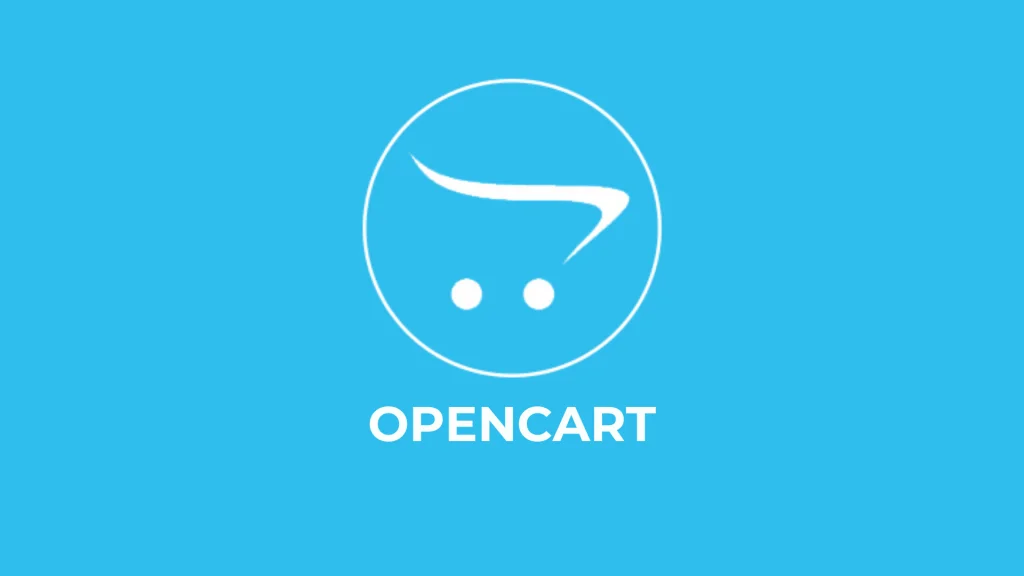
Friendly interface and easy-to-use
OpenCart provides an intuitive, easy-to-use, friendly interface, which is specialized for
the eCommerce industry. In addition, OpenCart also provides a completely free variety of interfaces and features, making it easy for businesses to develop e-commerce systems with basic website development knowledge and skills. Because OpenCart is built based on the MVC Model (Model- View- Controller), developing and writing a module for an e-commerce system on this platform is also quite easy.
Full of basic e-commerce features and a variety of add-ons.
OpenCart supports businesses with every basic e-commerce feature. Since OpenCart is a CMS specially designed for e-commerce, the open-source commerce platform such as OpenCart fully supports basic e-commerce functions such as sales, sales management, data management, statistics, customer data lists, and invoices.
Businesses can easily create and manage many different stores on the same system without having too much technical knowledge. This also means that businesses can access and manage all data of multiple stores at the same time with just one single central OpenCart system.
Not only supporting businesses build and manage an eCommerce system, but OpenCart also supports marketing such as search engine optimization (SEO), keyword advertising (Adwords), marketing programs, and affiliate marketing programs to be able to reach customers more easily, increase sales on the eCommerce system.
On top of the basic e-commerce functions, OpenCart also has additional applications to support businesses such as daily business operations and product categories. The backup and restore function helps businesses always have a backup system in hand and ready to restore all of the data on the system in case of an emergency
Besides that the platform also has many features such as a shopping cart, support customers to buy many products at once; gift features issuing gift cards, and loyalty programs. In addition, businesses can integrate other utilities such as payment gateway VNPay, and PayCEC, to help businesses have a better, faster, and seamless shopping experience.
Customization
With all of the basic features of an open-source program, businesses can easily modify, edit and customize on the OpenCart platform. In addition, the OpenCart e-commerce platform has a great ecosystem with many functions suitable for e-commerce business, firms can fully explore, as well as develop modules that are suitable for a satisfactory e-commerce system.
Although the OpenCart platform has many advantages that are the best fit for e-commerce businesses, there are also some limitations that businesses should be aware of when using the platform.
Low performance, and unstable
Although the platform is highly rated and well designed for the eCommerce industry, the system is still not stable enough because the modules and functions are not fully optimized, many errors occur while operating, as well as the installation steps are still very perplexing.
Therefore, businesses still encounter many problems when building and operating, which might affect the business’s processing speed as well as the revenue.
Feature development costs can become expensive
OpenCart owns extensive storage with quite a lot of basic features to serve e-commerce businesses quickly and conveniently, but the platform still cannot meet the advanced and specialized features according to specific product characteristics, product categories, and business needs of each field.
Therefore, businesses will need to invest time and resources to develop advanced features. For example, the SEO feature is supported on the platform, but there are many difficulties when censoring content via Google, not as effective as on the WordPress platform.
The OpenCart platform is relatively new compared to other platforms on the market, has many limitations and needs to be optimized. Similar to the WooCommerce platform, this is a good platform to start an ecommerce business, but not perfect for developing a comprehensive ecommerce system that goes along with growing and scaling your business. Some of the international brands that are using OpenCart such as Sunglass Hut, Virgin Enterprise, Audio-Technica Ltd, and the brands in Vietnam that are using OpenCart are Mobifone, RitaVo, etc.
Magento is an open-source platform specially built for e-commerce. It is recognized as one of the leading e-commerce platforms today, offering various outstanding advantages such as high flexibility, a diverse ecosystem, and optimal security. Currently, Magento has two versions: Magento Open Source (free) and Magento Commerce (paid).
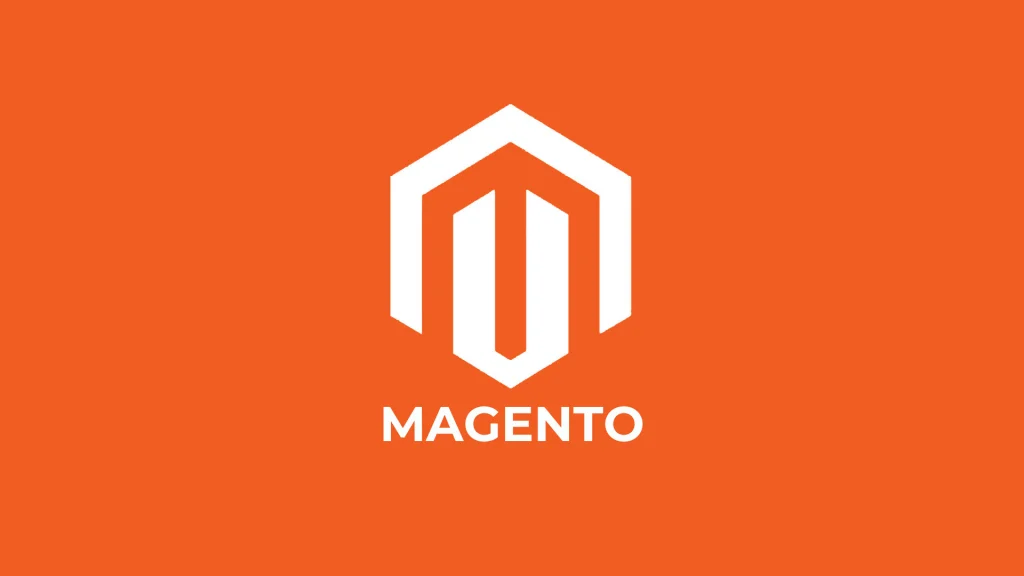
Diverse features for e-commerce from basic to advanced
Magento possesses many features available from basic to advanced to develop a complete e-commerce system including Category Management, Content Management, Customer Management, Marketing Management, Order Management, Store Management, System Management, Shopping Cart and Checkout, Reporting & Analytics. These features have been built with flexibility, and high availability to deliver outstanding results when integrated into the system, meeting all of your business e-commerce operations and sustainable growth needs
Scalability
One of the biggest fears of all ecommerce businesses is having a slow, poorly functioning system, or being overwhelmed when there are too many SKUs. With Magento, businesses do not need to worry about these issues even with millions of SKUs or thousands of transactions per hour. Magento can meet all the operational requirements, and business sustainable e-commerce development needs, with the ability to handle up to 500,000 products, and thousands of transactions in an hour.
High flexibility and customizability
Owning all of the advantages of an open source ecommerce platform, Magento has outstanding flexibility and customization. Businesses can easily change and develop new and specialized features according to the characteristics of products, industries, and businesses to be able to catch up with the rapid change of the market.
On top of that, businesses easily integrate third-party systems such as payment, shipping, POS, ERP, CRM, PIM, and BI to help develop all resources, and seamless processes without affecting the level of production, and the performance of e-commerce systems.
A global community for technical support and consulting
The customer support from Magento is for the customers, who are using the enterprise version, Magento Commerce. For customers, who are using the free edition, of Magento Open Source, there will not be any customer support from the platform.
However, Magento has a strong global technical support and consulting community. Therefore, most of the problems in eCommerce that businesses are facing can be solved from the Magento ecosystem or extensions from a third party. Having a strong global technical support community is also a testament to the level of reliability, quick resolution, and constant updates that Magento open source platform brings to customers.
High development costs
Magento open source e-commerce platform is highly appreciated with outstanding functions to develop a sustainable commerce platform, but businesses need to invest significant resources to deploy and develop the system.
Magento is an open source platform built specifically for e-commerce. This is known as one of the leading eCommerce platforms today on the market with many outstanding advantages such as high flexibility, diverse ecosystem and optimal security. Currently, Magento has 2 versions: Magento Open Source (free), and Magento Commerce (paid).
Magento has several outstanding features to develop a complete e-commerce system, and become a one-stop-shop for businesses that need development:
High Scalability
The biggest fear of all e-commerce businesses is having a slow, poor-performing website, or being overloaded with too many SKUs. With Magento, businesses do not need to worry about these issues, whether they have millions of SKUs or thousands of transactions per hour. Magento can meet all business needs for sustainable e-commerce operation and development. Therefore, businesses can scale up their business with Magneto.
High flexibility and customizability
The fact that the Magento platform has a high degree of flexibility is because of an open source platform. Businesses can modify and customize the templates, as well as adjust the features that the business needs to operate. In addition, businesses can completely build features from scratch to have an e-commerce system that is most suitable for businesses.
On top of that, businesses can easily integrate third-party systems such as ERP, CRM, and payment methods without affecting the level of performance of the main e-commerce system. In addition, businesses can easily separate the front-end interface from the back-end commercial activities.
Magento is an ideal place for businesses to host their software, but also a place with a lot of features. If your business currently has an experienced developer, or finances to attain a developer, and is ready to have an impressive e-commerce system, then Magento is a good choice. You have complete freedom to adjust the features until you are satisfied with your e-commerce system.
Big developer’s community around the world
However, the customer care from the Magento e-commerce platform is completely absent, in addition to that, Magento has a global developer support community. Therefore, there will be a lot of support for businesses to solve problems, and related techniques, as well as advice on building the most suitable solutions for businesses anytime, anywhere, and of course with a fee.
High development cost
A fully functional ecommerce system for a business is estimated to be at least $20,000 annually or more. If your business is just getting into e-commerce and has absolutely no technology experience, choosing Magento is a risky choice. But if businesses have the capacity and resources to run the system with this platform, then business growth will be faster with additional features such as sales automation.
Fully functional enterprise versions are estimated to be at least $20,000 annually or more. If your business is just getting into e-commerce and has absolutely no technology experience, choosing Magento is a risky choice. But if businesses have the capacity and resources to run the system with this platform, then business growth will be faster with additional features such as sales automation.
Complexity of specialized functions
Many businesses currently still face difficulties when transforming to e-commerce because of the specific characteristics of different industries and fields. These specific functions require an appropriate technology solution to ensure that the ecommerce system can operate efficiently and sustainably after the transformation. To build a specific feature with high complexity for an e-commerce system, businesses will need to spend more resources and time than the usual plan that businesses have set out to get a solution that fits the specific requirements of your e-commerce business.
Vietnamese firms that are using Magento
Magento is the best-fit solution for small and medium B2C businesses that have the need as well as the time, manpower and skills to build an e-commerce system. Famous brands in Vietnam are using the Magento ecommerce platform: Sendo, Vietnamworks, SJC, etc.
Different e-commerce platforms offer different features and values. No matter what route your business follows when building your e-commerce system, always think carefully about the following factors:
BigCommerce
With BigCommerce, businesses can choose the price that suits their business needs. In addition, the BigCommerce eCommerce platform is designed for everyone to use, from beginners to professional developers. However, if the business does not have a lot of capacity, as well as finance, then using BigCommerce to develop an e-commerce system is not suitable.
WooCommerce
With the WooCommerce ecommerce platform, businesses have full control over the ecommerce system. In addition, businesses can freely compare, and adjust any functions in the ecommerce system. However, expanding your business on the WooCommerce platform would be an inappropriate choice, as the platform can be overloaded with functions on the ecommerce system. However, businesses can start an ecommerce system with WooCommerce with less investment than competitors like BigCommerce.
Magento
Magento is a comprehensive ecommerce platform capable of supporting businesses to expand and grow their business in all aspects. However, all the disadvantages of Magento can be narrowed down to a single problem: the technical challenges, which require businesses to have an in-depth programming team. Meanwhile, businesses can solve this by having a team with experience building e-commerce systems.
Businesses can contact SECOMM to receive detailed advice for the journey to develop a comprehensive and sustainable e-commerce system for businesses and consult Magento solutions specifically for SMEs in Vietnam!
 2
2
 14,173
14,173
 0
0
 1
1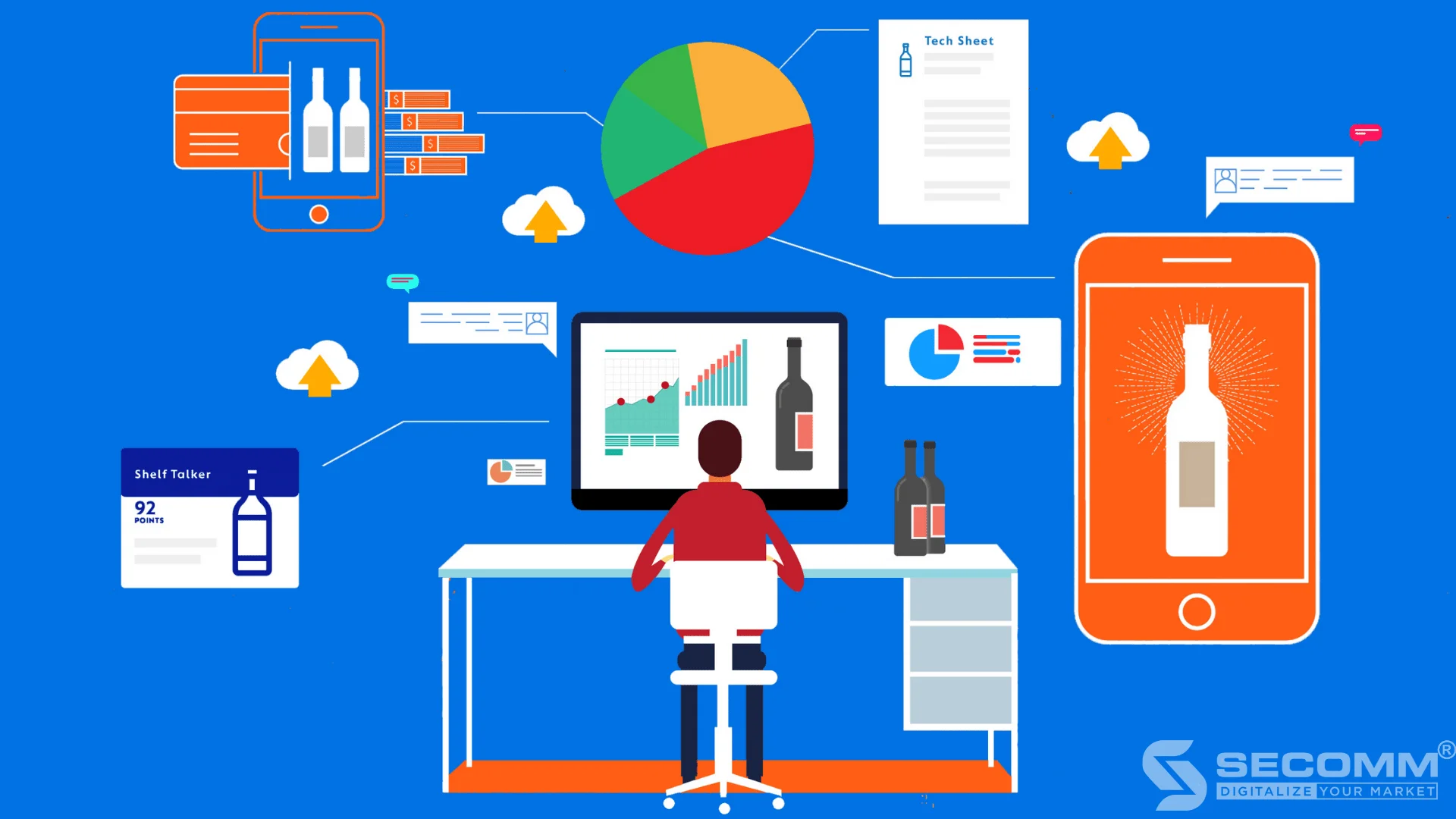
During the period of digital transformation and the strong impacts of the COVID-19 epidemic on the international markets as well as in Vietnam, the requirement to kick start and expand the eCommerce channel of the wine industry has accelerated faster than ever.
According to Nielsen, contrary to the expectation of a downward trend during the COVID-19 epidemic, the amount of alcohol sold through online stores during the Covid-19 epidemic increased by 27.6%. Particularly in Vietnam, many reports show that wine import volume in the past 3 years has always increased by 10% above average per year and tends to increase rapidly in the coming time, one of the reasons for the increase in wine imports is the changing trend from familiar alcoholic drinks to wine (Thanh Nien News).
However, to seize opportunities and deploy an effective eCommerce system for the wine industry businesses have to choose the most appropriate platform meticulously. Besides the platform that must match with the business model and the business plan, flexibility, and high scalability are the top two most important factors. Out of many highly-rated eCommerce platforms, the open-source Magento platform is well-chosen by many Wine eCommerce giants.
So how did Magento solve the eCommerce problems for the wine industry?
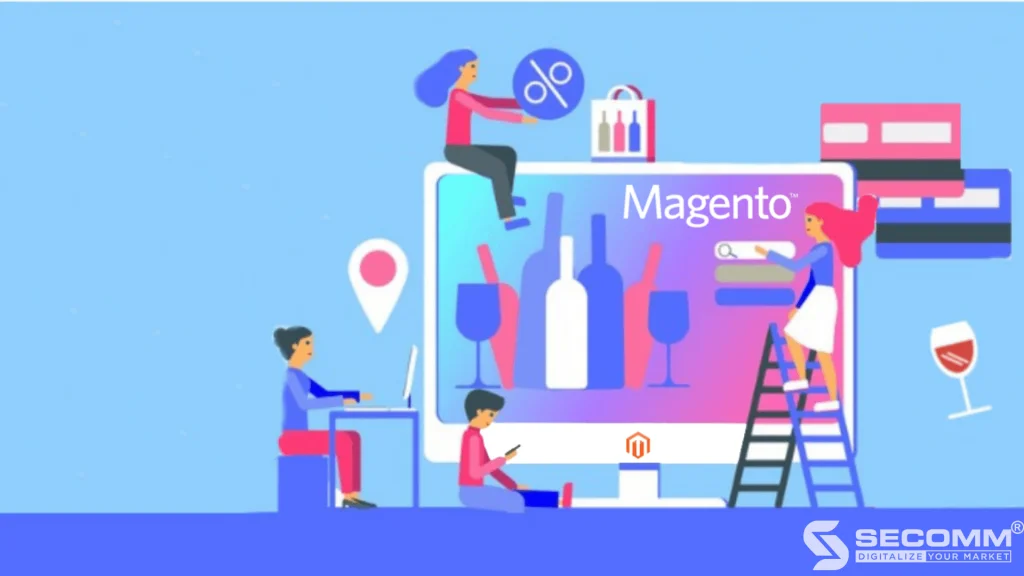
The eCommerce system for the Wine business not only needs to have a neat interface, and match with UX/UI standards but must have a high aesthetics level, and bring out the most unique characteristics of the industry to convey the brand and the production values to the specific customer segment of the industry – customers with “style”.
In addition to investing in high-quality images, arranging the layout scientifically and conveniently, such as the display of new arrivals, best-selling products, and most viewed products right on the homepage of the online store, the interface should reflect the distinctive characteristics of the industry and the unique highlight from the business to the customers.
One of the biggest challenges when implementing eCommerce in the wine industry is the system’s high complexity.
Most eCommerce businesses in the wine industry own a complex category system with a diverse number of products and a variety of product attributes. In addition, to ensure that the eCommerce system is running smoothly and stably with the number of visitors entering the system increasing gradually over time, and spikes during many promotional campaigns, the eCommerce system also needs to be well-designed and built carefully.
Furthermore, many wine business owners often have many sales channels and use many different management software such as POS, CRM, and ERP… this requires eCommerce platforms to be able to integrate, seamlessly and efficiently with third-party software without affecting individual system performance.
This integration also helps businesses overcome the limitations of manual operation, and increase automation for back-office, and sales management processes, ensuring high accuracy and operational efficiency for business operations, and development.
To ensure the development and operation of a complex eCommerce system that meets the above characteristics required the developers of the eCommerce system for the wine industry must be experienced and highly skilled.
One of the most important factors for eCommerce is the customer experience. Especially for the wine industry, which relies on personal interactions to build relationships with customers. However, the digital transformation that has been taking place in the wine industry since the beginning of the Covid-19 pandemic means that the in-store shopping experiences are limited, in exchange for buying wine online through an eCommerce website.
Therefore, businesses need to ensure that they have a product information management system ready, products in stock, pricing displays, well-known brands, various payment options, and delivery services to give customers a complete shopping experience.
Not only have a system that delivers a complete experience on the buyer’s journey, but businesses also need to prepare to personalize the customer experience. Beginning the personalization from the content, the product displacement, to navigating the buyer’s journey will be the key to helping businesses score points in the consumers’ eyes, effectively boosting sales and building Customer Lifetime Value (CLV) for the brand.
This requires businesses to know how to leverage unique data on consumers that has already been calculated and developed by using cutting-edge digital technology to build specific customer profiles, create buying habits that match the consumer’s interest, also provide customized content that matches each consumer’s needs, and bring a unique shopping experience to each customer when buying products on the system.
Nowadays, besides the traditional way of buying goods offline, or through brick-and-mortar stores, shopping through mobile applications as well as through websites has become a common way. Having a business presence on multiple channels – in other words, integrated Omni-channels makes it easy for users to make purchases.
To deliver a seamless multi-channel experience, it is essential to ensure that each channel is optimized for operation, nondisruptively connecting through technological infrastructure improvements. Simultaneously, businesses also need to ensure that they have enough customer information and take full advantage of these data to build distinct competitiveness, ensuring a seamless experience on the system.
In addition, wine businesses must constantly develop technology to accompany generations of customers that have changed over time from the Baby Boomers (1946-1964), Gen X (1965-1980), Millenials- Gen Y (1980-1996), and lastly Gen Z (1997-2002). The customer segments are getting more complex by the day, requiring businesses must have a solid understanding and stay up-to-date with technology to optimize the system to bring the best shopping experience that is most appropriate for each generation.
Related article: Wine eCommerce shines brilliantly in the digital era
Magento is known as one of the leading eCommerce platforms for the wine industry with many outstanding advantages such as an open-source platform with high flexibility, a diverse ecosystem, optimal security, and owning all built-in features from basic to advanced for the eCommerce system.
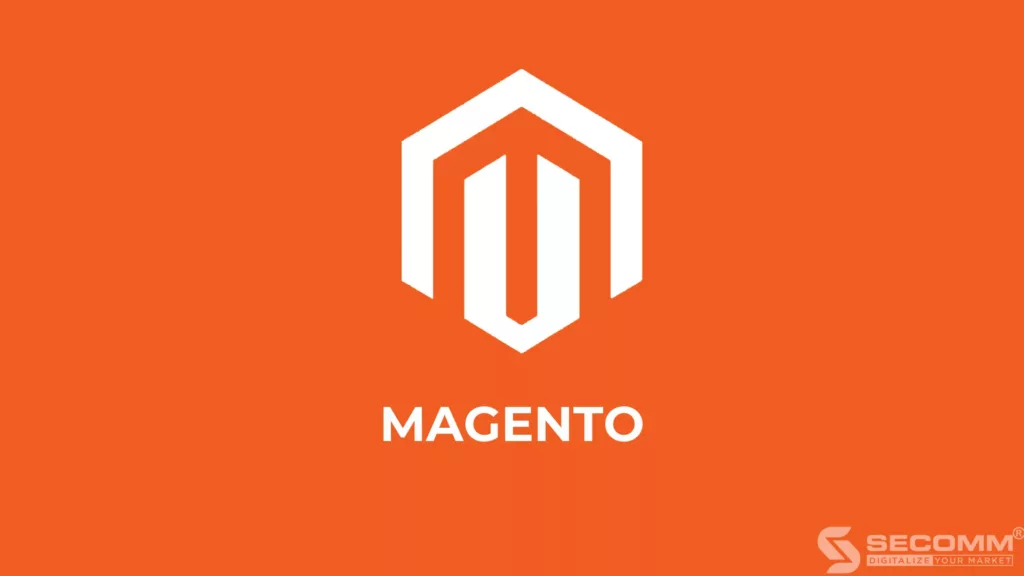
The Magento platform owns an extensive ecosystem that contains many online features that support business in the wine industry such as managing customer information, handling wine allocation, and controlling inventory, as well as handling orders, etc.
These basic features have been built to help businesses operate an online commerce system without spending too much time designing, and developing special features. So businesses can kick start their eCommerce journey without spending too much time and money right from the start.
The Magento platform is known for its outstanding features and extensions that are developed to meet the rapidly evolving eCommerce market as well as the specialized requirements of each business. Thousands of advanced functions in themes, add-ons, products, Marketing, optimal payment solutions, and shipping,… built with flexibility and high usability have shown remarkable results when integrating into the system, meeting all operational needs, and long-term eCommerce development needs.
The Magento open-source eCommerce platform can accompany businesses with all business models from B2B, B2C, D2C to B2B2C, or from newly operated businesses to businesses that expanding their operating systems. Magento can support businesses to operate and develop, expand into many websites, many countries, multi-currency, and all can be managed on the same system.
Also, Magento has a stable operating system with the ability to handle up to 500,000 SKUs, and thousands of transactions in an hour, so the platform can support businesses operating a stable website that has an increasing amount of traffic over time or a sudden spike during the promotional period.
One of the outstanding features of the Magento open-source platform is the ability to easily integrate with third-party services such as payment, shipping & handling, analytics, and business management software to help operate the eCommerce system. seamlessly and efficiently.
Many eCommerce businesses in general, as well as the wine industry in particular, need secure, flexible, and diverse payment software from domestic cards to international cards to payment gateways (Paypal, Stripe, OnePay, ), e-wallet (Momo, ZaloPay…).
Ex: Trentham Estate, the business has integrated with the Stripe payment gateway to process recurring orders without the need for customers to interact each time with a new order. This has simplified the buying journey as well as the customer experience, helping customers quickly make purchase decisions. The application supports customers effectively on many interfaces and devices, from websites, mobile apps, credit cards, e-wallets, etc.
About shipping and handling, businesses can easily integrate last-mile delivery services and other shipping applications in the markets to help optimize the delivery processes. In addition, businesses can completely customize the delivery modes that are suitable for businesses and customers to get the best shopping experiences.
In addition, wine businesses can develop their delivery options that allow the system to automatically select the corresponding store according to the address provided by the customer, allow orders to be allocated to the nearest warehouse, resulting in higher delivery efficiency, helping customers receive products faster and more conveniently as with businesses The Warehouse has applied for their delivery in everyday business.
Ex: iShopChangi Wine (Singapore) has designed and developed a pick-up feature at the arrival or departure terminal for passengers that are departing, arriving, or transiting at Changi Airpor with their flight information. In addition, customers can also choose “Home Delivery” as long as it’s within Singapore. The system allows all groups of passengers to customize and choose the most convenient pick-up times to get the best out of the shopping experience.
In addition to the ability to integrate diverse payment and delivery methods, many wine businesses are turning to the Magento platform because of the easy integration between this platform and management software such as ERP, and CRM to get a seamless connection of all supply channels from offline to online.
Through the integration of the Magento platform, businesses can overcome the limitations of manual operation and increase the automation of back-office and sales management processes, ensuring high accuracy, and operational efficiency for long-term development.
Besides the built-in analytical tools available on the platform, wine businesses can fully integrate analytics and reporting software such as Business Intelligence (Power BI, Tableau, Looker,…) helping businesses easily analyze and utilise consolidated data, improving business strategy, optimizing the personalized shopping experience while using the system, and growing business, as well as getting the overall view of the business situation more accurately than using manual methods.
iShopChangi Wine website is an eCommerce website specializing in providing many famous wines worldwide with special offers for travellers entering or passing through Changi Airport, especially for the members of Changi Airport Group – CAG (Changi Rewards members) with many attractive promotions.
SECOMM accompanied by iShopChangi Wines begins the improvement starting with the interface, page layout, the product classification. Next, the business optimizes the entire operating system as well as the infrastructure on the existing website to ensure the website operates seamlessly, and stably.
Besides providing operational solutions, the business also focuses on keeping the system unique in terms of both aesthetics in design and the elements of brand development for both CAG and DFS. About functions, the business has developed a complex price calculation, and display system based on many tax principles for alcohol-containing products, as well as classifying customer groups to quickly process orders, as well as optimize the delivery feature at Singapore’s airport and bring the best buying experience.
iShopChangi Wines’ eCommerce system has effectively met the shopping needs of international tourists. The initial complex elements have been simplified into a standard UX/UI interface, and ensure a professional, outstanding overall look of a wine website.
Trentham Estate has been a long-standing Australian brand specializing in wine production and trading since 1988. Throughout the operation, the business has been honoured with hundreds of medals, titles, and significant awards in the wine industry. They were also appreciated for their flexible and creative winemaking method, producing various distinct flavour products.
Since the beginning, Trentham Estate Winery built and maintained a WordPress website to develop and manage all the branding activities. Until 2017, the company decided to switch to the open-source platform, Magento, to build a comprehensive website to be able to provide all wine products with a faster operation and management process.
Trentham Estate Winery and SECOMM built a complete website with the Magento platform to optimize the interface, bringing the unique features of the wine industry to businesses. Next is integrating the payment process with Stripe, and developing delivery on the eCommerce system according to the delivery frequency that suits the customer’s preferences. Finally, building the “Wine Club” program with many incentives for loyal customers, providing the best experiences, and increasing a source of revenue.
The Warehouse stands out from the Vietnamese market as a wine and spirits distributor, which is also one of the An Nam Group’s retail brands (Annam Gourmet Market, The Warehouse, Yves Rocher, Flormar). Since 2001, the brand has spent its efforts to partner with more than 80 well-known wineries worldwide. Those corporations have supported The Warehouse to bring the Vietnam Market high-quality products with peculiarities from parts of the world.
Starting eCommerce with the Magento platform, The Warehouse is extremely focused on fine-tuning the interface, including the Vietnamese and English content, high-quality images, and harmonious website layout for all products on each page, helping businesses show the unique brand’s characteristics as well as the wine industry.
In addition, the enterprise also optimizes user experience and maximizes revenue by developing a product display system with complex categories and attributes, integrating the OnePay payment gateway, also integrating, and synchronizing data from business management software POS, and ERP (Microsoft Dynamics AX) with the Magento platform to limit manual operation, increase automation, and operate all resources and processes flawlessly.
Currently, the business is expanding its business with the Magento platform to meet all the needs of customers across Vietnam.
eCommerce is an inevitable trend as well as a “weapon” for wine businesses to break the market limits. This is a good opportunity for wine businesses to quickly grasp, develop, and expand their business models. To start their eCommerce journey, wine businesses can choose to build their system with Magento, an open-source eCommerce platform.
Magento, an open-source eCommerce platform, is a suitable platform for the wine industry with all business models such as B2B, B2C, and B2B2C. With all of the advantages of having a lot of features from basic to advanced, diverse ecosystems, scalability, and the flexibility of the Magento eCommerce platform, wine businesses can completely design a website that meets all requirements and delivers the ultimate online shopping experience.
In addition, businesses can easily change and develop specialized features according to product characteristics to keep up with the rapid changes in the market and develop long-term goals. That is also one of the main reasons that many wine businesses have chosen the Magento platform to go hand in hand, such as The Warehouse, iShopChangi Wines, and The Trentham Estate Winery.
SECOMM has significant experience developing complicated Wine eCommerce websites in different countries, and we know the challenges that businesses face when selecting and implementing an eCommerce platform.
Contact SECOMM for a free consultation on eCommerce website development!
Read more: 5 eCommerce platforms for the wine industry businesses
 2
2
 9,837
9,837
 0
0
 1
1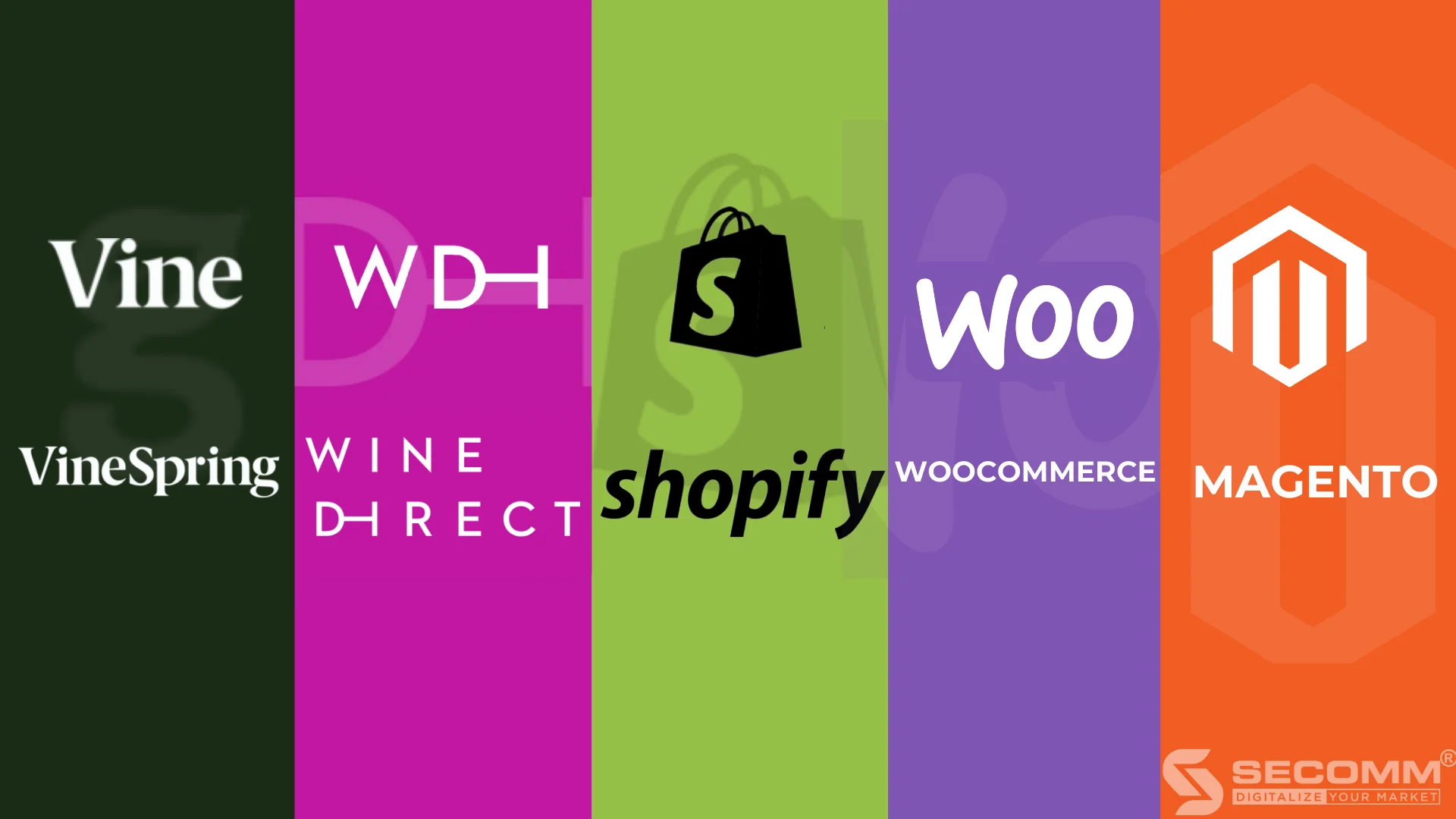
The electronic commerce market in the liquor industry is currently experiencing robust development and has become a dominant trend in many different countries. In 2021 alone, the number of alcohol consumers increased by 10–20%, and those following the trend saw a growth of 40–50%, indicating significant progress in eCommerce for the alcohol industry in recent times (according to Wine Intelligent).
Not only limited to user growth, the global eCommerce market for wine is expected to grow by 7.7% annually (according to Statista) and reach a value of 1.68 trillion by 2025 (according to Cision). This presents both an opportunity and a challenge for liquor businesses to grasp and develop a business model suitable for the changing market in the digital era.
To embark on an online liquor business, the selection of an eCommerce platform needs careful consideration and precise decision-making. Choosing the right platform aligned with the budget and objectives helps businesses save time in construction, utilise human resources efficiently, and save costs in building and developing the system. Simultaneously, it assists businesses in reaching a large customer base, boosting sales, and seizing sustainable development opportunities in the future.
Currently, there are primarily two types of eCommerce platforms on the market: open-source and service-based. Each type of platform has certain advantages and disadvantages, and businesses need to carefully weigh criteria that align with their business model to choose a suitable platform.
Wine products belong to the premium segment in modern life. Therefore, customers always prioritize high-quality visuals, and eye-catching, user-friendly interfaces in the eCommerce system that are easy to use and navigate.
Businesses in the liquor industry need to focus on conveying the product’s value message not only through a well-designed and user-friendly interface but also one that has high aesthetic appeal, with distinctive features to communicate the brand and product values to the specific target customers of the industry. This approach ensures a comprehensive user experience when using the eCommerce system.
eCommerce platforms should have a diverse range of features, from basic to advanced, and even specialized features tailored for the liquor industry. This facilitates the efficient and sustainable development of the eCommerce system for businesses. Basic features include management, storefronts, sales, information management, statistics, revenue control, customer lists, invoices, shopping carts, and checkout, as well as reporting and analysis.
Advanced features related to themes, products, marketing, optimized payment solutions, discounts, and shipping cater to the operational and developmental needs of sustainable eCommerce for businesses. Specialized features for the liquor industry may include product allocation, inventory control, membership management (Wine club memberships management), implementing customer loyalty programmes, and product-specific discounts based on business needs.
Read more: SaaS eCommerce platforms vs Open-Source eCommerce platforms
For a seamless online business system in the liquor industry, businesses often integrate eCommerce platforms with other software and technology platforms they currently use, such as payment systems, shipping, ERP, POS, CRM, marketing management, etc.
This requires the eCommerce platform to have flexible, seamless, and effective integration capabilities with this software without compromising the execution of each system. This integration not only helps businesses overcome manual operational limitations but also increases automation for both back-office management and sales processes, ensuring high accuracy and operational efficiency for the business’s development.
In addition to supporting Cash On Delivery (COD), platforms need to integrate various payment software, including local and international card options, payment gateways (Paypal, Stripe, One Pay, etc.), and digital wallets (Momo, ZaloPay, etc.). The chosen eCommerce platform should have the ability to seamlessly integrate this payment software with high security, safety, and efficiency.
For delivery and logistics, businesses can integrate service providers and popular transportation tracking applications, optimizing and streamlining delivery processes. Businesses can customize and develop delivery modes suitable for customers, ensuring a comfortable and convenient buying and receiving experience for users. Integrating payment and delivery software helps shorten the purchasing journey, optimize the user experience, and prompt customers to make decisions quickly.
Businesses can fully integrate third-party enterprise management software such as ERP, CRM, POS, etc., with the eCommerce system to support efficient and seamless multi-channel eCommerce operations. This synchronizes data on products, categories, orders, and user information across systems, simplifying and automating the back-office management and sales processes, ensuring high accuracy and operational efficiency for sustainable development.
In addition to the marketing tools available on the eCommerce platform, businesses can integrate additional marketing tools such as email marketing software (MailChimp, Drip, etc.), marketing analysis software (Google Analytics, Google Adwords Keywords, etc.), and social media management software (Buffer, Hootsuite, etc.). Marketing management software helps businesses deploy marketing campaigns, attract customers, and increase conversion rates, maximizing both eCommerce and overall business revenue.
Choosing an eCommerce platform in the liquor industry with high scalability is crucial for businesses to grow sustainably. The platform should seamlessly accompany the business through various business models, from entering eCommerce for the first time to expanding the business system. It should support diverse business models such as B2B, B2C, D2C, and B2B2C.
Furthermore, the platform should assist businesses in operating and expanding by supporting the management of multiple websites, catering to multiple countries, and handling various currencies, all within a unified system. Beyond that, platforms with high scalability not only support expansion but also ensure stable system operation even when the website experiences gradual increases in traffic over time or experiences sudden spikes in traffic during promotional campaigns.
VineSpring is an eCommerce platform created by experts with in-depth knowledge of the wine industry’s operations. As a result, businesses will have an online eCommerce system with specialized features for the wine industry.
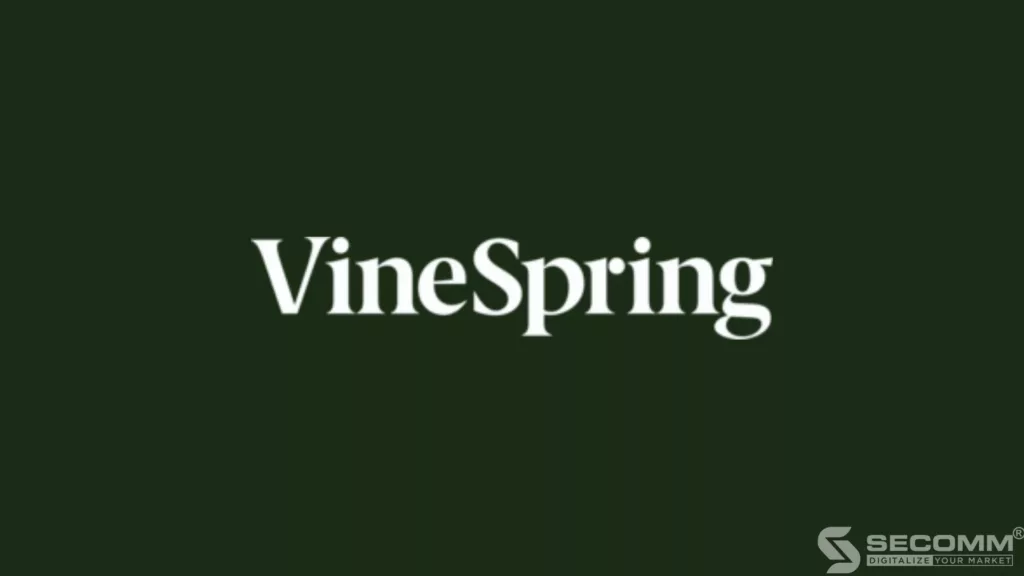
VineSpring offers a rich interface library, collaborating with various unique website designers specifically for the online wine industry. This allows businesses to easily build their brand without needing extensive technological knowledge.
Understanding the present needs of businesses, VineSpring has developed and optimized its platform to operate flexibly on various media, from desktops and tablets to personal mobile devices. This ensures businesses have a multimedia online presence and provides the best shopping experience.
With a CMS system on the VineSpring platform, businesses can fine-tune content and essential product information, brand details, and success stories tailored to their business development needs. This enables businesses to have a highly interactive website and a friendlier user experience.
The platform also supports businesses in terms of product shipping. VineSpring can integrate additional shipping software (ShipCompliant and ShipStation), assisting businesses in controlling information and making order tracking easy for customers on the website.
VineSpring directly integrates with Square POS software through an available technical team. The VineSpring POS system has a “tap, chip, and swipe” feature, enabling businesses to process orders quickly and conveniently. Additionally, VineSpring can integrate CRM software (Salesforce) to provide efficient solutions for management, sales, and customer care.
VineSpring supports businesses in marketing through the integration of email marketing software (Mailchimp) for list management and the creation of email marketing campaigns, increasing automation in operations.
Vinspring has a system of basic and some advanced features sufficient for businesses to operate at a basic level. Especially, Vinespring has optimized inventory management features to save time, allowing businesses to access production history details, including information on bottling times, prices, and shipping units.
Vinespring is an ideal solution for developing a business’s recurring revenue model in the eCommerce wine industry. The platform provides businesses with specialized features, such as wine allocation management and wine club member management.
In addition to the mentioned advantages, Vinespring also has a dedicated customer care team. As a Software as a Service (SaaS) eCommerce platform, VineSpring places a strong emphasis on customer service through 24/7 online chat with experts and telephone support anywhere, anytime. Therefore, businesses will receive the best and fastest support to resolve technical issues, as well as applications, features, and the most convenient and suitable solutions.
VineSpring is a Software as a Service (SaaS) platform, so businesses need to pay a fixed monthly fee ranging from $99 to $399, depending on the service package, and may be higher based on business needs:
The VineSpring platform (SaaS) is suitable for wine businesses with limited experience in building eCommerce systems. However, the usage fees for this platform are relatively high for small and medium-sized businesses.
WineDirect is a Software as a Service (SaaS) platform designed for wine businesses with no experience in eCommerce platforms, helping manage every aspect of online sales and simplifying the business process.
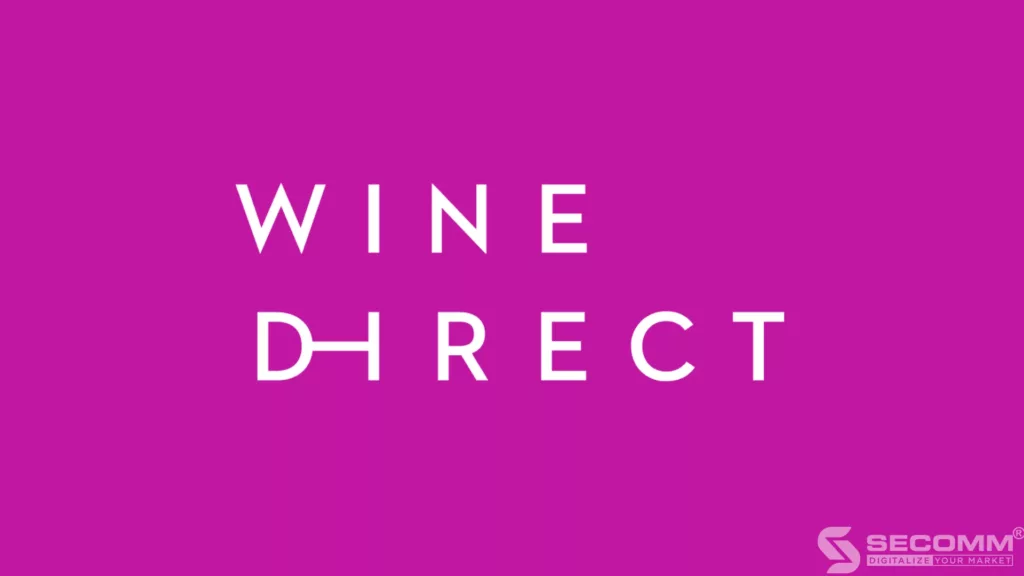
The WineDirect platform provides an intuitive, user-friendly interface tailored for businesses. Additionally, WineDirect offers a diverse range of free interface templates and features, facilitating easy development of the eCommerce system with just basic website development knowledge and skills.
WineDirect provides fundamental features such as website analytics, sales tools, and options for business event registrations to boost customer engagement. This allows businesses to save time and unnecessary costs associated with other software.
Businesses can possess essential information for creating customized offers and discounts tailored to each customer category, based on statistics gathered through integrated tools. Consequently, businesses can develop personalized shopping experiences and drive higher sales volumes, achieving outstanding results and meeting development needs.
The platform has leveraged and optimized the WineDirect application, specially designed for mobile devices and is highly flexible for the wine industry. Through the application, businesses can manage products, eCommerce systems, advertising campaigns on the website, and customer information.
WineDirect provides integrated payment solutions on the platform, enabling businesses to have a seamless experience across two payment software, such as WineDirect Payments for businesses in the US and Canada, and eWay Payments for businesses in Australia.
With payment software, businesses are supported in processing orders through the website or in-store. Regarding shipping, the WineDirect platform can integrate with various shipping services (UPS, FedEx, Gliding Eagle, etc.), assisting businesses with detailed shipping information for each order and enhancing automation in the shipping process.
The WineDirect platform can integrate with ERP software, as well as the POS of the business (WineDirect POS, Napa Valley, Oztera, etc.), aiming to synchronize data between the POS system and the eCommerce system, including orders, inventory, wine club members, customer information, helping businesses increase automation in the operational process and manage information effectively.
WineDirect has integrated available marketing tools on the platform to help businesses save time in system development. This includes providing businesses with access to real-time sales reports, allowing them to send emails based on customer groups depending on marketing campaigns.
The WineDirect platform is a SaaS (Software as a Service) eCommerce platform with three main pricing plans as follows:
Similar to VineSpring, the WineDirect platform (SaaS) is suitable for businesses of various models and sizes that lack extensive experience in building eCommerce systems and technology. However, one platform limitation is its high usage cost, which increases with the business’s monthly sales volume.
Beyond the high usage cost, operational tools on the platform may be unstable, occasionally displaying errors on the system, such as payment statuses showing as ‘pending processing’ on the business side but appearing as ‘paid’ on the customer side. Despite this, WineDirect has a dedicated customer support team that efficiently addresses business issues, making it a preferred choice for many businesses.
Shopify is a well-known giant in the field of building eCommerce systems as a Software as a Service (SaaS). The Shopify platform is favoured in the market for its user-friendly nature, quick system-building time, and low initial costs, making it suitable for a wide range of businesses.
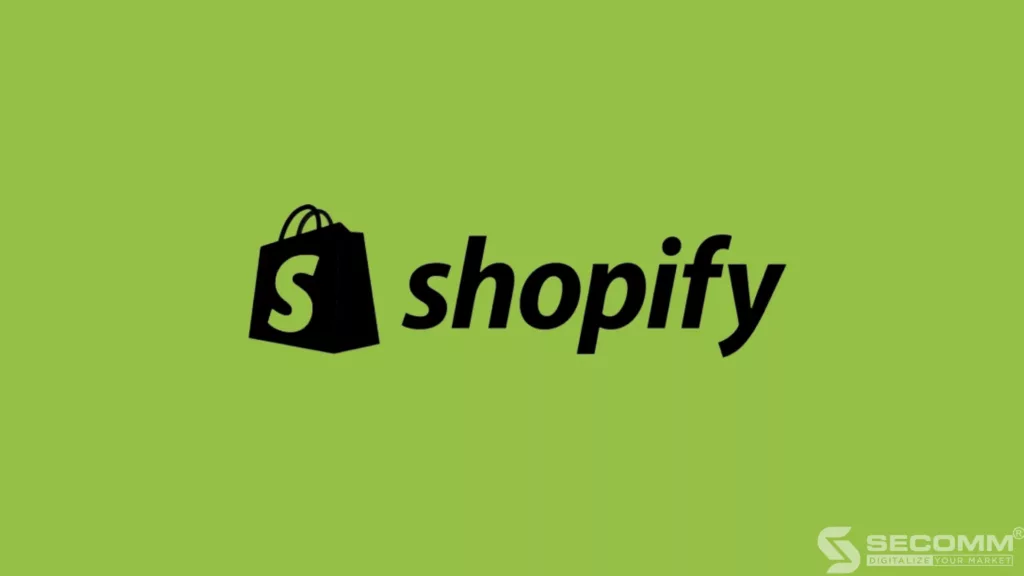
In terms of interface, Shopify provides many beautiful themes that are well-compatible across various devices. Businesses in the wine industry can choose from several specialized templates designed and offered specifically for online wine businesses by the Shopify platform. Additionally, businesses have the freedom to customize the interface by accessing HTML and CSS code to enhance the brand’s uniqueness. Therefore, businesses can deliver a seamless experience across different devices without affecting the user’s shopping process.
Basic and Advanced Features:
In addition to basic features related to orders, products, categories, and product management, the Shopify eCommerce platform allows businesses in the wine industry to access profiles and purchase histories to gather customer information. This enables businesses to personalize the shopping experience, from personalized content and product displays to the entire eCommerce journey.
This key aspect helps businesses make a positive impression on consumers and fosters a stronger relationship between both parties. Furthermore, with the mobile application developed by Shopify, businesses can control every aspect of the online store anytime, anywhere, including effective sales management, order fulfilment, and inventory management.
In addition to supporting direct payment features from the platform itself (Shopify Payment), Shopify also assists businesses in integrating other payment software such as Paypal, Stripe, SagePay, AliPay Global, etc. Regarding shipping software, Shopify collaborates directly with various major shipping service providers like USPS, UPS, and DHL to streamline the process and ensure more convenient shipping for businesses.
Shopify’s Global ERP Program provides businesses with a system that connects multiple eCommerce platforms with critical business databases such as finance and inventory to optimize operations and business processes. This program includes partnerships with leading global ERP providers such as Microsoft Dynamics 365, Business Central, Oracle NetSuite, Infor, Acumatica, and Brightpearl.
Shopify supports businesses in marketing through integrated software within the system. Examples include email software (MailChimp), sales channels (Facebook, Instagram), advertising (Google Ads), etc. Through these integrated marketing tools, businesses have the opportunity to increase sales, automate email marketing, and develop marketing campaigns tailored to specific customer groups.
Shopify has developed various service plans suitable for businesses to choose from based on their capabilities and scale:
In addition, Shopify has introduced other service plans to cater to diverse business needs:
Originally an industry giant in the Software as a Service (SaaS) eCommerce sector with characteristics of rapid system development time, as well as a startup cost suitable for many businesses and easy usability, this platform is suitable for small and medium-sized enterprises with limited experience in information technology.
However, in addition to the monthly fees for using additional utilities, Shopify also has limitations in terms of advanced features, unique features, and customization. Businesses must accept that certain features may not be available on the current website and may need to switch platforms when aiming to build a specialized system that aligns with their specific needs and ensures sustainable development in the future.
Read more:
WooCommerce is an open-source Content Management System (CMS) known as a plugin for WordPress, introduced in 2011. It is completely free and allows businesses to turn their WordPress website into an online store. Therefore, in addition to being suitable for customizing the interface, WooCommerce is also an ideal platform for businesses to have a website with a flexible blog section, high interactivity, and a more user-friendly experience.

WooCommerce possesses and provides businesses with a rich library of forms designed for the wine industry, carefully crafted and user-friendly. Therefore, businesses can conveniently design and build an eCommerce system right from the beginning without needing in-depth technical knowledge
With the WooCommerce platform, businesses can integrate tools from management systems to features specific to the wine industry. For instance, the platform can integrate with Product Table, a tool that allows wine businesses to have an interface displaying product attributes and numerous high-quality product images, as well as filtering features.
WooCommerce allows and supports basic features such as inventory management, order processing, inventory optimization, SEO tools, discounts, price reductions, sales statistics reports, and easy integration with payment and shipping providers. In terms of advanced features, the WooCommerce platform supports businesses in the wine industry with opportunities for wholesale orders and discounts, boosting sales through the eCommerce system. However, the platform has some limitations in terms of specialized features for the wine industry, as making certain edits can potentially cause instability in the system.
For payments, businesses can use plugins to integrate payment gateways such as Stripe, PayPal, Apple Pay, and Square into the system, ensuring high security and safety.
Regarding shipping, businesses can integrate with various shipping providers that collaborate with WooCommerce, such as FedEx, UPS, and USPS, enabling efficient processing and optimization of the shipping process to provide the best shopping experience for consumers.
The WooCommerce platform allows and supports businesses with integrable business management software, typical examples being Odoo, Square POS, and WP ERP. This enables businesses to save time, and costs, improve business efficiency, and automate management processes.
Businesses can integrate marketing management software to support their operations, such as email marketing (MailChimp), advertising (Google Listings, Google Ads, Facebook), and analytics software (Google Analytics). This helps businesses increase traffic, promote repeat shopping, and optimize personalization for consumers.
The WooCommerce platform is an open-source platform, and thus, the platform itself is entirely free to use. However, businesses may incur development costs when utilizing the platform, such as domain registration fees ($15), hosting fees ($120/year), and system development costs (ranging from $3,000 to $10,000 depending on the complexity of the system).
WooCommerce is a suitable platform for wine businesses already familiar with WordPress and looking to expand their eCommerce systems, offering numerous basic features built with high availability from developers in the strong global community. However, WooCommerce is not perfect for businesses with a large number of products, as the system tends to be unstable with more than 2,000 SKUs.
The platform also has limitations in terms of customization and fine-tuning specific features because intervening adjustments can easily lead to system instability, and there is a high likelihood that the built-in features are not compatible with this platform. Additionally, to customize the system based on the available feature set, businesses may encounter significant difficulties and time-consuming efforts.
Magento is an open-source eCommerce platform known as one of the leading eCommerce platforms today, with many outstanding advantages such as high flexibility, a diverse ecosystem, and optimal security. Currently, Magento has two versions: Magento Open Source (free) and Magento Commerce (paid).

With the Magento open-source eCommerce platform, businesses may not have access to an extensive theme library as other eCommerce platforms do. However, businesses can fully customize the interface for a specialized eCommerce system, providing a comfortable user experience. To achieve this, businesses need an experienced technical team and careful investment.
The Magento eCommerce platform offers a highly diverse and advanced feature system, from basic to advanced, making it easy for wine industry businesses to quickly build and develop their systems in the short term and sustainably in the long term.
A variety of features ranging from Category Management, Content Management, Customer Management, Marketing Management, Order Management, Store Management, System Management, Cart and Checkout, to Reporting & Analytics.
Magento is known for its superiorly developed advanced features and extensions to meet the rapid development of the eCommerce market and the specialized requirements of each business. Thousands of advanced functions related to themes, products, marketing, optimal payment solutions, shipping, etc., have been built with flexibility and high availability, delivering outstanding results when integrated into the system, and meeting every operational and sustainable eCommerce development need of businesses.
Businesses can completely modify system functions, develop new specialized features to meet business needs, and quickly adapt to market changes. In addition, businesses can comfortably expand the scale of their business with the open-source Magento platform.
Regarding payments, wine industry businesses using the Magento eCommerce platform can integrate the most common payment methods such as card payments (ATM, Visa, Master…), e-wallets (Momo, Zalo Pay…), and payment gateways (OnePay, VNPay, PayPal, etc.), helping diversify the shopping payment experience.
For shipping, businesses can easily integrate with various shipping providers and popular shipment tracking applications on the market to optimize shipping and delivery processes. Additionally, wine industry businesses can develop shipping and delivery features tailored to their needs and customers to provide a convenient and fast delivery experience.
Magento is praised for its highly effective operation with most POS (Square…), CRM (Salesforce…), and ERP (SAP, Oracle, Odoo) systems. Through efficient integration of these software solutions, businesses can overcome manual operation limitations and increase automation for both back-office management and sales, ensuring high accuracy and operational efficiency for sustainable development.
For marketing management software, businesses can integrate various management software solutions, including email marketing (Mailchimp…), and advertising (Facebook, Google…), to support planning marketing programs, strategy setting, as well as handling and controlling data, seamless eCommerce business processes, and optimizing online business.
Additionally, Magento provides Magento BI tools or allows businesses to integrate with other Business Intelligence (BI) tools such as Power BI, Tableau, Looker, etc., to optimize business efficiency, easily consolidate and leverage data from the Magento system and other software for quick, efficient analysis and reporting, and to improve business strategy and growth optimization for the enterprise.
Inheriting the high scalability of the open-source platform, Magento can accompany businesses with every sustainable development business model, from newly established enterprises to expanded business systems, covering various business models such as B2B, B2C, D2C, and B2B2C.
Magento can support businesses to operate and expand into multiple websites, countries, and multiple currencies, and manage all within one system. Not only that, Magento also supports stable system operation even when the website experiences gradual or sudden increases in traffic over time or during peak periods in promotional campaigns, with the ability to handle up to 500,000 products and thousands of transactions per hour.
Magento is an ideal platform for any business venturing into the wine industry and implementing eCommerce. However, the cost issue is a significant obstacle, preventing most small and medium-sized wine businesses from choosing the Magento platform to build an eCommerce system.
According to estimates, a fully functional system developed on the Magento eCommerce platform typically incurs deployment and development costs ranging from $10,000 to $100,000 or more. In addition to the complex and advanced feature set, a crucial factor contributing to the higher deployment costs of Magento compared to other platforms is the requirement for an experienced and specialized team.
Magento is often the platform of choice for large businesses in the wine industry, whether B2B, B2C, or D2C, that already have an existing customer base and a long-term need for developing an eCommerce system. With this platform, businesses can continually develop components within the eCommerce system to ensure optimal operational efficiency and sustainable growth.
The high development costs, as well as the development timeline, which can range from 2-3 months to sometimes up to a year, are barriers that make it challenging for small and medium-sized businesses to comfortably choose Magento.
Choosing the right eCommerce platform is crucial in building an eCommerce system for businesses in the wine industry. This decision not only minimizes investment costs and shortens the time to build an eCommerce system but also helps businesses gain a competitive advantage in the industry and achieve sustainable growth.
On the other hand, an inappropriate platform choice can lead to significant time and cost investments for migration and platform conversion. Therefore, businesses need to consider their goals, and issues in the current model to choose the most suitable platform.
For small and medium-sized businesses, newcomers to the eCommerce market, or large businesses without the need to build a specialized eCommerce system, they can choose Software as a Service (SaaS) eCommerce platforms such as VineSpring, Winedirect, Shopify, or the open-source platform WooCommerce.
If businesses focus on industry-specific features such as developing a subscription revenue model and managing wine clubs, VineSpring and Wine Direct are suitable choices. WooCommerce is convenient for businesses that emphasize adjusting the interface. Shopify is suitable for businesses that want to quickly develop an eCommerce website with low initial costs.
For large businesses or those wanting to build a specialized eCommerce system tailored to the characteristics of their products, business model, or a platform that can accompany the sustainable development of the business, choosing comprehensive open-source platforms like Magento is necessary. With open-source platforms like Magento, businesses can develop special features, design interfaces freely, and not worry too much about the operating system.

SECOMM confidently accompanies wine businesses on the path of deploying and developing sustainable eCommerce, with successful implementation experience for many wine businesses in various countries such as Singapore, the United States, Australia, Japan, and Vietnam.
Contact SECOMM for detailed advice on the development journey of the eCommerce system for your wine business!
 2
2
 8,687
8,687
 0
0
 1
1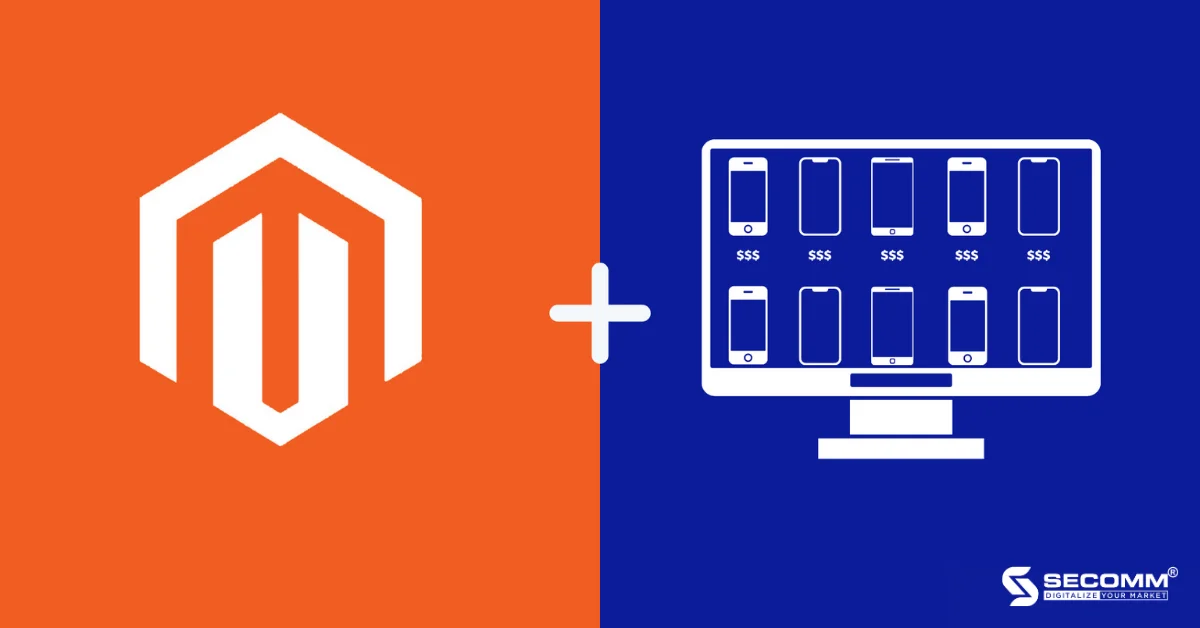
In 2022, the mobile phone retail market is predicted to reach sales figures of up to 1.39 billion units, marking a 3.8% annual increase (according to Trendforce). The Covid pandemic has significantly altered consumer interactions and shopping habits, shifting the purchase of mobile phones from offline to online. Traditional retailers have now caught up with this trend by embracing eCommerce to enhance their competitive edge and sustain growth regardless of the pandemic.
To enter the eCommerce market and seize competitive opportunities, businesses need to identify a suitable eCommerce platform aligned with their business objectives. Apart from popular names like Shopify, BigCommerce, Haravan, and WooCommerce, Magento is recognized as a platform chosen by major players in the mobile phone retail industry in Vietnam, such as CellphoneS, Phong Vũ, and Bạch Long Mobile. So, why is Magento the preferred choice for these businesses?
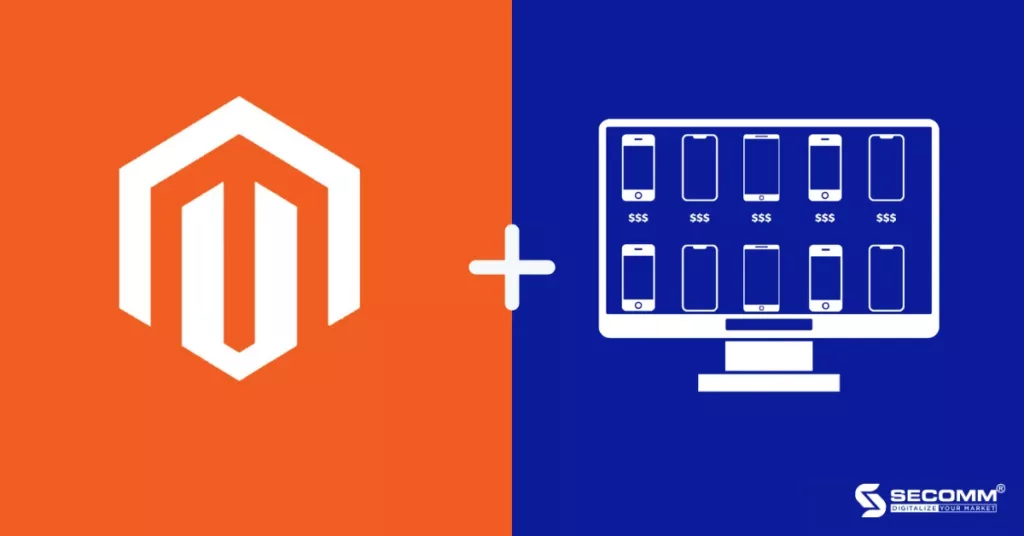
As a specialized eCommerce platform, Magento naturally offers a full range of basic features such as category management, content management, sales, customer management, marketing, inventory management, as well as reports and analysis. These features allow businesses to easily embark on their eCommerce journey in a short period.
Magento also possesses an ecosystem with many features supporting the development of in-depth mobile phone business systems.
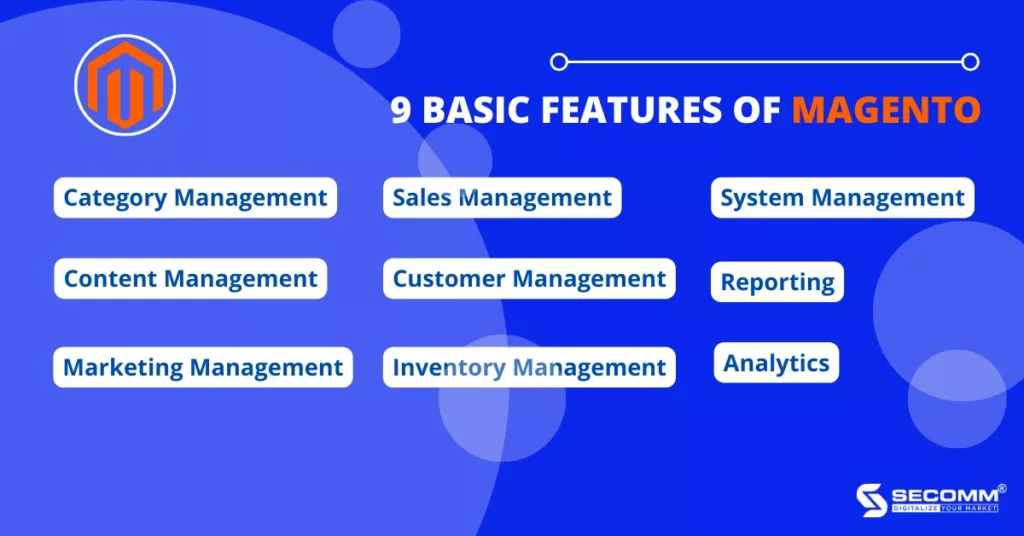
The Magento platform is known for its advanced features and extensive extensions developed to meet the rapid development of the eCommerce market and the specific requirements of each business. Thousands of advanced functions related to themes, add-ons, products, marketing, payment, shipping, etc., have been built with flexibility and high availability, delivering outstanding results when integrated into systems, meeting every operational need, and supporting the sustainable development of eCommerce for businesses.
Some advanced features for mobile phone retail that Magento supports include:
Flash Sale Feature: a discount mechanism for certain items or products within a specified time. The strategy of appealing to the customer’s psychology of “buy quickly, get a good price” is being effectively applied by many major mobile phone retailers. With Magento, businesses can easily create multiple Flash sales with countdown timers.
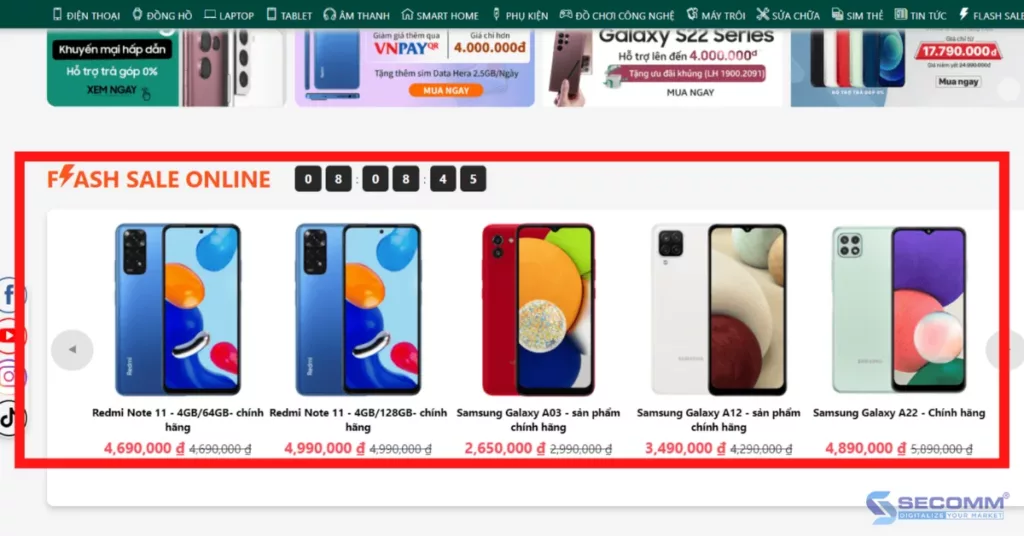
Buy Now Pay Later Feature: This is a popular payment method in the international online mobile phone retail industry but is relatively new in the Vietnamese market. After completing the order, customers will receive the product immediately, and the payment will be gradually made over a certain period with low or 0% interest. Breaking down the payment into instalments will reduce financial pressure on users when buying high-value products such as mobile phones, boosting the number of orders and revenue for businesses.
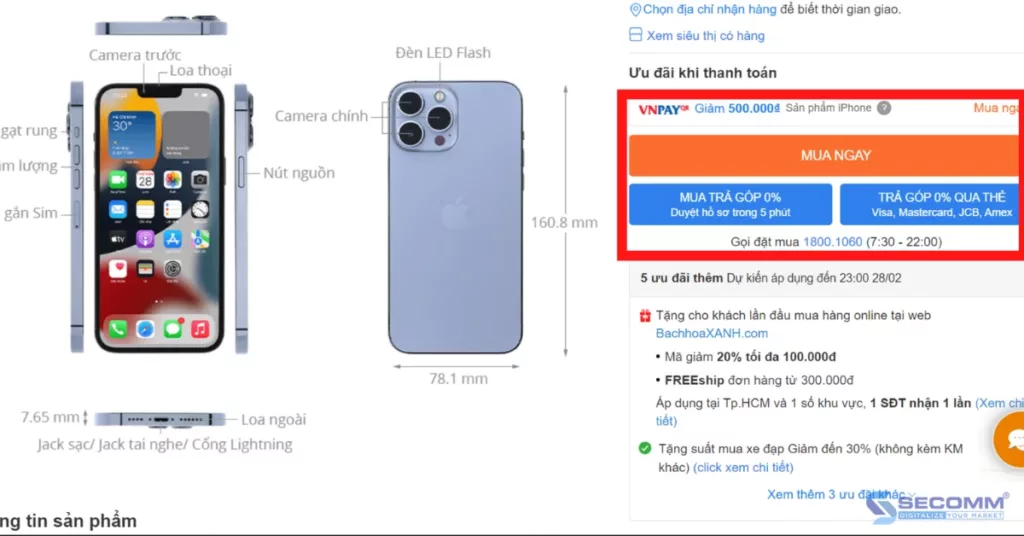
Advanced SEO Feature: In addition to supporting keywords, meta tags, descriptions, product titles, and searching for appropriate URLs, the Magento platform also updates ranking factors, provides URL structures, and offers meta deployment options to enhance SEO for eCommerce websites, increasing traffic and competitiveness in the market.
Mobile eCommerce is one of the industries that require an eCommerce website to have a sleek, standardized UI/UX interface with high aesthetics to convey brand and product values, attracting customers to shop within the system. Although Magento does not possess an extensive theme repository like some other platforms, each theme on the platform is meticulously and uniquely designed.
Businesses can choose to use these themes in the initial stages to save costs. To further refine the interface to better align with the brand’s positioning, businesses can customize based on the chosen theme or design a unique interface. However, this process will require more investment in terms of cost and time.
Magento supports stable system operation even when the website experiences a gradual increase in traffic over time or a sudden surge during business campaigns, with the capability to handle up to 500,000 products and thousands of transactions within an hour.
Furthermore, Magento also supports business expansion into multiple websites for various countries, all manageable on the same “dashboard.” This means that businesses can access and manage data for multiple websites/stores simultaneously using a centralized Magento system. With built-in language conversion support, businesses can build an eCommerce system with content and language tailored to diverse global customer demographics.
Moreover, the Magento system allows for easy conversion of currencies, supporting businesses in expanding their market presence across multiple countries and providing customers with a seamless transaction experience for optimal shopping.
In the eCommerce industry, especially in online mobile retail, having a variety of secure and flexible payment methods is crucial. Common payment methods include card payments (ATM, Visa, Mastercard), e-wallets (Momo, Zalo Pay), payment gateways (OnePay, VNPay, PayPal), cash on delivery (COD), etc. For delivery, Magento seamlessly integrates with various delivery services available both internationally and in Vietnam, such as FedEx, DHL, Giao Hàng Nhanh, Giao Hàng Tiết Kiệm, Viettel Post, along with popular shipment tracking applications. This ensures efficient handling and optimization of delivery processes. Furthermore, businesses can develop and customize new delivery features to align with customer preferences.
Aside from stable system operation during online business, efficiently managing products and orders is a crucial consideration for businesses. Integrating the website with enterprise management systems (ERP, CRM, etc.) minimizes manual operations and automates operational processes, ensuring high accuracy and operational efficiency for business development. Magento is highly compatible with various management software, such as POS (Square), CRM (Salesforce), and ERP (SAP, Oracle, Odoo), making it a preferred choice for many businesses.
One of the challenges in online mobile retail is intense competition, making it difficult to attract customers and climb the ranks on search engines. Magento can be seamlessly integrated with various marketing management software, ranging from email marketing tools (Mailchimp) to advertising platforms (Facebook, Google). Having a unified system for all sales channels on Magento enables businesses to easily control and leverage data, seamlessly transitioning business processes from offline to online. Consequently, businesses can develop and manage corresponding multichannel marketing strategies to personalize the customer experience and optimize eCommerce business.
Despite Magento being highly rated for its eCommerce features and performance, cost remains a significant barrier, preventing businesses from choosing the Magento platform for building e-commerce websites. It is estimated that a well-developed and efficient system on the open-source Magento e-commerce platform typically incurs deployment costs ranging from $10,000 to $250,000 USD.
Usage Cost Table for the First Year of Three Magento Versions:
Typically, a complete Magento project requires an implementation time frame of 3-6 months, sometimes extending up to a year. One reason for the prolonged development time is the complexity of the system’s functionality, demanding time to build suitable development solutions.
A fully functional and effective Magento website needs to be developed by an experienced team well-versed in Magento to build a comprehensive system and provide suitable solutions for the various long-term business requirements.
In summary, Magento is a comprehensive open-source eCommerce platform, specialized and suitable for various business models in the mobile electronic industry, including B2B, B2C, B2B2C, and D2C. Online mobile retail businesses can fully customize and control the system, from interface to features, providing the best experience for consumers through rich eCommerce features, a diverse ecosystem, and high flexibility and scalability.
However, budgetary constraints, time considerations, and the requirement for a highly skilled team also make it challenging for many businesses to utilize Magento for deploying eCommerce websites.
Contact SECOMM for a free consultation on developing an eCommerce system for mobile retail!
 2
2
 10,264
10,264
 0
0
 1
1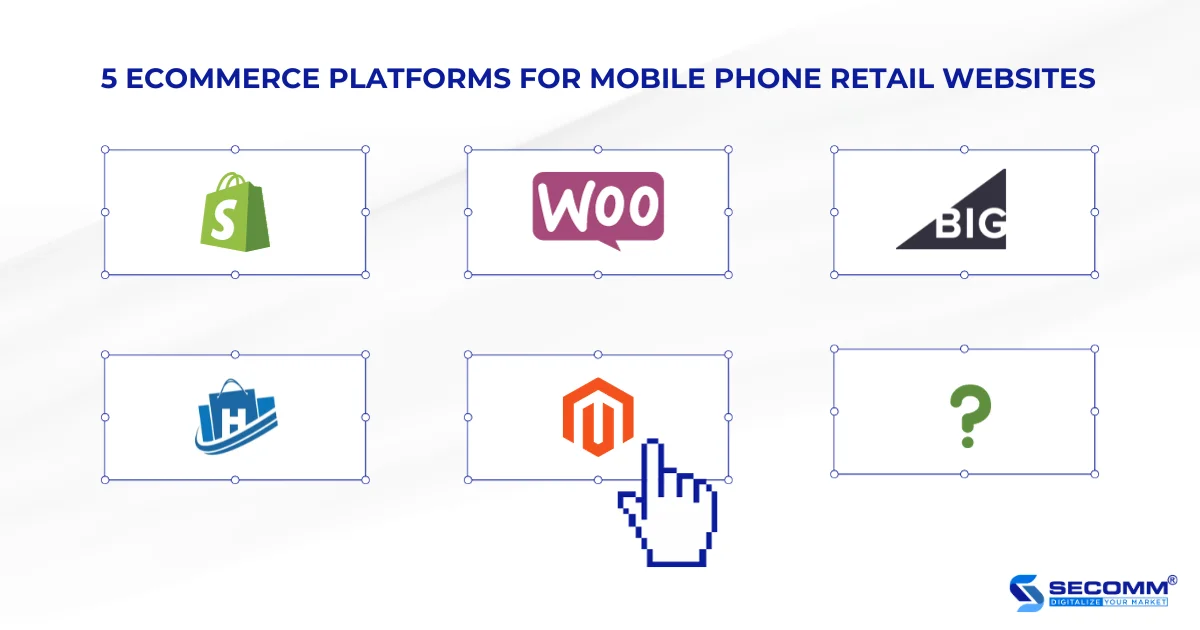
In recent times, eCommerce has been increasingly popular in the Vietnamese market and is becoming a potential business model pursued by many enterprises across various industries. Particularly in the mobile phone retail sector, the online market share of mobile phone retail systems is growing rapidly. For instance, The Gioi Di Dong – the largest mobile phone retail system in Vietnam, saw its online market share increase from 11.6% to 17.5% in just one month (from July to August 2021)
Nowadays, many mobile phone retail businesses in Vietnam often choose to implement eCommerce websites as their main channel in online commerce. Thanks to the effective development of website systems, many mobile phone retail businesses have not only seized the opportunity to boost revenue but also achieved sustainable business growth. The common factor contributing to this success lies in the eCommerce platform.
Each type of eCommerce platform has its unique features that can support businesses in developing their online presence. Software as a Service (SaaS) platforms are designed by providers with the entire system pre-built, including hosting, interface, features, and infrastructure maintenance. Therefore, businesses can easily build and operate a website system without much concern for technical issues and without investing too much time and money from the outset.
However, businesses using SaaS platforms will not own the source code and data, and the system’s scalability and integration capabilities are limited. Usage costs may increase over time. On the other hand, open-source platforms give businesses full ownership and control over the source code and data, allowing freedom in designing interfaces and offering high scalability and flexibility. Nevertheless, using open-source platforms often requires a specialized development team and more investment in terms of cost and time.
So, which eCommerce platform will be suitable for mobile phone retail businesses?
The user interface of an eCommerce system is considered the face and highest scoring aspect in online business. Therefore, besides meeting UI/UX standards and expressing the brand’s characteristics, products, businesses also need to focus on the presentation of product images on the website, ensuring synchronization and clarity.
This ensures a complete and satisfying experience for customers. The admin interface must be user-friendly, allowing easy navigation, control, and management of all data within the system.
With online retail of mobile phones, the eCommerce system’s feature set needs to be diverse, ranging from basic to advanced and specialized, aiming to provide an optimal experience for buyers and facilitate the efficient and sustainable development of the eCommerce system.
Some essential functions in the eCommerce website system for mobile phone retail businesses include:
To have a seamless online business system, businesses often need to integrate eCommerce platforms with other software and technology platforms they are currently using, such as:
The chosen eCommerce platform must have flexible, seamless, and effective integration capabilities with this software without affecting the execution level of each system. This integration helps businesses overcome the limitations of manual operation and increases automation for both back-office management and sales, ensuring high accuracy and operational efficiency for business development.
eCommerce platforms need to have high scalability to adapt and grow alongside businesses of all models. Choosing the right platform can accompany businesses from startup and SME stages to becoming large enterprises, and from B2B, B2C, and D2C models to B2B2C, helping save long-term budget while still building a sustainable, efficient system suitable for the business.
High scalability meets all future development needs of the business, such as expanding multiple websites, across countries, currencies, channels, etc. Moreover, platforms with high scalability ensure stable system operation regardless of increasing traffic and transactions over time.
Shopify is a well-known giant in the field of building eCommerce systems as a Software as a Service (SaaS). This platform is favoured for its user-friendly nature, quick build time, and low initial costs, making it suitable for many SMEs.

Shopify provides attractive, responsive themes suitable for various industries, including mobile phone retail. While adhering to UI/UX standards, it lacks customization options for businesses to showcase their unique branding.
The admin interface is user-friendly on desktops, allowing easy management of the website’s aspects. However, mobile functionality is limited, restricting businesses to perform specific functions on the mobile version.
Shopify’s functionality system is comprehensive, meeting both the basic and advanced needs of small and medium-sized enterprises. However, accessing advanced features requires additional monthly payments, leading to increasing usage costs. Shopify, however, lacks certain features crucial for mobile phone retail, aside from instalment payment options.
Shopify restricts access to the source code, making integration with third-party software challenging. Businesses can only integrate with partner software available on the platform or those directly developed by Shopify.
Scalability on the Shopify platform is limited because businesses cannot modify or upgrade the website source code. Therefore, it’s often used by mobile phone retail businesses in their early stages.
Shopify offers various service packages to cater to different business needs, ranging from $29/month for Basic Shopify to $2000/month for Shopify Plus. However, businesses may face limitations in advanced features, necessitating a platform switch for a specialized and sustainable system.
→ Overall Rating based on 5 criteria: 2/5
Shopify is suitable for SMEs that want a cost-effective and quick eCommerce system. However, it falls short in advanced features, specific functionalities, and customization options. Businesses must accept the limitations and be prepared to switch platforms for a tailored and sustainable solution in the future.
WooCommerce is an open-source CMS plugin for WordPress introduced in 2011, completely free, enabling businesses to turn their WordPress websites into online stores.
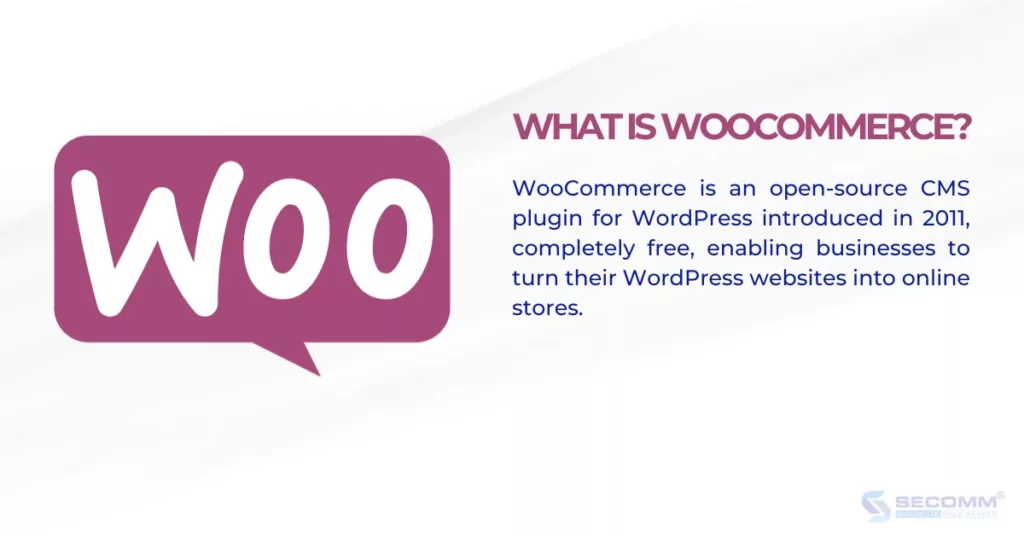
WooCommerce offers a diverse library of templates for mobile phone retail and electronic goods, designed meticulously and user-friendly. This allows businesses to conveniently design and build an eCommerce system from the start without requiring in-depth technical knowledge.
Because WooCommerce is a WordPress plugin, administrators continue to manage the website through the WordPress interface, making it easy for businesses already using WordPress to adapt, use, and navigate the system.
WooCommerce has many features, both basic and advanced, to support businesses in operating an eCommerce website. However, the platform has some limitations regarding specific features for mobile phone retail. Although it’s open-source, developing unique features on WooCommerce can be challenging and may lead to system instability.
Third-party software integrates well with WooCommerce, helping businesses save time, and costs, improve operational efficiency, and automate management processes.
WooCommerce’s most significant drawback is its limited scalability. The platform tends to become unstable and easily overloaded when there are more than 2,000 SKUs or too many themes and plugins on the system.
WooCommerce is an open-source platform, so it’s entirely free to use. However, businesses need to pay for additional services such as domain registration ($15), hosting fees ($120/year), and system development costs (ranging from $3,000 to $10,000, depending on system complexity).
→ Overall Rating based on 5 criteria: 3/5
WooCommerce is a good platform for businesses currently using WordPress and looking to develop an eCommerce system. However, the platform has limitations in customization and adjusting unique features. Intervening in the system is likely to cause instability, and there is a high probability that the built-in features are not compatible with the platform. Additionally, to customize the system based on the existing feature set, businesses will need to invest a significant budget and time.
BigCommerce is a SaaS platform based in the USA with over 600,000 online stores used by consumers worldwide.
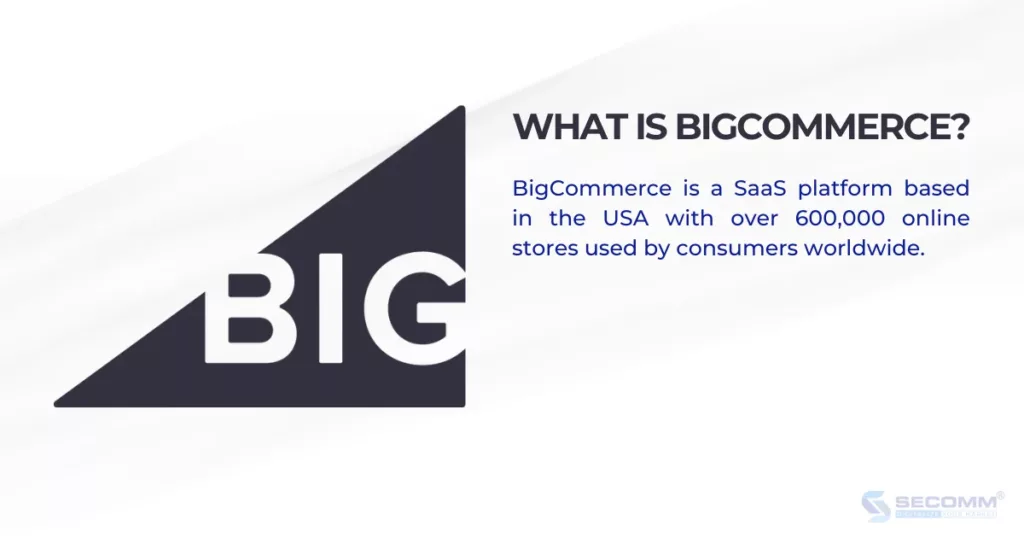
BigCommerce possesses a diverse theme repository with over 160 templates, catering to various industries, including mobile phone retail and electronics. All these templates are designed following UI/UX standards, allowing for easy adjustments to fit the brand.
For the administrator interface, businesses can manage their stores on a real-time and easily trackable screen.
BigCommerce’s functionality is relatively comprehensive, meeting basic and advanced needs, as well as specific features for mobile phone retail businesses. However, since BigCommerce is a SaaS platform, businesses cannot modify the source code or develop additional features not already available on the platform. Businesses can only use the features provided by BigCommerce or those offered by the platform’s partners.
Some notable advanced and specific features available on BigCommerce suitable for mobile phone retail businesses include multi-currency support, advanced SEO, rating and review features, advanced reporting, and instalment payment capabilities.
BigCommerce has a relatively high integration capability, allowing integration with many popular third-party software to support business operations.
Some software that can be integrated with BigCommerce includes various payment gateways (Stripe, PayPal, ApplePay, Checkout), shipping solutions (ShipStation, Amazon Shipping, Easyship, Route), ERP systems (NetSuite ERP, Acumatica Cloud ERP), CRM (HubSpot, Revamp), and marketing tools (email marketing, social media integration).
The system’s scalability depends on the BigCommerce service package that the business is using. The platform can support business expansion into new markets, multiple currencies, and languages. Additionally, BigCommerce can support stable system operations for businesses handling thousands of SKUs.
BigCommerce currently supports three bundled solutions and one on-demand solution:
→ Overall Rating based on 5 criteria: 3/5
BigCommerce is almost a comprehensive SaaS platform for businesses entering the mobile phone retail eCommerce journey. The platform can be suitable for various business models, including B2B, B2C, and B2B2C, depending on the chosen subscription package. However, the limitation of using this platform is that businesses are restricted in their ability to customize functions on the system, limited in annual revenue with each subscription tier, and unable to own the source code.
Haravan, founded in 2014, stands as one of the renowned platforms in the Vietnamese market, boasting over 50,000 businesses and consumer brands. It operates as a service platform modelled on Shopify.
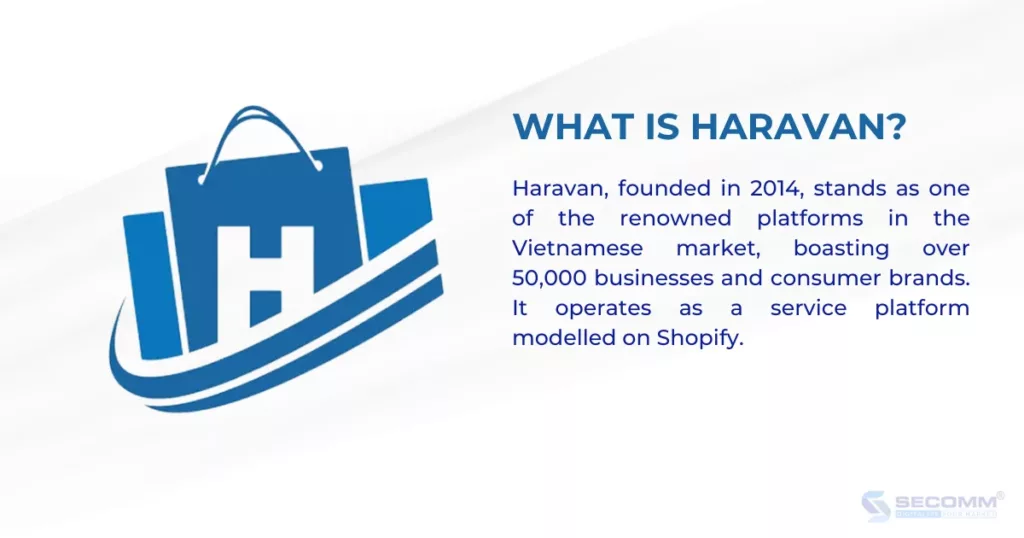
Similar to other SaaS platforms, Haravan boasts a diverse theme repository with over 400 templates, all designed following UX/UI standards. Beyond that, businesses can customize the interface to align with their distinctive brand identity. The admin interface, supporting the Vietnamese language, ensures a user-friendly experience for businesses.
Haravan offers a comprehensive set of both basic and advanced features, enabling businesses to swiftly establish an eCommerce website. The platform includes specific functionalities tailored for mobile phone retail, such as installment payment options. However, akin to Shopify and BigCommerce, businesses cannot develop additional features beyond what Haravan offers in its repository.
Integration with third-party utilities outside Haravan’s ecosystem can be challenging, representing a significant limitation of service-type platforms. However, it does support integration with widely used services in Vietnam, including various payment methods (Momo, VNPay, ZaloPay, etc.), shipping services (Giao Hàng Nhanh, Viettel Post, DHL), and management tools (CRMViet, Teamcrop).
Haravan’s scalability is limited; it supports multilingual and multi-currency features but lacks the capability to expand to multiple websites or efficiently manage extensive data on the platform.
To use Haravan, businesses need to pay a reasonable monthly fee ranging from 200,000 VND to 3,000,000 VND, depending on business needs:
→ Overall Rating based on 5 criteria: 3/5
Haravan is a suitable platform for businesses in Vietnam with limited technology experience and budget constraints. However, as businesses grow, Haravan may not provide sufficient functionality to sustain operations. Eventually, transitioning to more specialized platforms like Magento, WooCommerce, or OpenCart becomes necessary, albeit with challenges such as costs, time, and human resources.
Magento is an open-source eCommerce platform with deep expertise in online commerce. It currently offers two versions: Open Source (free) and Commerce (paid). Recognized as one of the most comprehensive eCommerce platforms, Magento boasts diverse features, high flexibility, scalability, a diverse ecosystem, and optimal security.
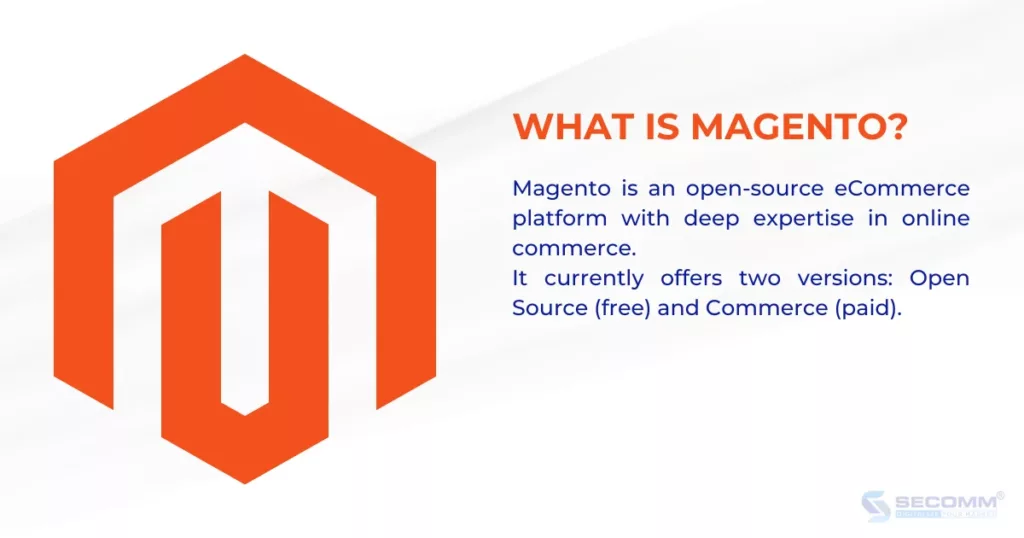
Unlike other platforms, Magento doesn’t have an extensive theme repository. However, each theme is meticulously designed, unique, adheres to UX/UI standards, and emphasizes high aesthetics to convey brand and product values, attracting customers to the system.
Businesses can save costs and time by using available themes, while also having the option to customize for brand identity. Additionally, businesses can fully design their interface, enhancing brand recognition, though this requires careful investment in design time and costs.
For the admin interface, Magento 1 was criticized for being challenging to use. However, Magento 2 introduced a more intuitive dashboard, making navigation easier, user-friendly, and adaptable.
Magento’s eCommerce platform has a diverse and deep feature system, catering from basic to advanced and specific functions. This allows mobile phone retail businesses to easily and rapidly build and develop their system in the short and long term. Basic functions include Category Management, Content Management, Customer Management, Marketing Management, Order Management, Store Management, System Management, Cart and Checkout, and Reporting & Analysis.
Specialized features include support for multiple languages, currencies, stores, Progressive Web Applications (PWA), Multi-Source Inventory (MSI), ElasticSearch, etc., enhancing the customer experience and accelerating the shopping process.
Magento excels in easy integration with third-party software for payments (credit cards, e-wallets, payment gateways, cash on delivery), shipping (Fedex, DHL, local carriers), management software (POS, CRM, ERP), and marketing tools (email marketing, advertising).
Magento ensures stable system operation even with increasing traffic over time or sudden spikes in business campaigns. It can handle up to 500,000 products and thousands of transactions within an hour. Magento supports the expansion of multiple websites for various countries, all manageable on one screen, allowing businesses to access and manage data for multiple websites/stores simultaneously.
One significant limitation for mobile phone retailers opting for Magento is the high initial development cost. A fully functional Magento system development is estimated to range from $10,000 to $100,000. Beyond complex and advanced features, the need for an experienced professional team contributes to the higher implementation costs compared to other platforms.
→ Overall Rating based on 5 criteria: 4/5
Magento is a comprehensive platform suitable for mobile phone retail businesses, whether B2B, B2C, or D2C, especially those with an existing customer base and a desire to develop a long-term eCommerce system. With Magento, businesses can continuously develop components of the eCommerce system, ensuring optimal performance and sustainable growth.
Choosing the right platform for eCommerce is crucial for mobile phone retailers. An accurate choice helps businesses shorten development time, save costs, and maximize resources to achieve the highest revenue levels. SECOMM understands the challenges facing mobile phone retail businesses and provides expert advice.
Contact SECOMM now for a free consultation!
 2
2
 10,945
10,945
 0
0
 1
1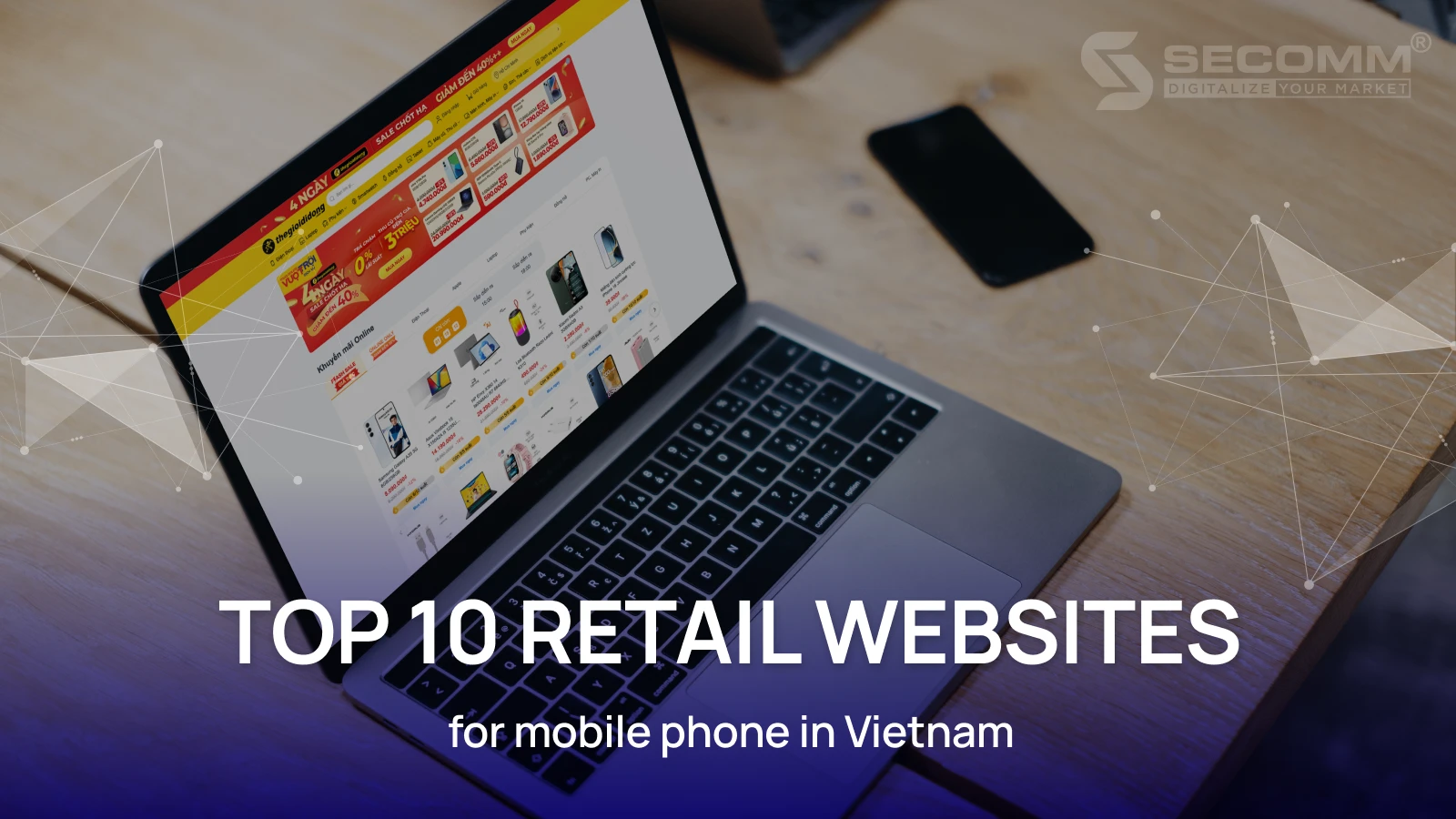
The retail market for mobile phones in Vietnam is booming like never before! With 61 million users, Vietnam is currently among the top 10 markets with the highest mobile phone usage in Asia. Furthermore, this market is predicted to grow in 2022 by 47.5% (according to Trendforce).
Taking advantage of this opportunity, many retail businesses in Vietnam have achieved tremendous success and continuously expanded their scale, such as The Gioi Di Dong, FPT Shop, Viettel Store, etc.
To contribute to this success, one cannot ignore e-commerce. Online sales channels such as websites, mobile apps, and e-commerce platforms play an increasingly important role for retail businesses in the mobile phone industry, especially post-pandemic.
According to Debasish Jana, an expert from the market research company Counterpoint Research, online sales of mobile phones have increased compared to the same period last year, accounting for 14% of the total market share. Not stopping there, the growth rate of online mobile phone retail is projected to increase even further shortly, reaching 29% by 2025 (according to Google, Temasek, Bain & Company).
E-commerce helps retail businesses develop their business models and contributes to revenue growth for enterprises.
The Gioi Di Dong is a brand under the company The Gioi Di Dong Joint Stock Company, established in 2004. According to Euromonitor International, The Gioi Di Dong is the largest online retail company in Vietnam, holding a 10% market share. It is also the leading retail chain for mobile devices in Vietnam, with approximately 1,000 stores present in all 63 provinces and cities nationwide.
Currently, this retail business is heavily investing in online sales systems such as websites and apps.

CellphoneS is a retail system for well-known technology products in Vietnam. Currently, the business has a presence in Ho Chi Minh City, Hanoi, Binh Duong, Hai Duong, Hai Phong, Bac Ninh, Vinh Phuc, Thai Nguyen, and Vung Tau.
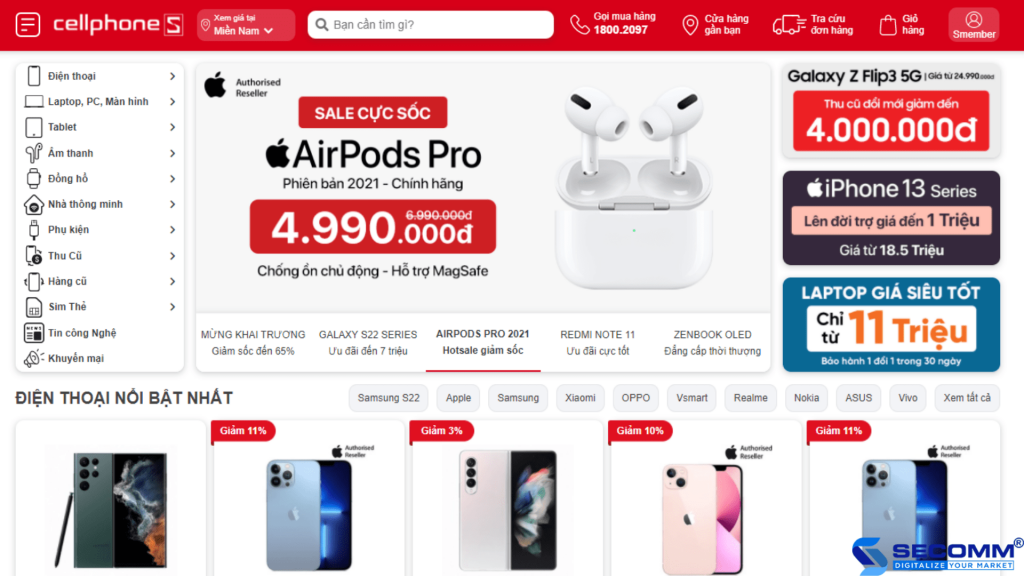
FPT Shop is under the ownership of FPT Corporation Vietnam, established in 2012. It is an officially authorized dealer of Apple in Vietnam at the highest level, specializing in providing genuine electronic products. Currently, the retail chain system spans across the country with stores in all 63 provinces and cities.
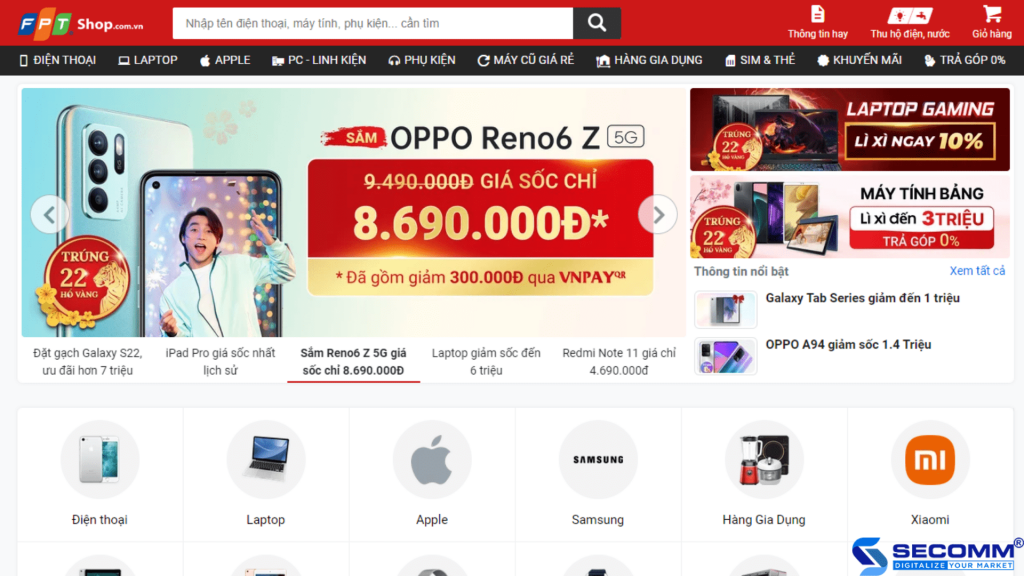
Hoang Ha Mobile is a retail system specializing in providing genuine technology products and well-known mobile phones in Vietnam, established in 2014. Currently, the business has over 90 branches spanning from the North to the South.

The Mobile Technology Company Limited operates the Didongviet.vn retail chain, established in 2009 as a reputable system specializing in genuine technology products, notably mobile phones, tablets, laptops, accessories, and components.

Viettel Store was launched in 2009 with thousands of continuously updated products to meet the online shopping needs of customers nationwide. With over 200 stores, Viettel Store’s retail system provides a wide range of high-tech devices and products, including mobile phones, laptops, tablets, and medical equipment.
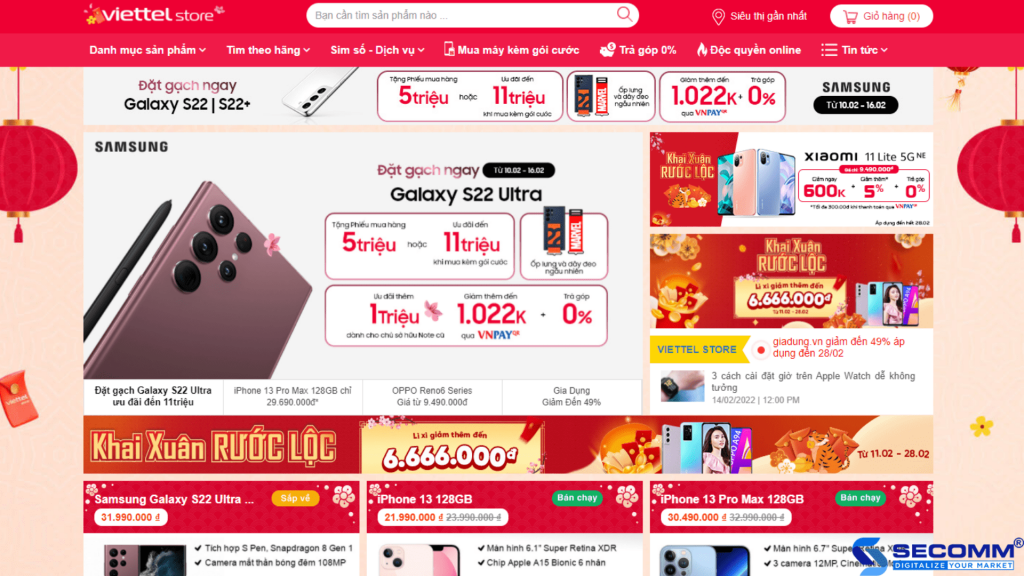
Sony is one of the most globally renowned brands in consumer electronics, thanks to its revolutionary innovations and product quality. After 21 years in Vietnam, Sony has established a retail system consisting of 11 Sony Shops and Sony Centers, over 160 official dealers, and 70 authorized service stations spread across the country.
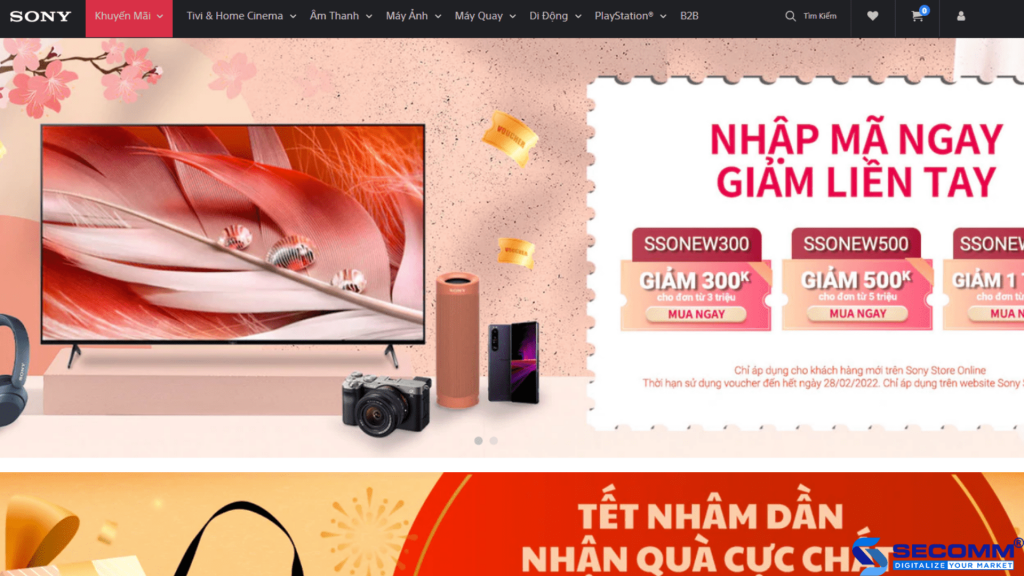
Phong Vũ is known as a long-established and reputable retail unit in Vietnam since 2007, with over 30 stores nationwide. Specializing in the business of information technology products, gaming and entertainment devices, office equipment, and high-tech devices from various major brands.

Mobile City is one of the popular retailers of smartphones, tablets, and technology accessories in Vietnam, with over 10 years of experience.
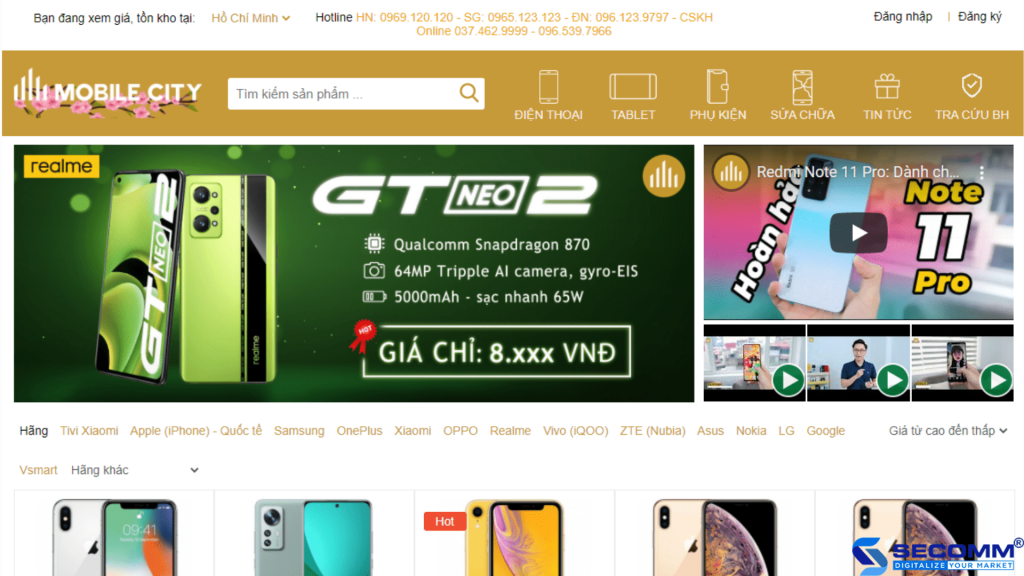
Clickbuy is a retail system offering well-known technology products in Vietnam, established in 2012. Currently, Clickbuy has expanded to include 5 stores and 2 modern service centers in Hanoi and Ho Chi Minh City.
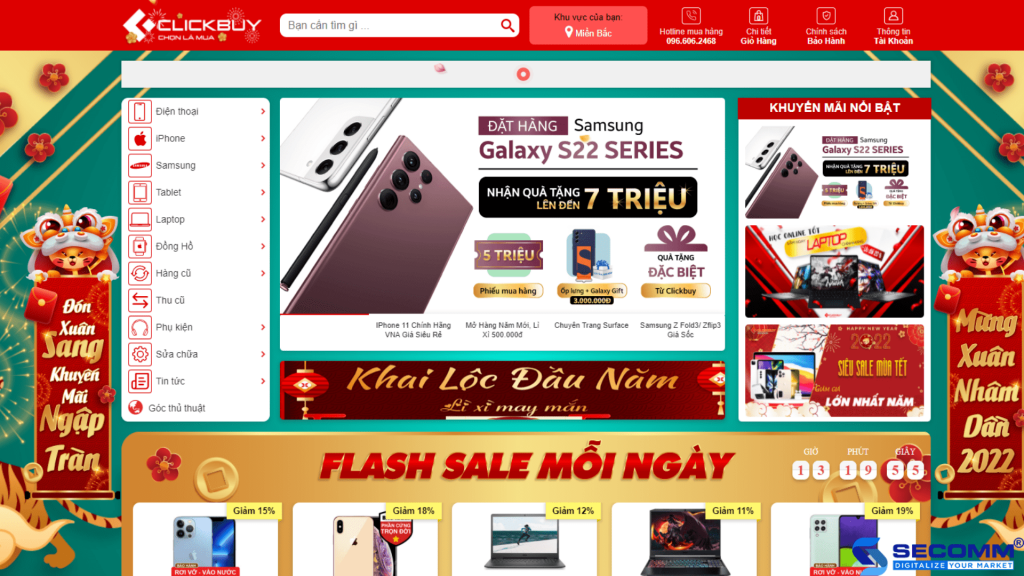
Online business in the mobile phone industry presents numerous growth opportunities. However, to succeed, businesses need a partner with extensive experience in the e-commerce landscape.
With a successful track record in implementing complex e-commerce systems, SECOMM understands the challenges that businesses face.
Contact us now for a free consultation on comprehensive e-commerce system development solutions!
 45
45
 40,810
40,810
 0
0
 13
13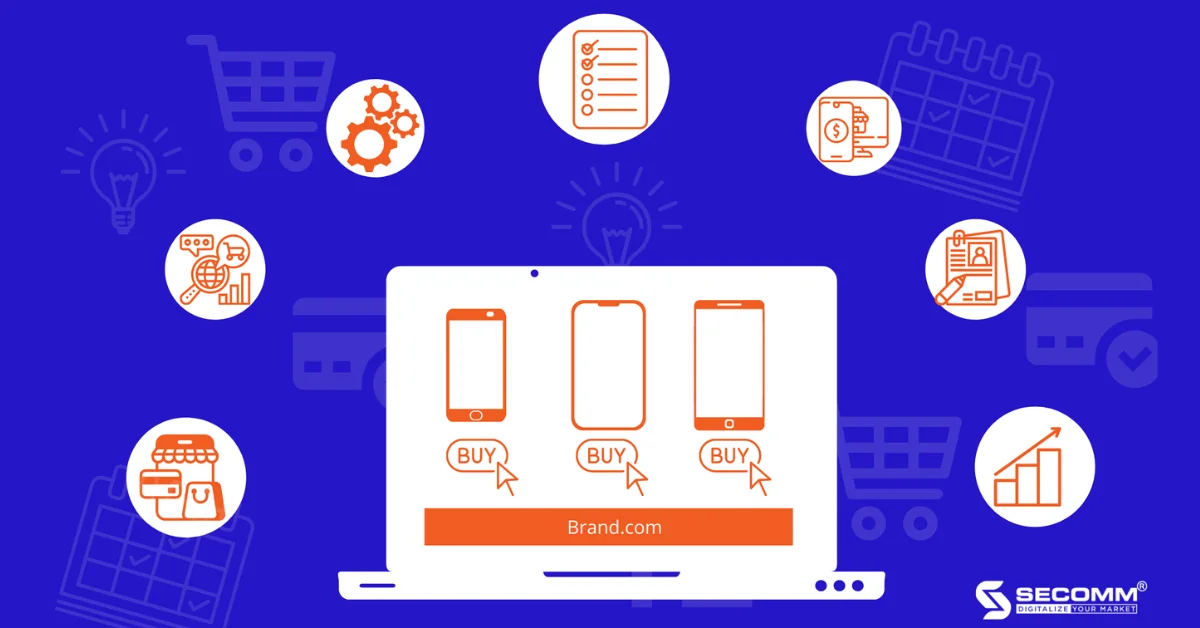
The COVID-19 pandemic has shifted shopping trends from traditional stores to online channels. Due to the pandemic, the demand for electronic products such as phones, laptops, and tablets has increased. This has helped mobile phone retail businesses achieve high revenue growth and profitability.
The “leap” into e-commerce has opened up many opportunities for businesses to develop – opportunities to provide a fast and seamless shopping experience for customers, expand sales channels, increase revenue, and establish brand identity.
In this context, owning an e-commerce website is almost a prerequisite for starting a successful online business. An e-commerce website can support businesses in several ways:
Related article: Top 10 retail websites for mobile phones in Vietnam
Though the benefits are plentiful, how can one design a comprehensive e-commerce website for a business professionally and effectively?
Below is the journey to build a comprehensive e-commerce website for a mobile phone retail business with two main stages: (1) building the basic e-commerce website and (2) transitioning to building an in-depth e-commerce website.
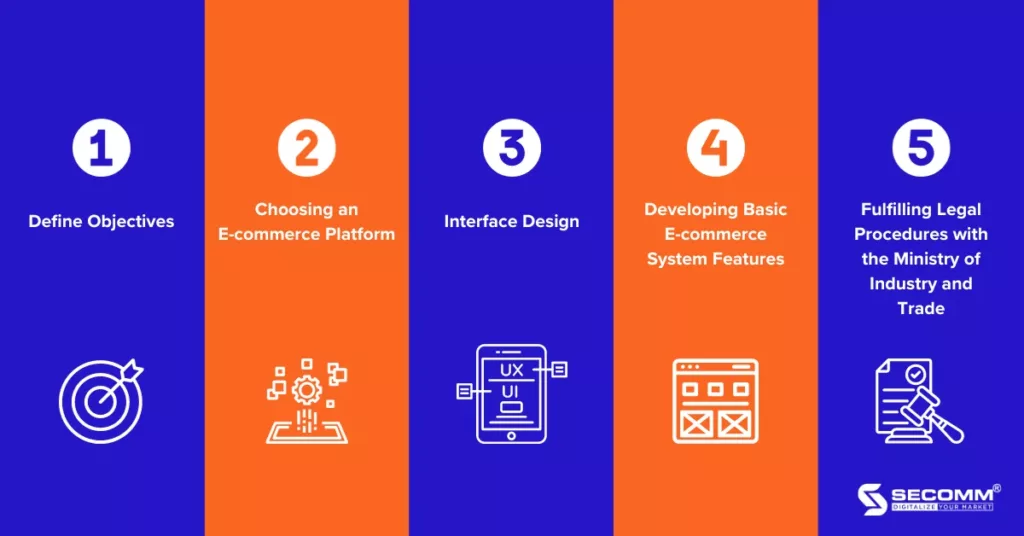
The first step in constructing an e-commerce website is for the business to determine elements such as objectives, budget, and time for project development.
After completing the “ideation” for the e-commerce website, businesses can kickstart the project by purchasing suitable hosting and domain names aligned with the products or services the business intends to offer.
Once the specific business strategy has been identified, the business needs to carefully consider choosing a platform for building the e-commerce website. Currently, the two most popular types of e-commerce platforms are Software as a Service (SaaS) and open-source platforms.
With SaaS platforms, businesses can choose from various pre-designed templates and features to build a website through simple drag-and-drop operations, requiring minimal investment in terms of time and development costs. However, with SaaS platforms, businesses do not own the source code and data; they can only utilize the available features of the platform. The flexibility and scalability of the system are limited, and usage costs may increase over time. Some popular SaaS platforms in Vietnam include Haravan, Shopify, Sapo, etc.
With open-source platforms, businesses have complete freedom to design the interface according to their requirements. These platforms offer high flexibility and can be customized extensively. Open-source platforms provide a full range of features and additional utilities, supporting sustainable development. Businesses own all the source code and data. However, businesses will need a skilled in-house team or experienced development partners to accompany them, investing time and money in development. Some popular open-source platforms include Magento, WooCommerce, OpenCart, etc.
Businesses can initiate the interface design for the website on the selected platform by using existing templates or themes available on the system. Alternatively, they can customize and design a unique interface that aligns with the brand image and specific preferences of the mobile phone retail industry.
At this stage, the business collaborates with an in-house IT team or a deployment unit to establish fundamental eCommerce features, ensuring smooth sales processes on the system. On both SaaS and open-source platforms mentioned earlier, businesses can choose suitable functions and integrate them into the website. Some common basic features include:
A mandatory criterion for the official operation of a business’s eCommerce website is the completion of legal documents following regulations. According to Decree 52/2013/ND-CP by the Government, individuals or organizations owning eCommerce websites for selling goods are required to notify or register with the Ministry of Industry and Trade on the eCommerce Management Portal.
Businesses can either complete the registration process themselves or enlist the services of law firms that provide related services.
Typically, a basic website may only support a business in its initial stages and face challenges as the business model evolves. Businesses gradually realize the need to develop a more specialized eCommerce system to enhance service quality and improve the overall experience for both customers and the business itself. The development of a sophisticated system requires businesses to be more prepared in terms of time and costs compared to the initial phase.
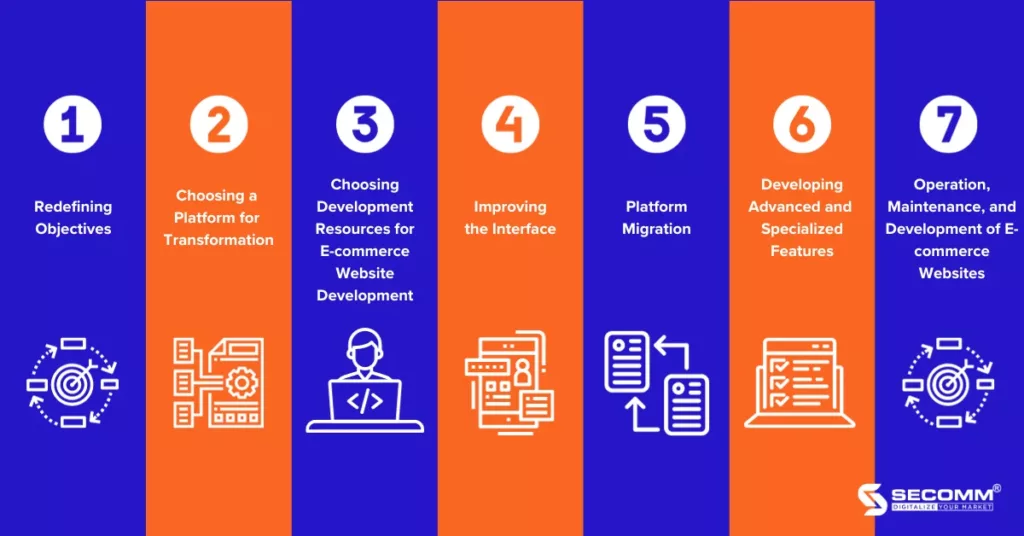
Similar to developing a basic eCommerce system, the first step in developing a sophisticated e-commerce website is for the business to redefine its objectives, costs, and timelines for the project. It is crucial to explore specific features and advancements within the industry. This allows the business to plan a detailed and accurate development strategy that aligns with its business model.
To develop a deep eCommerce system, businesses should opt for open-source platforms such as Magento, WooCommerce, OpenCart, etc. Open-source platforms can best meet the expanding system needs and sustain development alongside the business. However, besides the drawbacks of high development costs and an extended construction period, businesses also need an experienced IT team to effectively utilize these platforms.
Criteria for Platform Selection at This Stage:
Allows the development of a standardised user interface that reflects the brand’s characteristics and showcases product images clearly and cohesively.
Enhances brand identity and differentiation.
The admin interface should be user-friendly, facilitating easy navigation, control, and management of the entire system’s data.
The system should support basic functions and be flexible enough to accommodate the development or integration of advanced and specific features.
This flexibility ensures stable business operations in the long term and the ability to adapt to evolving business models.
Seamless integration with other software without compromising the performance of individual systems.
High scalability to adapt and grow alongside the business, catering to various business models.
Cost-effective long-term budgeting while constructing a sustainable and efficient system suitable for the business.
The ability to expand, whether it’s adding multiple websites, operating in multiple countries, dealing with various currencies, or managing multiple channels.
Ensures the system can efficiently meet the evolving needs of the business.
Can extend to multiple websites, support internationalisation, handle diverse currencies, and manage various sales channels.
Ensures stable system operation regardless of increasing web traffic and transaction volumes over time.
To build a sophisticated eCommerce website, businesses can either establish an in-house team or collaborate with external development partners. In both cases, a skilled and experienced workforce with a professional work ethic is essential.
In-House Team:
External Development Partners:
Recommended Service Providers: Several service providers specialize in deploying advanced eCommerce systems. Some notable examples include SECOMM, SmartOSC, Co-Well Asia, Isobar, and Magenest.
Choosing between an in-house team and external partners depends on the business’s specific needs, resources, and preferences. Each option has its advantages and challenges, and businesses must carefully evaluate their circumstances before making a decision.
While transitioning to a new eCommerce platform, businesses have the flexibility to retain their current website interface or redesign it for an enhanced user experience and improved brand positioning. Redesigning involves adjusting existing themes to save time and budget. However, some businesses opt for a custom redesign to meticulously tailor the interface to their specific needs, which may require a higher investment in terms of time and budget.
Platform migration is a crucial step in building a deep eCommerce website. Automation is typically used to minimize errors during the transition. Businesses need a comprehensive plan encompassing features, data, and scenarios to ensure a smooth and effective transition. The process begins with data extraction from the old system and recording it into the new system.
Post-migration, thorough testing is essential to verify that all components and data have been accurately and adequately transferred according to the plan.
When constructing a deep eCommerce website, businesses must introduce advanced and specialized features to support business model expansion, enhance competitiveness, adapt to market changes, increase revenue, and improve the shopping experience. Some advanced features for eCommerce and mobile retail may include Buy Now Pay Later, Flash Sales, and advanced product search functionalities.
Continuous learning and staying informed about necessary features are crucial for system development. This can be achieved through online applications, an in-house development team, or external development experts. After outlining the development plan, collaboration with design experts to create a system model is essential. The subsequent step involves programming features based on the approved plan. Before deployment, thorough testing, based on the requirements specification document, is conducted to update test scenarios and log errors using error management tools.
After developing an eCommerce website, regular maintenance, care, and updates are necessary to ensure continuous online business operation, seamless system operation from online to offline, and optimal user satisfaction. Ongoing research is vital to optimize and develop the website to create a satisfying and comfortable shopping experience.
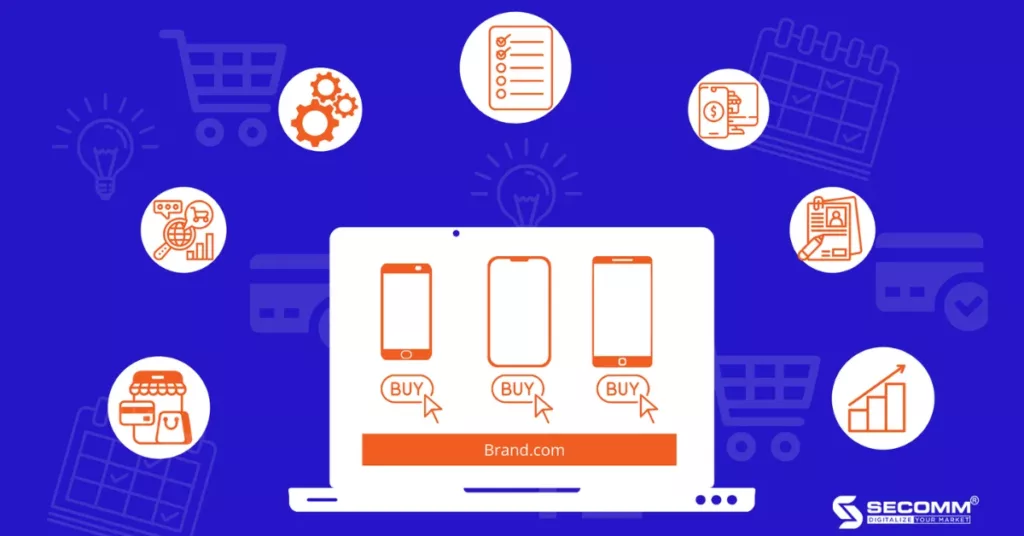
In summary, a comprehensive eCommerce website is crucial for the current and future success of mobile phone retail businesses. Building such a website involves a meticulous process, and each step is critical. Businesses can contact SECOMM for free consultations on comprehensive eCommerce website solutions tailored to mobile phone retail businesses.
 2
2
 12,125
12,125
 0
0
 1
1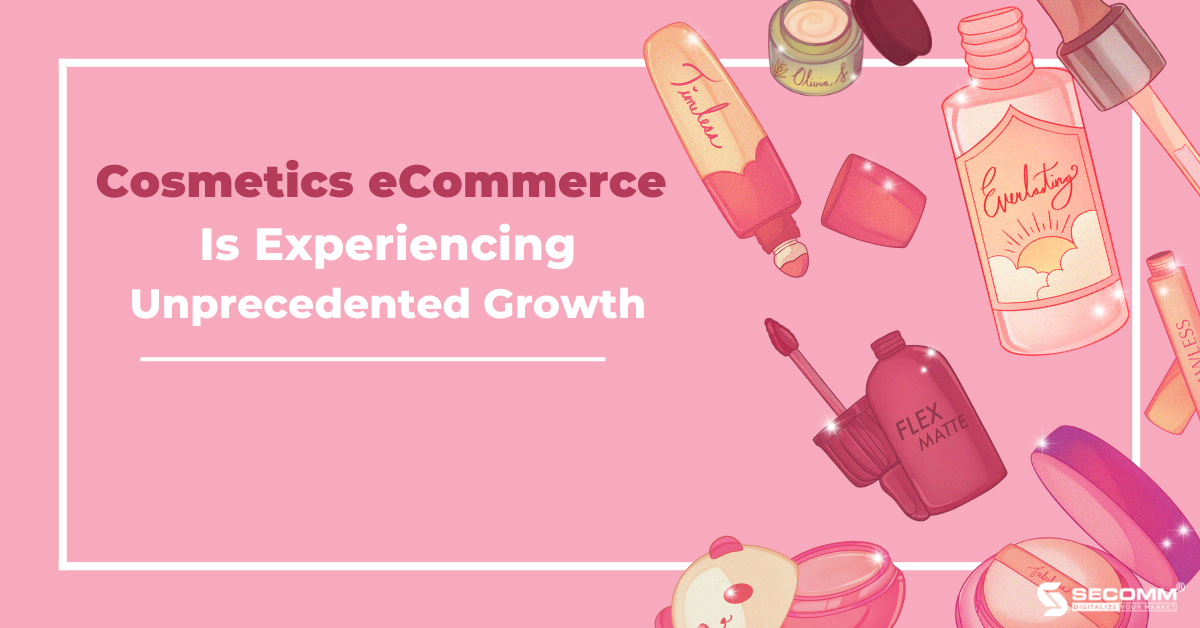
Consumer demand for beauty and health care is rising as the quality of life gradually improves. The fact that so many individuals are involved in commerce has also contributed to the cosmetics industry’s reputation as one of the most important sectors in the modern economy.
Additionally, the rapid growth of eCommerce following the pandemic is gradually emerging as a successful business strategy and a crucial step in the digital transformation of every industry, including the cosmetics industry.
The market size for cosmetics sold online is estimated by CommonThread to be $483 billion in 2020 and expand to $511 billion in 2021 at a compound annual growth rate (CAGR) of 4.75%. The market size is anticipated to surpass 716 billion USD by 2025 and reach 784.6 billion USD by 2027.
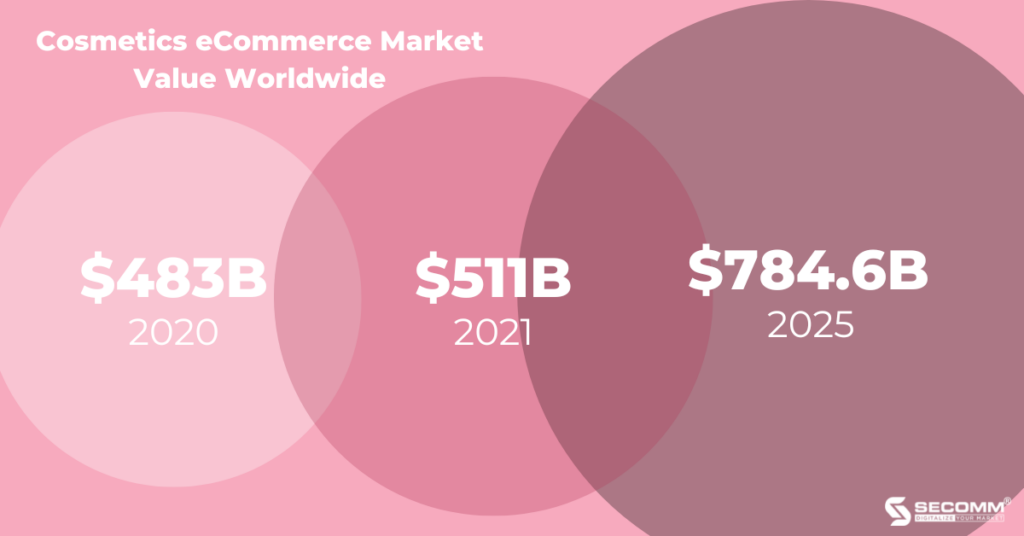
In the past pandemic years, the global economy has witnessed a sudden decline in sales in many industries, including the cosmetics industry.
People are compelled to reduce their social interactions while social distancing mechanisms are in effect.
At this time, people’s psychology will be more concerned with keeping an eye on and caring for themselves. Due to the unpredictable changes of the pandemic, there has been a sharp rise in the need for skincare, hair care, and body care products to enhance spiritual life.
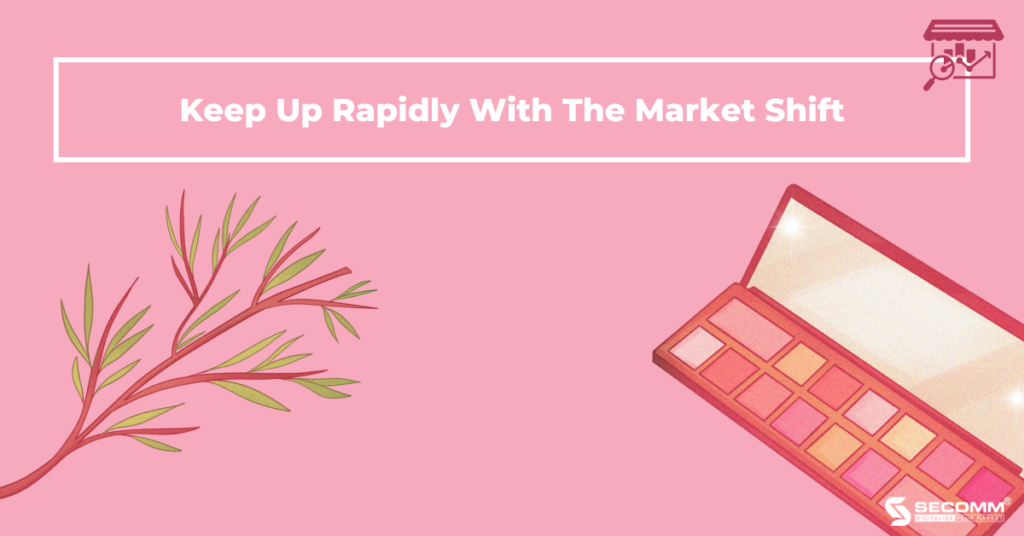
Due to restrictions on leaving the house, online shopping at the time had become not only a need but also an urgent method of purchasing in place of in-person purchases. That serves as a springboard for eCommerce to take off and spur significant growth in other industries like fashion, grocery, wine, and even cosmetics.
These two elements highlight the enormous potential of this “cake,” assisting several cosmetic companies in realizing and swiftly implementing eCommerce for both sustainable development and market revolution.
Using eCommerce as a solution will allow the cosmetics industry to shift from offline to online (O2O) business models rather than allowing their businesses to “get lost” in the crisis of the global pandemic.
Additionally, if businesses still do not have a competent eCommerce website to introduce and sell products to customers who love to shop online in the age of digital transformation, they will quickly lose many potential customers to rivals.

This is especially true for a highly competitive industry like cosmetics, but several firms, including Hasaki, LixiBox, Watsons, Guardian, etc., have embraced the trend early and are now the market leaders in cosmetic eCommerce.
Furthermore, early eCommerce development will also provide benefits that will make marketing efforts more successful, broadening the economic opportunities for businesses.
Businesses must consider customers’ purchasing experiences when launching eCommerce websites, and not just for the cosmetic industry.
Thanks to the use of contemporary technologies, which are quite popular in the cosmetics industry, the purchasing procedure will be swift, and effective, and bring customers satisfaction when they choose to buy cosmetics online.
For example, a 360-degree intuitive vision, virtual reality (VR), or augmented reality (AR) technology (AR).
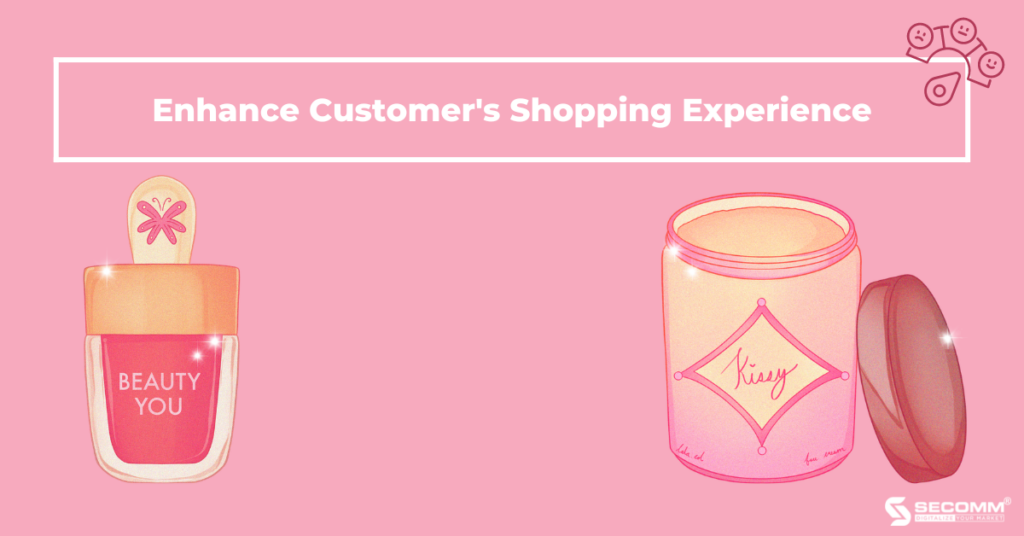
eCommerce enables businesses to quickly and effortlessly tailor the experience for customers by gathering, evaluating, and synthesizing the consumption behavior of each target group. Typically, this is done with the capabilities listed below: Products have seen, similar product recommendations, etc.
eCommerce provides clients with a seamless experience in addition to an intuitive one across a variety of channels, including social networks (Facebook, Instagram, Tiktok, Zalo, etc.), eCommerce platforms (Shopee, Lazada, Tiki, Sendo, etc.), eCommerce websites, mobile apps, etc.
One of the most successful cosmetic brands that has a significant global media impact is Kylie Cosmetics. When it comes to Kylie Cosmetics, it’s tough not to give Kylie Jenner credit.
She’s the youngest female millionaire in the US and has been hailed as a business genius by prominent publications like Forbes due to her success in the saturated cosmetics industry.
When Kylie Cosmetics was founded in 2015, it generated an astonishing $ 420 million in revenue in its first 18 months. It is predicted that by 2022, net sales will have reached $ 1 billion.
The sensible business strategy, in addition to the founder’s reputation, focuses on utilizing the “gold mine” of eCommerce and launching social media marketing campaigns, which are the factors that contribute to that respectable revenue block.
As a result, the company used Shopify, a platform that specializes in creating websites for the top online retailers in North America, to develop its eCommerce website.
With pink and white as its primary colors, the website’s design is incredibly clean and uncomplicated. The layout of the website centers on showcasing the company’s products.
Also, this is a part of Kylie Cosmetics’ business strategy, which includes releasing collections of cosmetic products like lipsticks, eyeshadow, and eyebrow pencils with limited design and manufacturing to appeal to customers’ FOMO (Fear of Missing Out).
It is not surprising that Kylie’s new collections or cosmetics Cosmetics are continually “sold out” every time it is published because this is thought to be a very intelligent strategy of Kylie Cosmetics, completely different from other well-known cosmetic firms.

The business also utilizes social media platforms that are hugely popular in the US, like Instagram, Youtube, and Snapchat, to create content to market brands and products and engage with a huge audience across three platforms before driving traffic to the eCommerce website and generating conversions.
The company’s inventiveness and innovation are also on display in offline events that draw customers to free product samples. Here, the company wins over even customers who have reservations about the product’s quality, which greatly increases sales.
Since Kylie Cosmetics established its first traditional cosmetic retail store in 2018, customers may now purchase cosmetics from this cult brand at Ulta Beauty locations around the US.
Indeed, Kylie Cosmetics started off quite shrewdly and went on to tremendous success by keeping up with market changes by building an online business model at first, that is, selling through an eCommerce website and relying primarily on social media for promotion.
Since entering the Vietnamese market in 2011, Guardian has grown to be a very well-known and recognizable brand among consumers of cosmetics. This brand is a part of the Dairy Farm Group, a company that manufactures and distributes health and beauty products in Asia.
Since its start, Guardian has made ongoing improvements to encourage millions of followers to lead healthy lifestyles and offer a trustworthy, high-quality purchasing experience at the finest rates and services.
With a system of more than 100 outlets “encompassing everywhere,” this retail chain is delighted to be a place to shop for cosmetics “for everyone” who can “purchase everything” and simply select appropriate items.
A clever business strategy and significant investment in successful marketing efforts are the only explanations needed to understand Guardian’s success.
When first entering the Vietnamese market, Guardian specifically pushed to quickly expand its business chain, focusing on cities with high purchasing power, with 80% of stores located in Ho Chi Minh City, the rest in Hanoi and some other major cities such as Da Nang, Can Tho, Bien Hoa, and Vung Tau.
Because at the time, online channels were not really well-known and powerful enough for this business to keep an eye on.
As a result, the company successfully raises the level of brand recognition with extensive coverage from the Guardian orange white wave, taking into account the characteristics of the cosmetics and beauty care industry, which require customers to have a direct point of contact, learn from, and test.
By 2019, the company began its journey toward digital transformation by combining offline and online (O2O) business models in parallel, and simultaneously, deploying Omnichannel.

It is even more critical for Guardian to immediately implement potential sales channels like marketplaces, applications, fast delivery services like GrabMart, and eCommerce website operate side by side with a chain of 105 retail outlets in strategic locations due to the pandemic’s dual effects, which include changing market trends and altering consumer buying habits.
The orange and white colors and quick page loads make the Guardian website’s design stunning. Additionally, Guardian offers enticing incentives in the shipping policy, such as free fast delivery within 4 hours with orders from 349,000 VND, to encourage online shoppers.
The company’s unique product catalog, which is prominently shown on Guardian’s eCommerce website and features items like shampoos, shower gels, and hand sanitizers, is another standout.
The foundation for helping Guardian dominate the cosmetic retail market and leave a lasting impact on customers is a deliberate investment in developing a multi-channel ecosystem.
Modernity and growth come with invisible pressures that have an impact on everyone’s life as people struggle to keep up with the “standards” of the times.
However, that does not result in a drop in the demand for beauty and self-care, on the contrary, it is always rising, with a diversity of sufficient options to match customer expectations.
Vietnamese women are among the most beautiful in Asia, but, due to the responsibilities of work pressure and family, they occasionally neglect to care for and love themselves.
Because of this, Hasaki Beauty & Clinic was established with the desire to become a reliable beauty and spiritual care destination for Vietnamese women.
The Hasaki store system, which was introduced in 2016 and now has 76 locations across 29 Vietnamese provinces and cities, has steadily established itself as one of the top retail chains for real cosmetics. Hasaki is dedicated to offering real cosmetics at discounted pricing, living up to its motto of “True Quality – True Value”.
Along with system expansion, Hasaki also works on creating an eCommerce website with features appropriate for the cosmetics industry and always enhancing and upgrading the system to provide customers with the greatest online shopping experience.

The Magento platform was used to build the website, and the interface is attractive with green serving as the primary color tone for the entire eCommerce website and app system. Customers can check current promotions and conveniently look up order details when accessing the Hasaki website.
Additionally, the “handbook” section at Hasaki has a wealth of knowledge on cosmetics and skin care tips that each customer may learn and arm themselves with before making a purchase decision. Since then, the process of beauty restoration is safe and effective.
Similar to Guardian, Hasaki encourages people to order online with NowFree 2h and take advantage of free shipping rules.
As a result, Hasaki will provide free delivery to customers within two hours of receiving orders of 90,000 VND in 29 provinces and cities where the company has locations, including on Saturday and Sunday. Customers will benefit from free national shipping on orders that are at least 249,000 VND.
Therefore, Hasaki has sparked a “green craze” among many beauty fans and is now gradually competing with the country’s top cosmetics brands thanks to its quick recognition of market trends and broad perspective with an efficient marketing mix strategy.
It is clear that the growth of the furniture market has been hastened by the speed at which eCommerce is developing.
Today, numerous local and international cosmetics companies participate in and offer the greatest shopping experiences to customers through the effective implementation of an eCommerce website, including Kylie Cosmetics (USA), Guardian, and Hasaki (Vietnam).
From there, companies may quickly connect with a wider pool of Internet users and generate conversions through efficient marketing strategies.
However, business leaders need to carefully and comprehensively take into account the growing customer expectations and rapidly shifting market trends, not to mention specifically describe a systematic and precise business strategy for taking the most advantageous actions in the short and long term.
Completing that difficult task will take a lot of time and resources. As a result, many cosmetics companies opt for a more straightforward approach to the issue, enlisting the assistance of a highly qualified and dependable unit.
SECOMM has many years of expertise in effectively executing eCommerce for numerous customers in various countries. We specialize in offering free consultation services with qualified eCommerce implementation solutions.
Contact us right away for free counsel and assistance.
 2
2
 4,947
4,947
 0
0
 1
1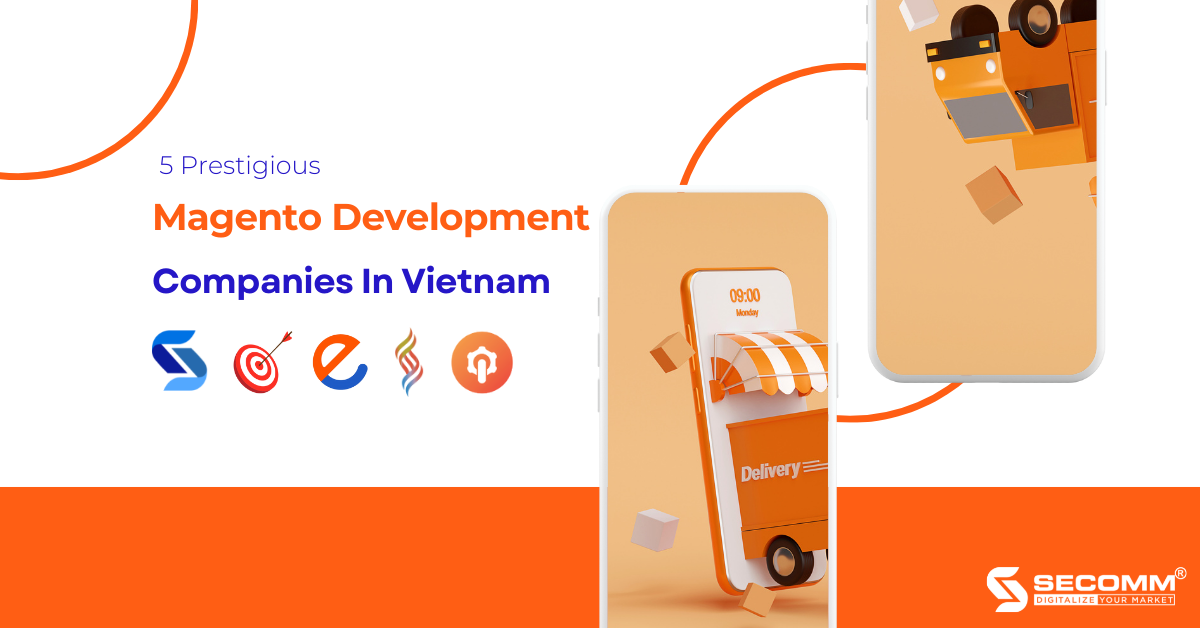
The vast and competitive eCommerce sector is witnessing the constant entry of all-sized businesses, making it challenging for many “nascent” companies to prosper in a billion-dollar market that is seen as the domain of technology giants.
Therefore, creating a professional eCommerce website is a crucial objective for new enterprises looking to take the first steps firmly, quickly dominate the market, and follow the success of the big guys.
As a result, Magento is one of the best options to consider when establishing an eCommerce website to ensure that the process is carried out successfully. It can be difficult to find a partner with strong IT skills and Magento platform development experience.
The list below details the top 5 leading Magento development companies in Vietnam that businesses can refer to make the best choice.
One of the leading consulting companies providing solutions to develop eCommerce websites with the Magento platform and Omnichannel (Omnichannel) is Kyanon Digital. through many years of operation steadily established itself as a trustworthy technology partner of many major retail groups in the Asia-Pacific region thanks to its team of qualified experts.

Magenest is a longtime technology solutions partner based in Vietnam and a leading partner of Adobe Magento, Odoo ERP, Salesforce, AWS, and Google Cloud Platform.
The company specializes in providing comprehensive hosting services and eCommerce implementation and providing package solutions in line with market trends to promote the business activities of partner businesses.
Magenest strives to support brands in achieving their goals of developing eCommerce websites with Magento. Magenest has a solid technical and consulting experience from over 30 certified consultants and developers.

BSS Commerce is an Adobe Solution Partner that provides proper Magento-related eCommerce solutions to businesses throughout the world.
The business has serviced more than 22,000 customers worldwide since its foundation in 2012, accomplished more than 500 projects, and earned the greatest level of customer satisfaction.

SECOMM is another well-known eCommerce website developer in Vietnam that is well-regarded by customers for the excellence of its work and service.
This business specializes in eCommerce consulting and offers a wide range of services, including site development, maintenance, and upgrades on platforms including Magento.
Since its establishment in 2014, SECOMM has worked with major local and foreign clients like LayByLand, Trentham Estate, An Nam Group, and others to implement eCommerce websites on the Magento platform effectively.
By simplifying all eCommerce activities, SECOMM is confident to be a reliable companion in the comprehensive digital transformation journey of businesses in Vietnam and globally.

AgileTech is a top software outsourcing company in Vietnam that has a team of experienced Magento developers who specialise in creating and maintaining high-performance E-Commerce websites.
The company is constantly up-to-date on the latest Magento features and developments, and they use this knowledge to create websites that are scalable, secure, and user-friendly during their 8-year establishment. AgileTech is committed to providing clients with the best possible Magento development experience.

It is evident that eCommerce implementation offers businesses many advantages for entering and dominating the industry. The top 5 support firms for creating and developing eCommerce websites on the Magento platform that companies can rely on are listed above.
 2
2
 2,955
2,955
 0
0
 1
1Subscribe to get the latest eBook!
Hotline